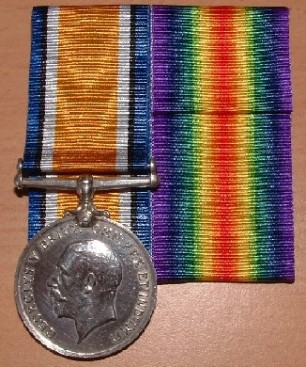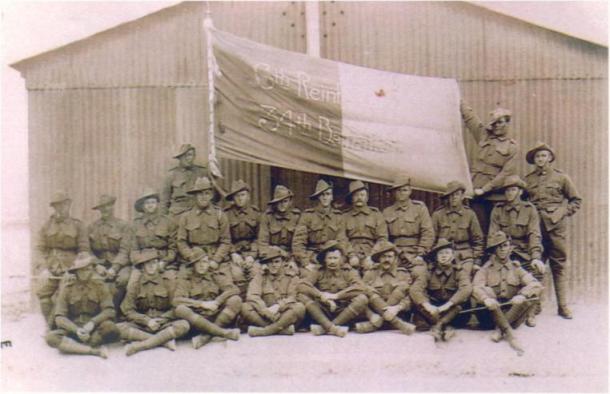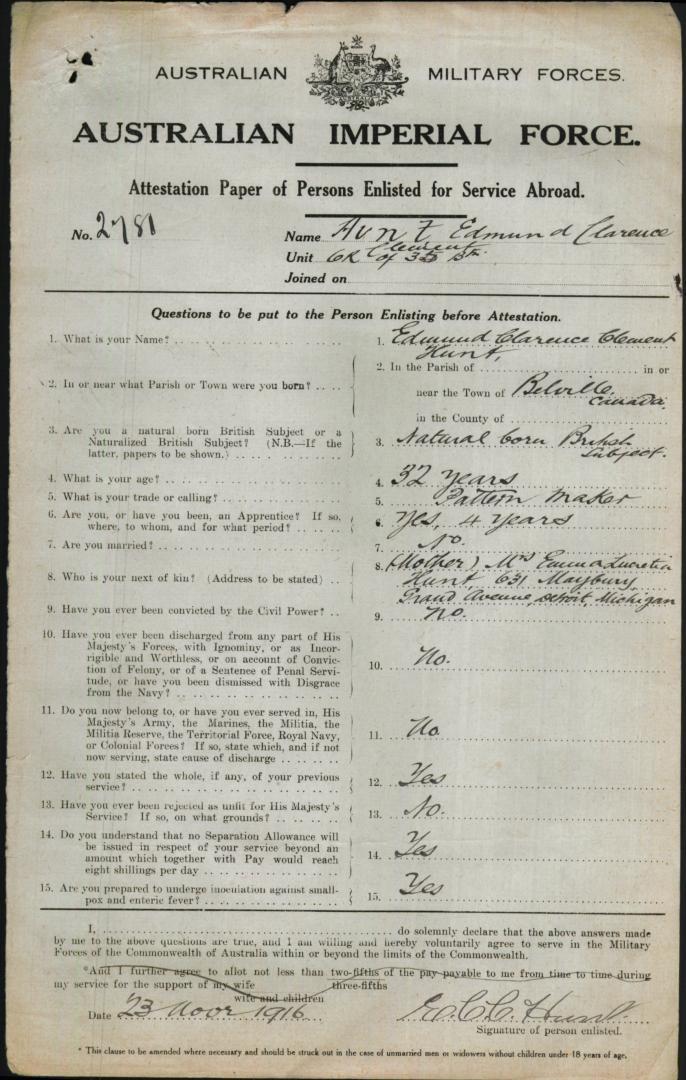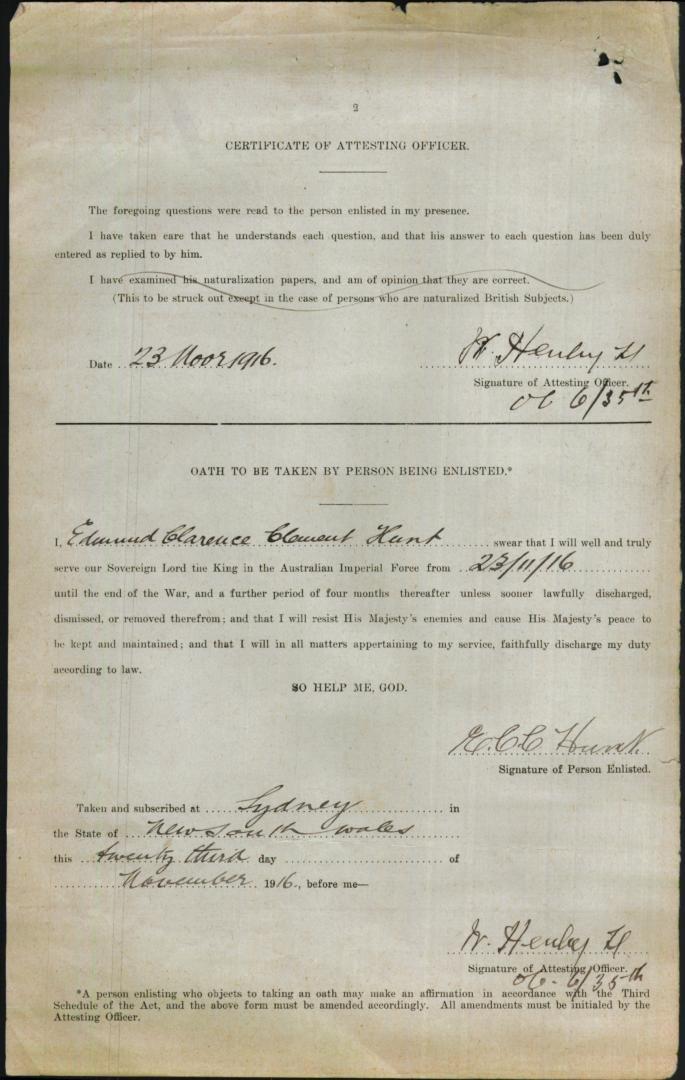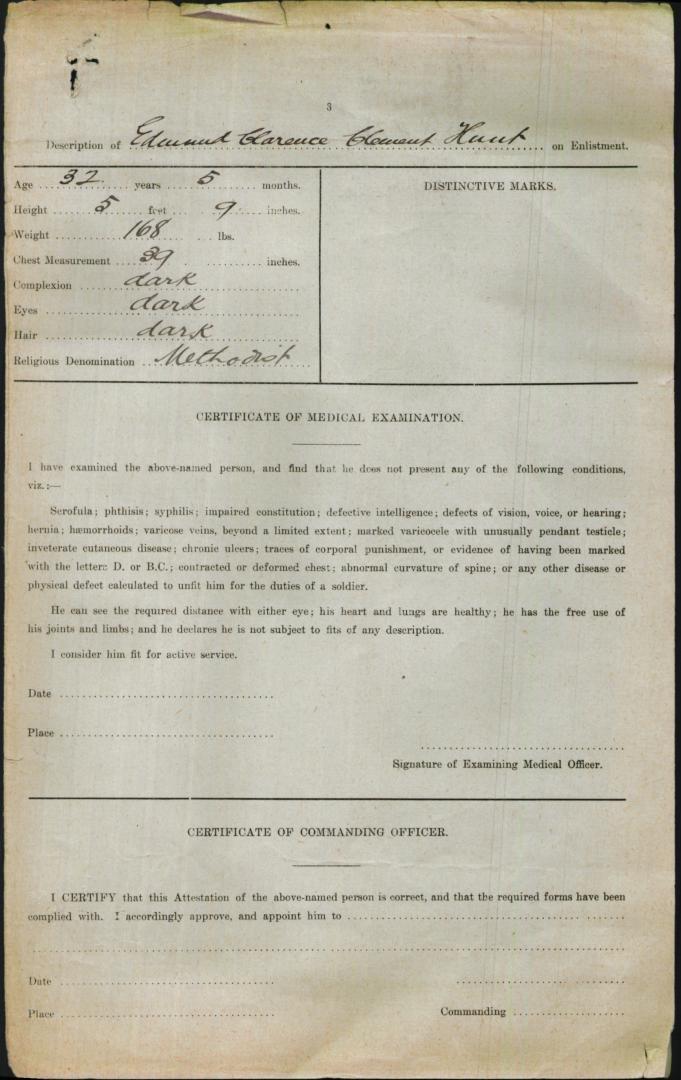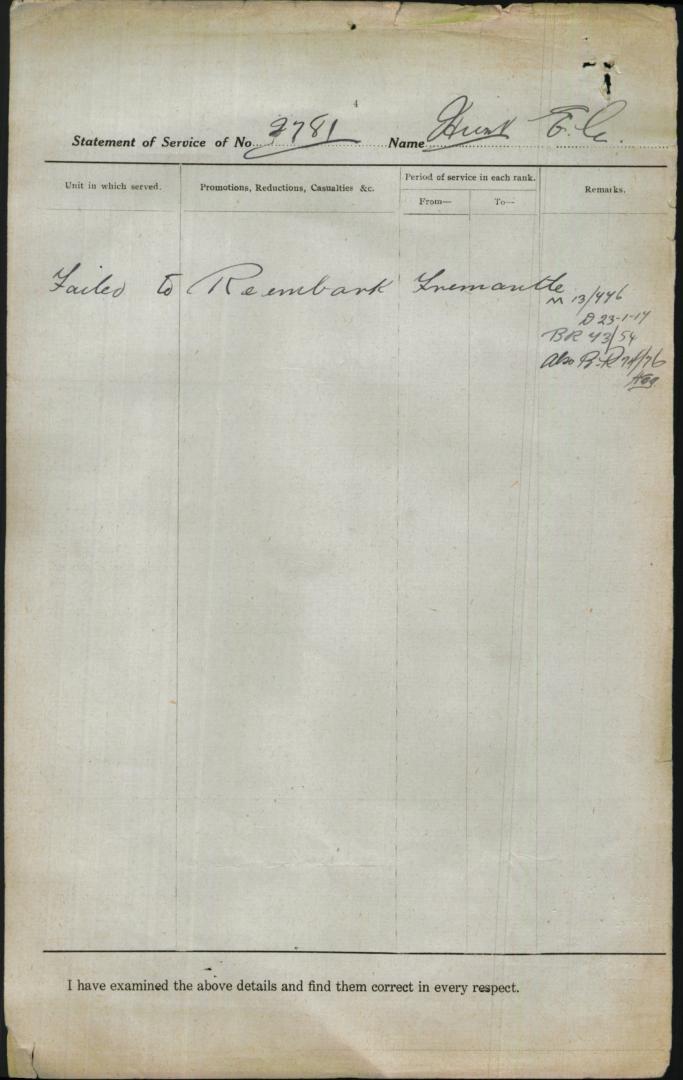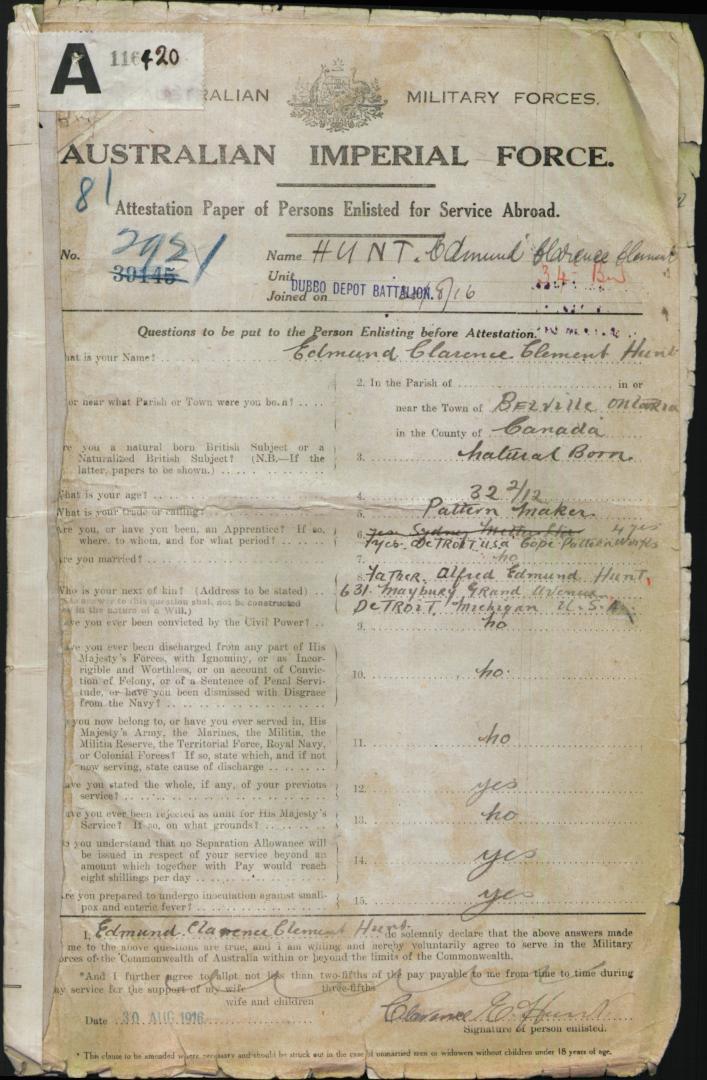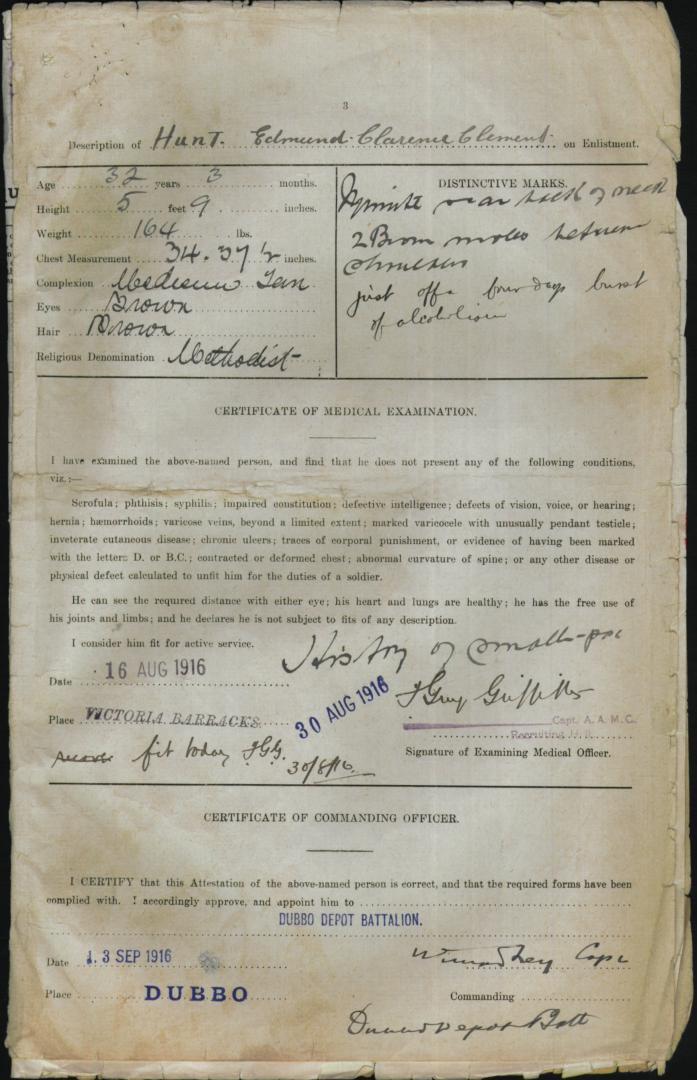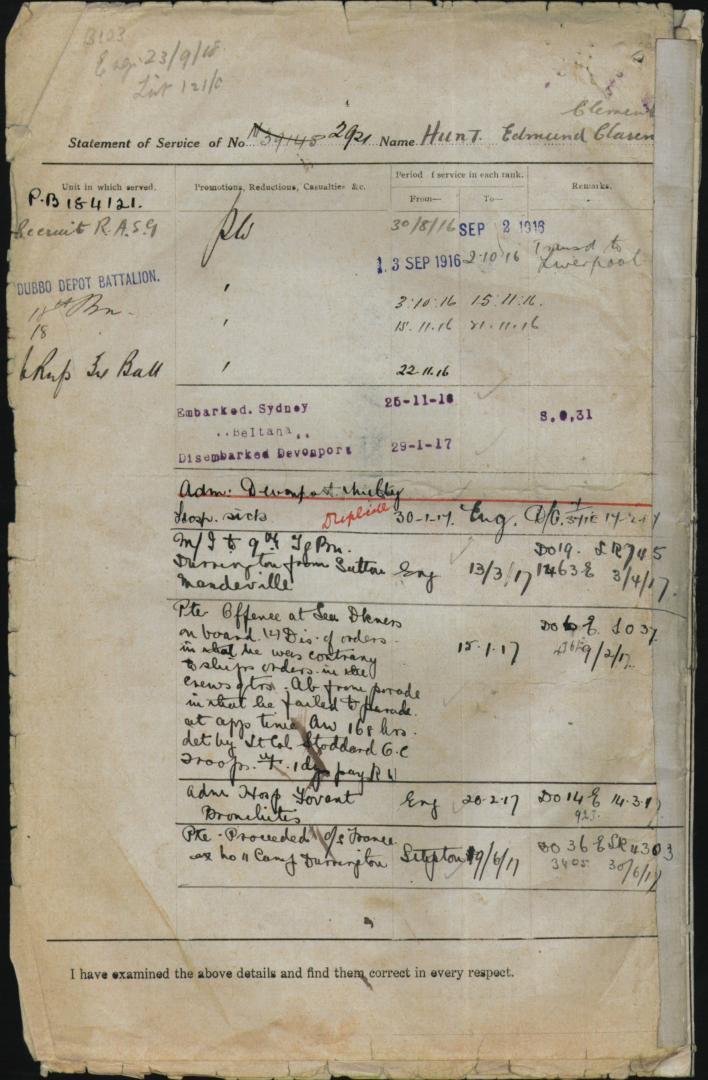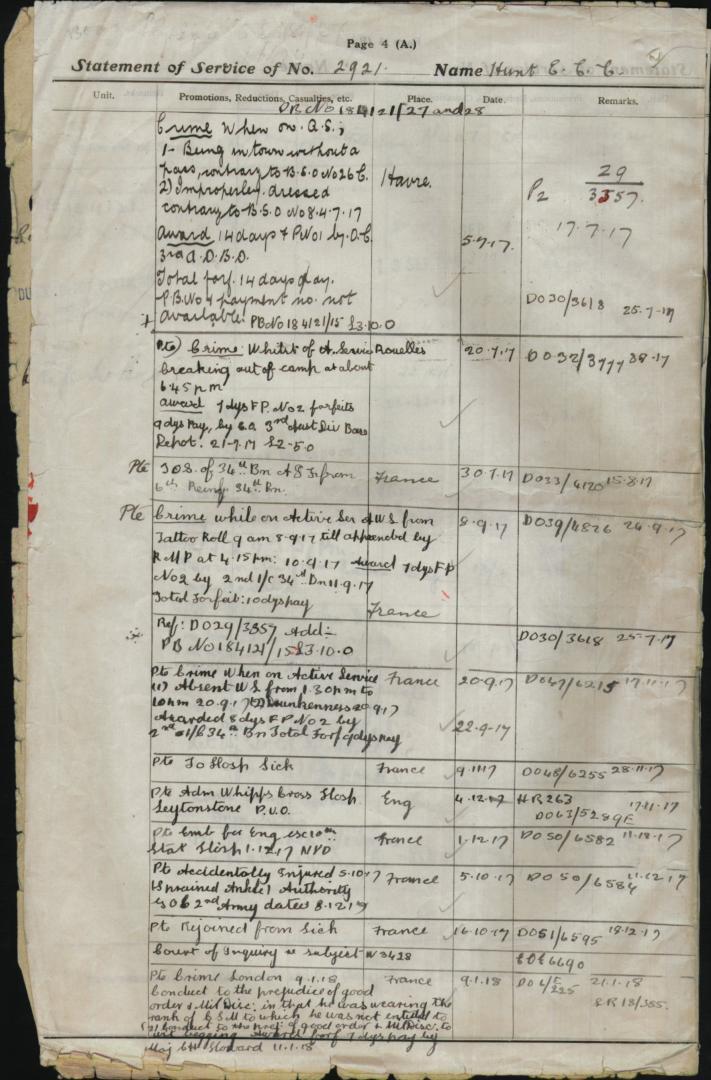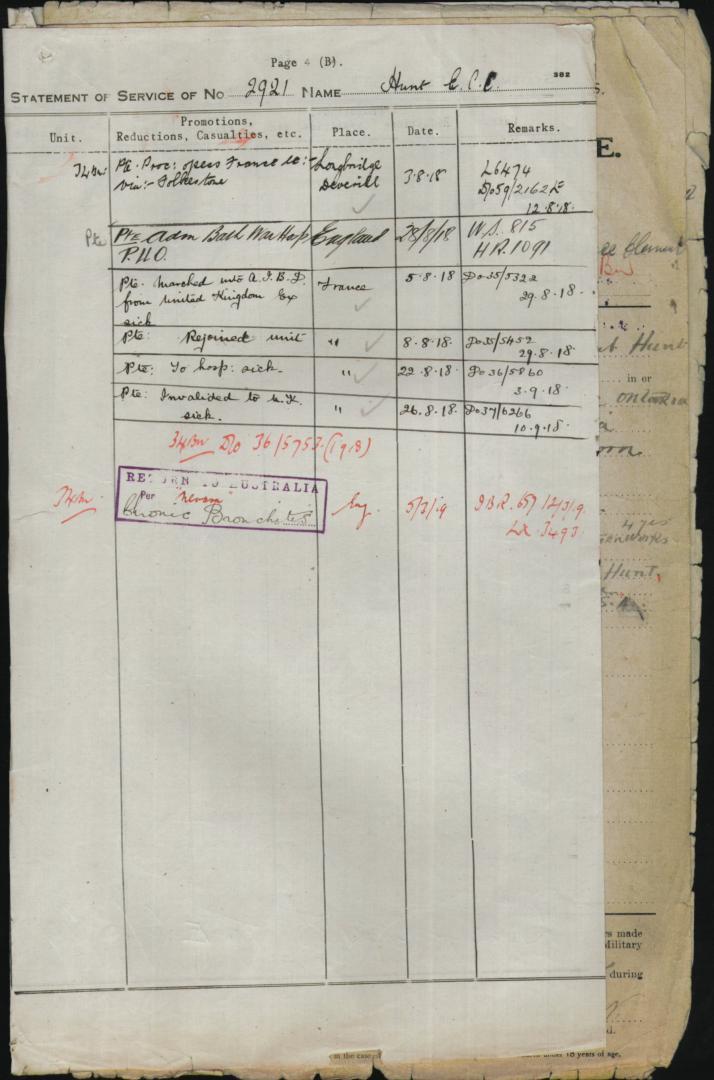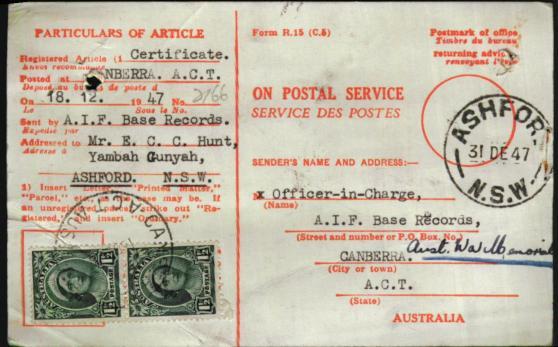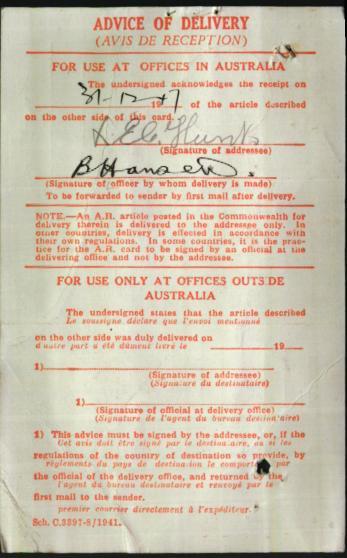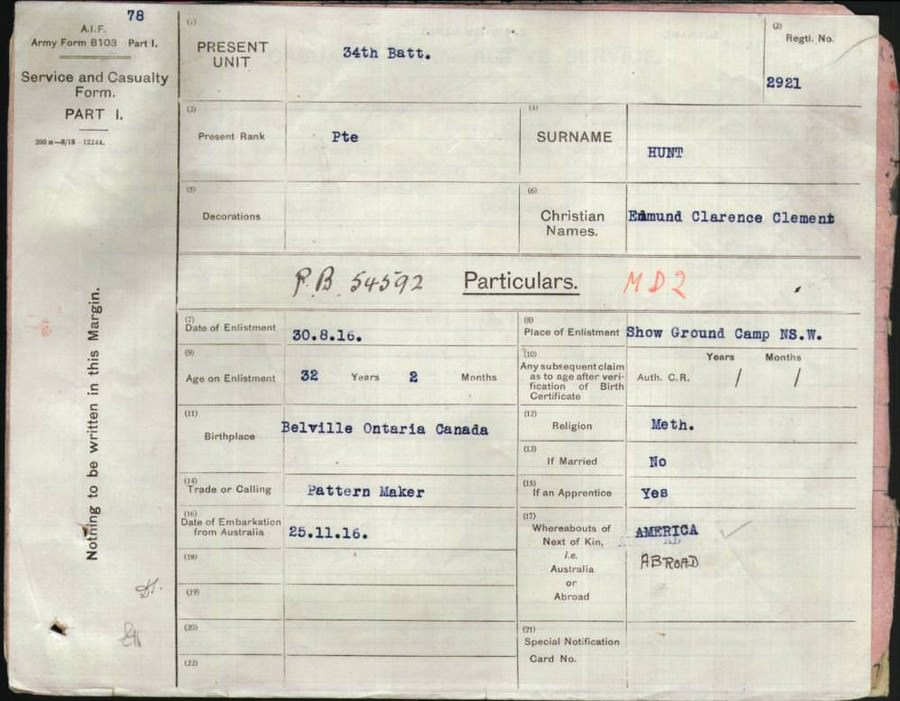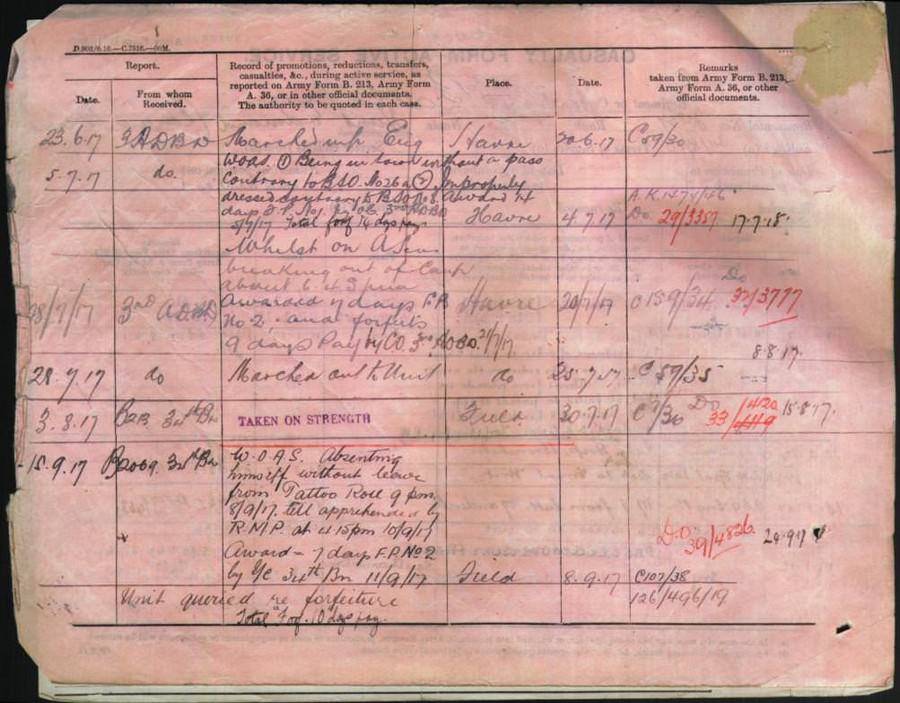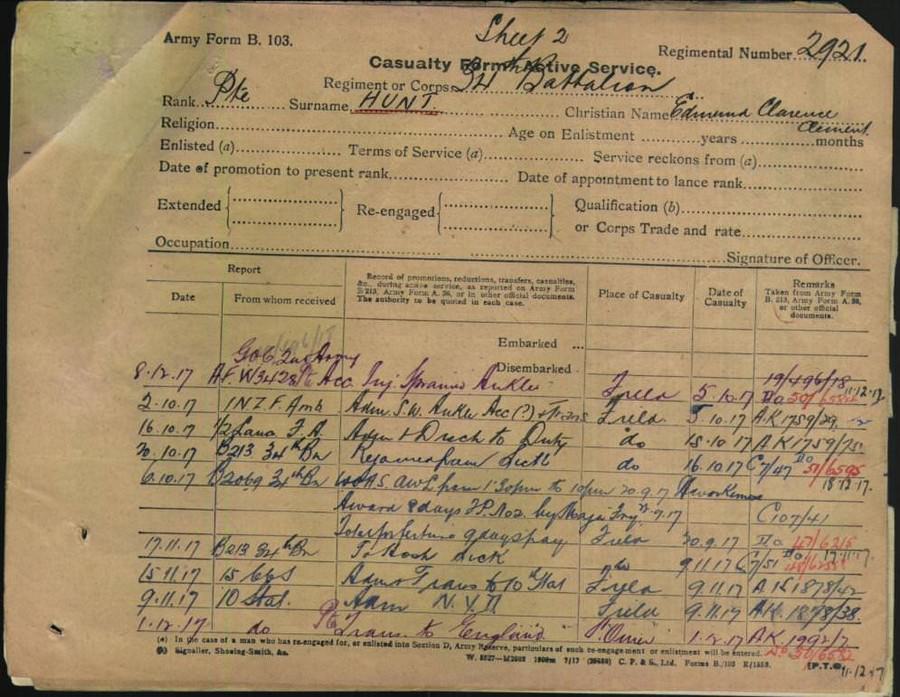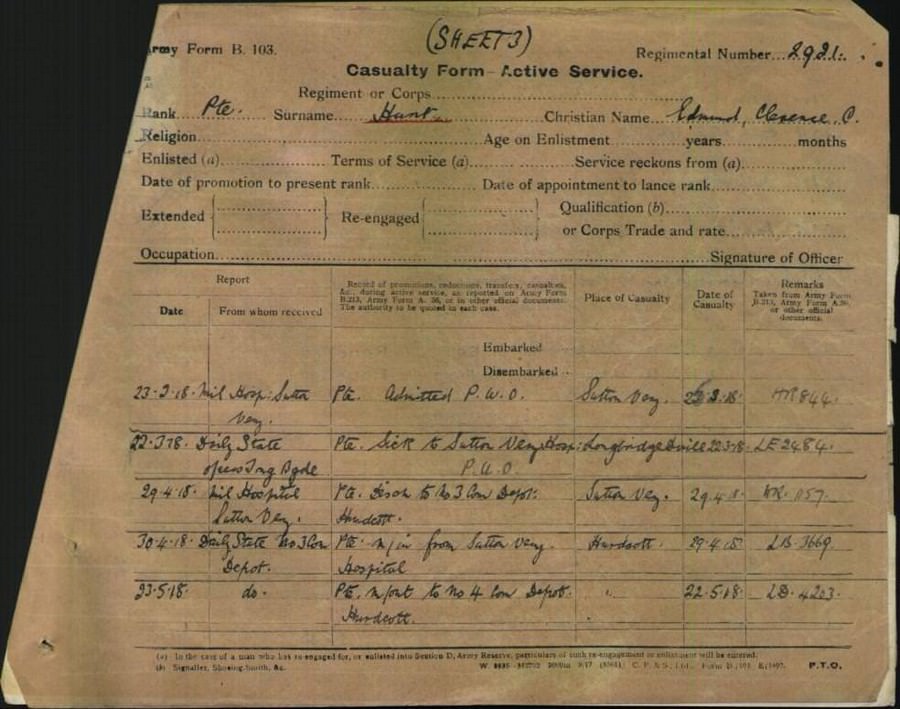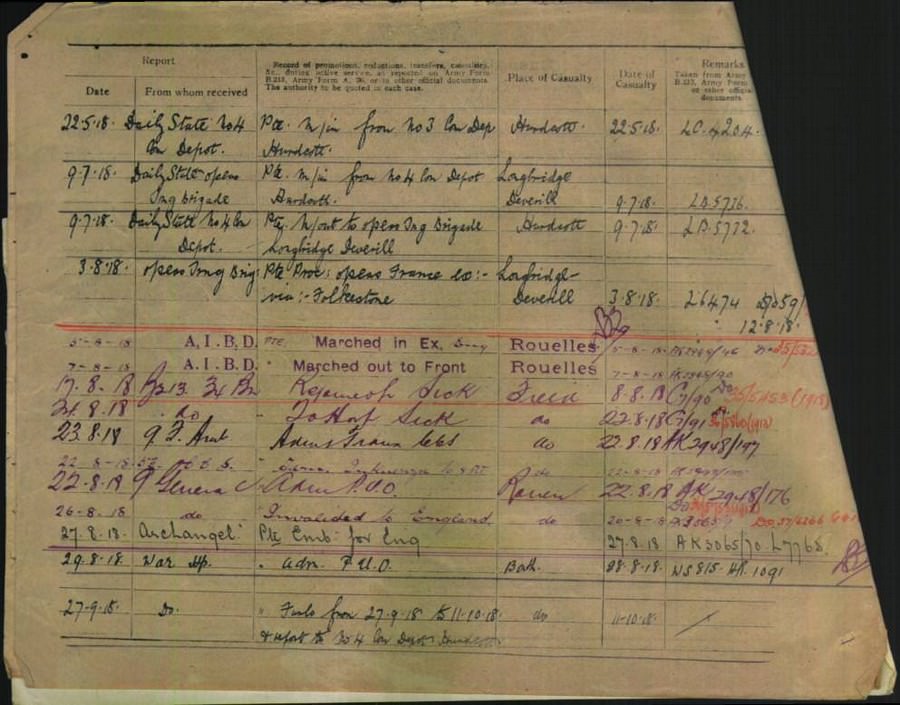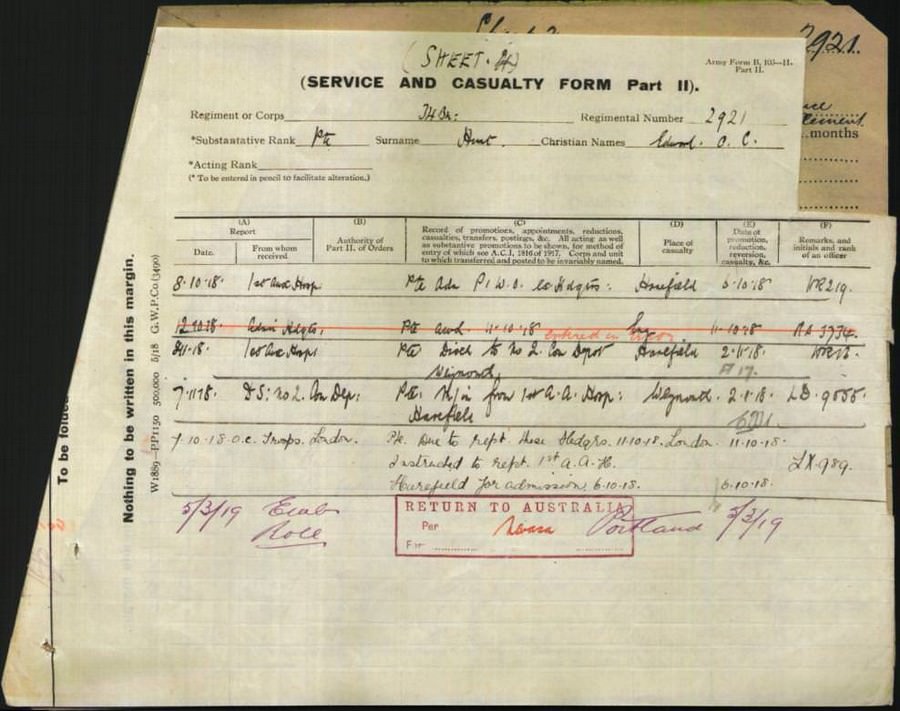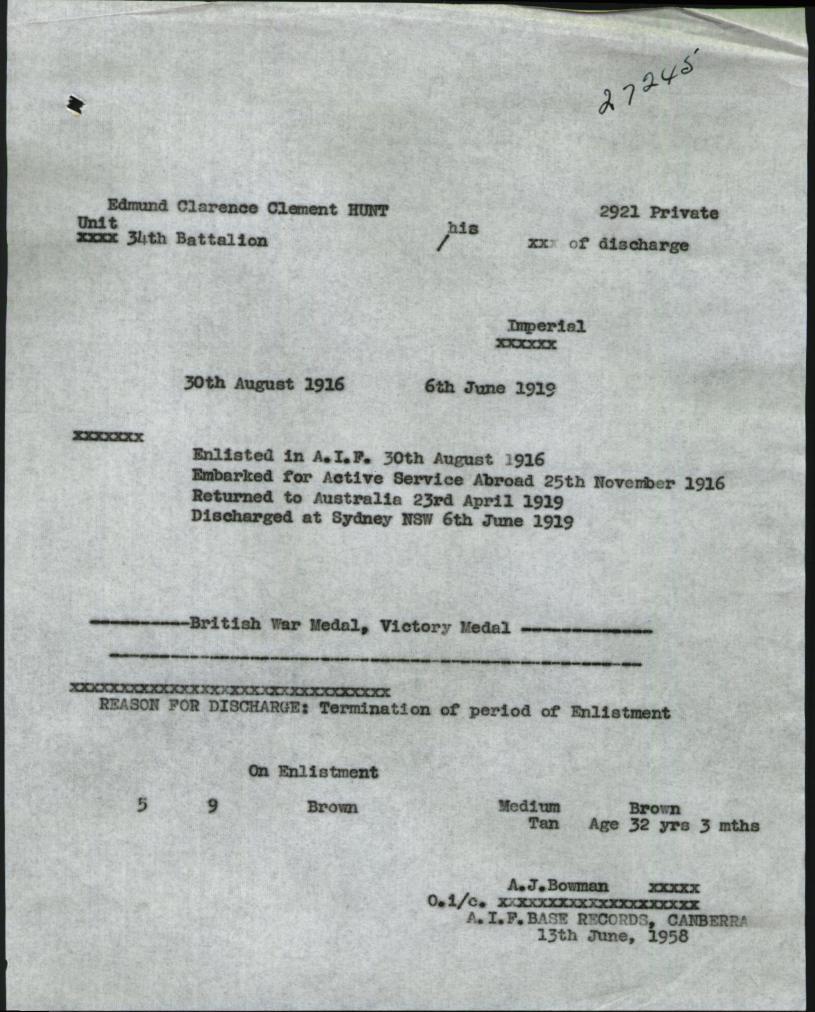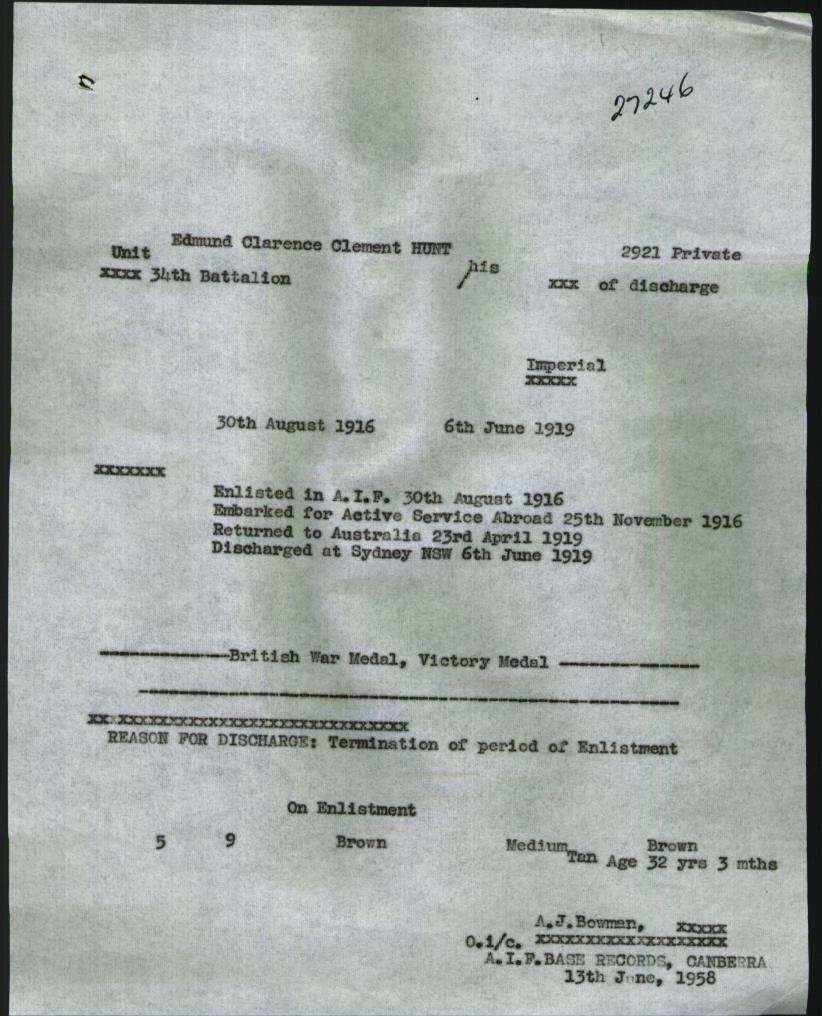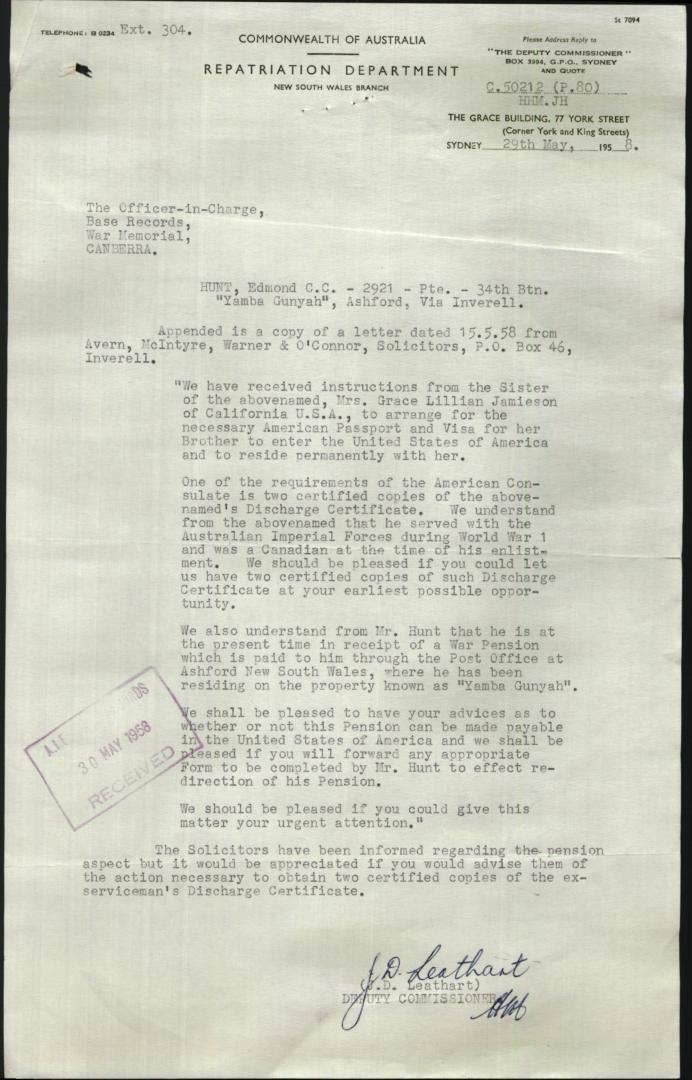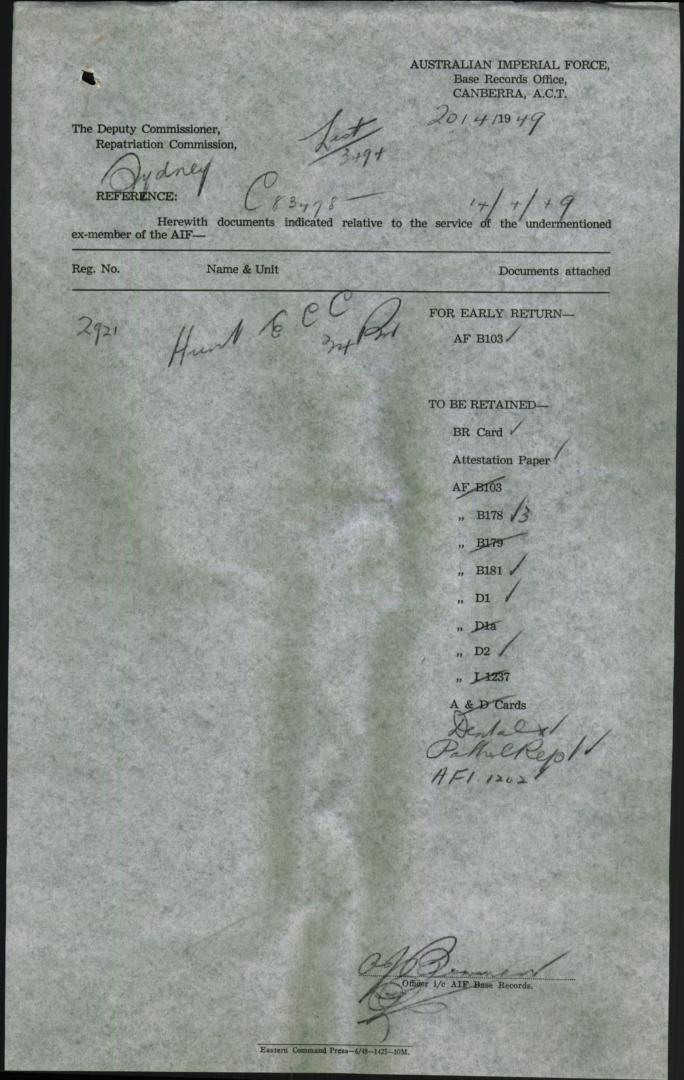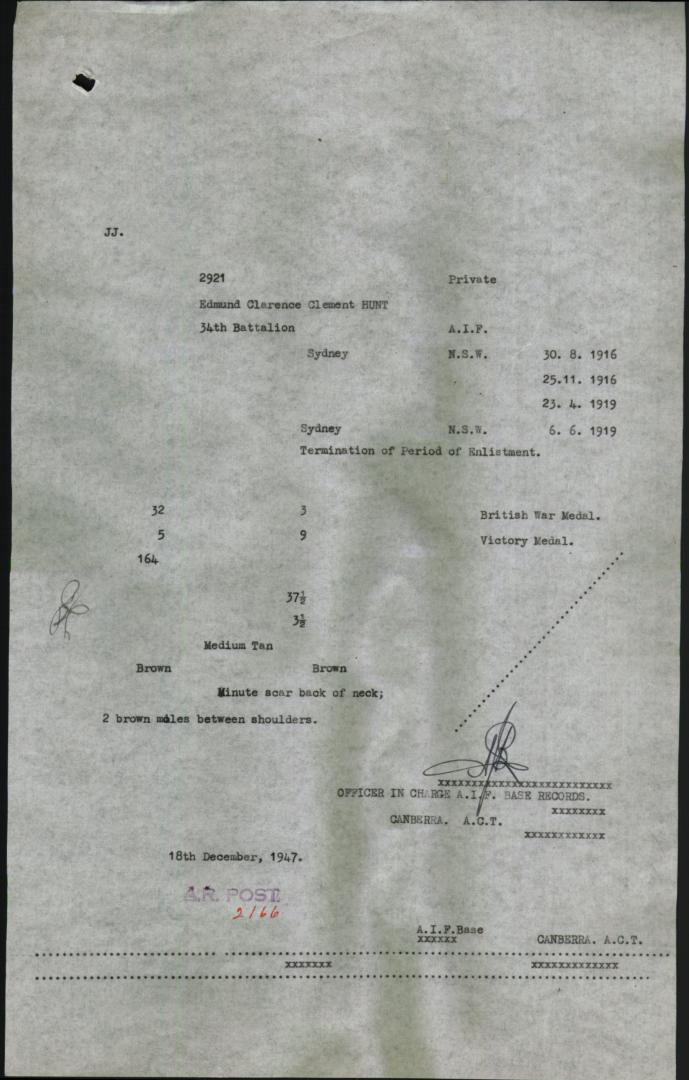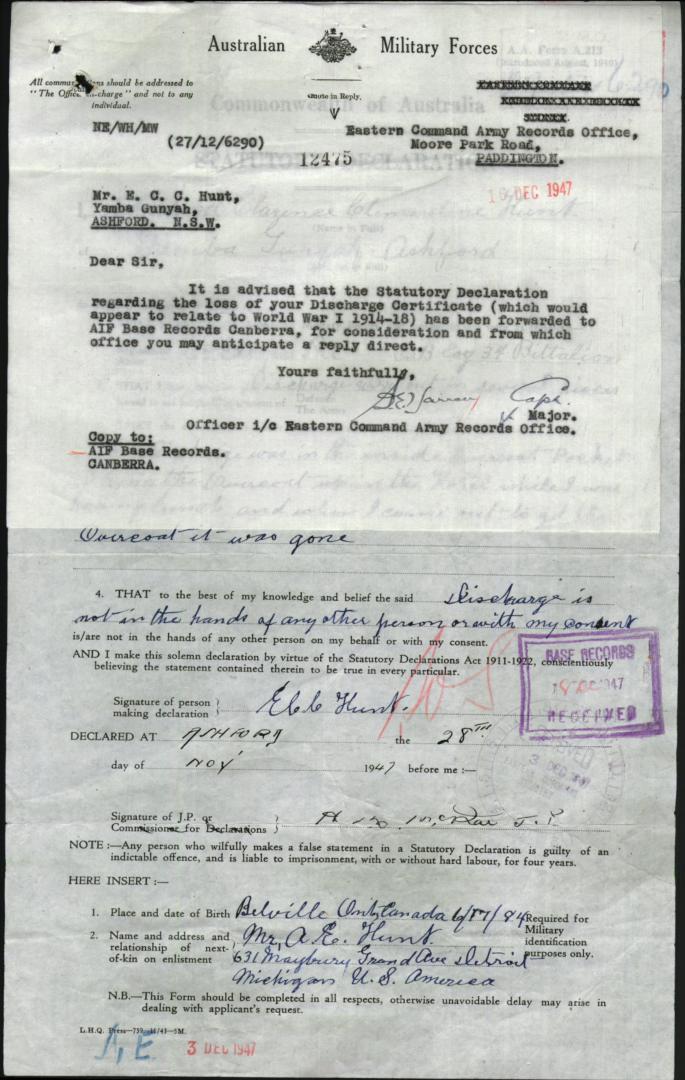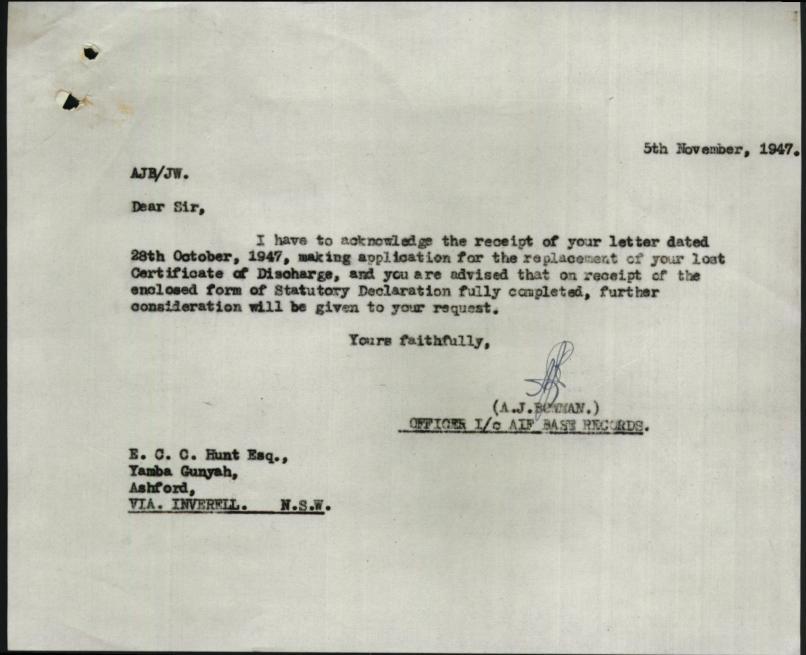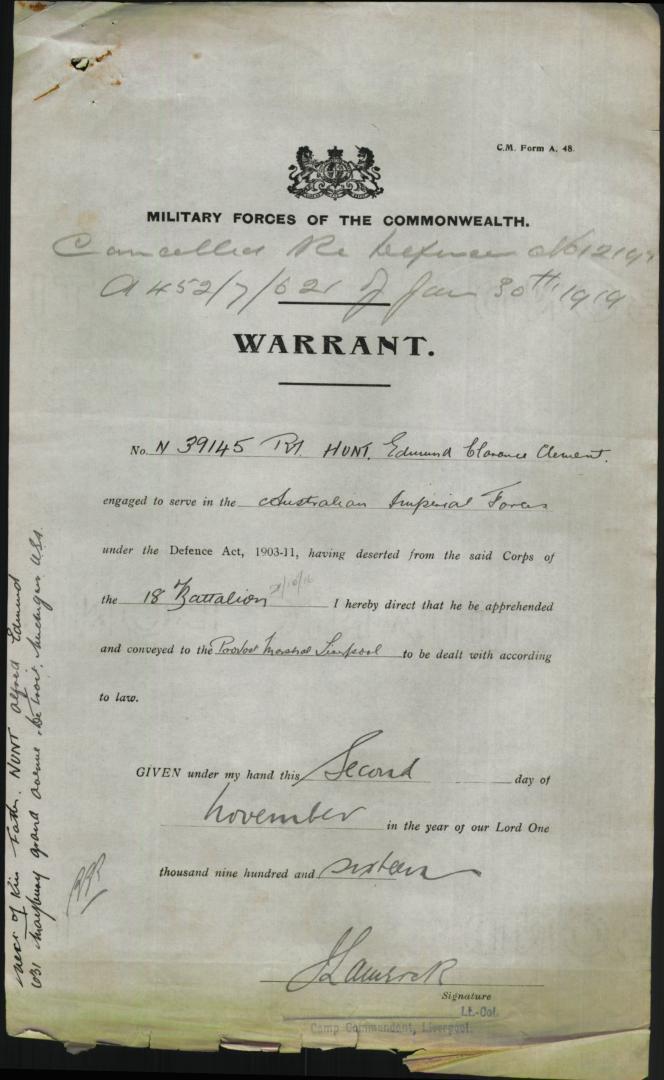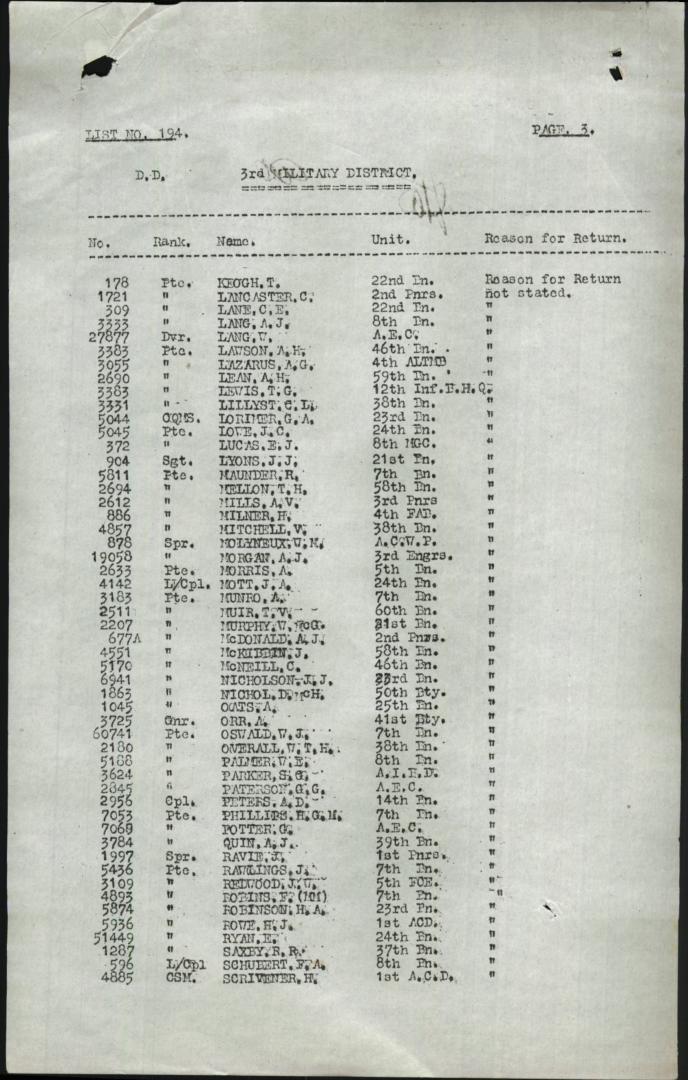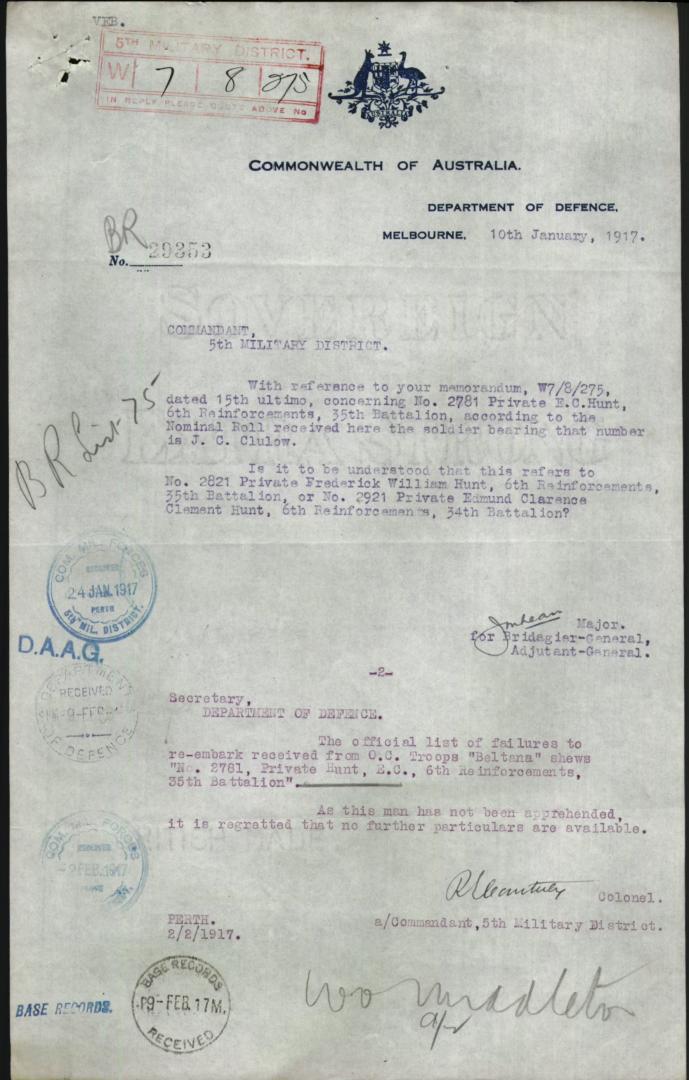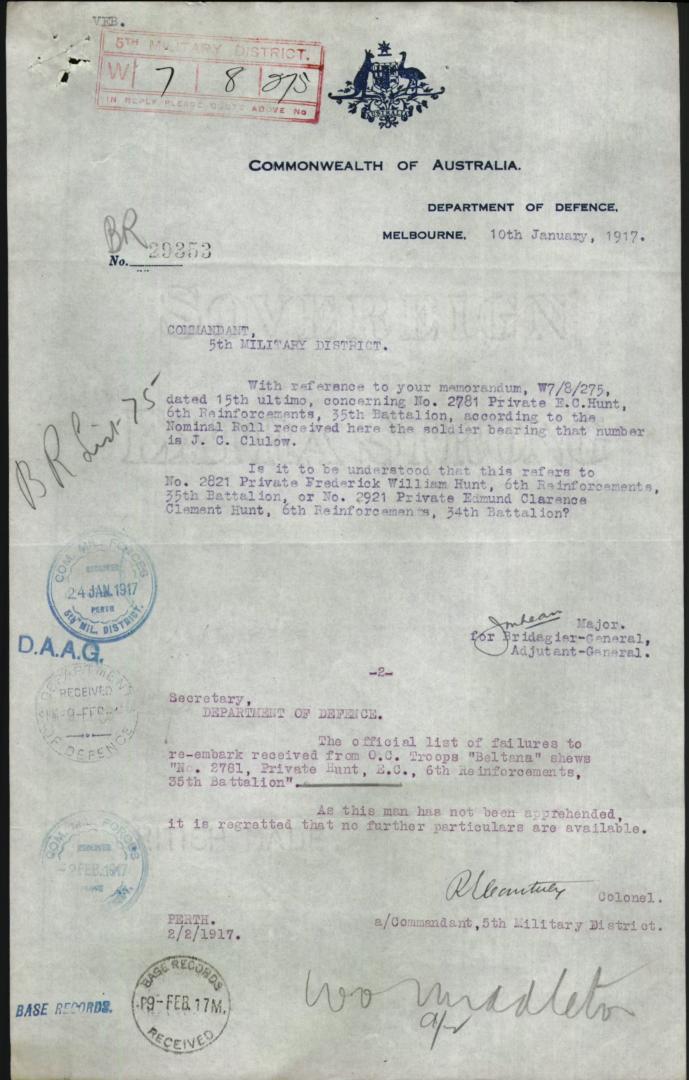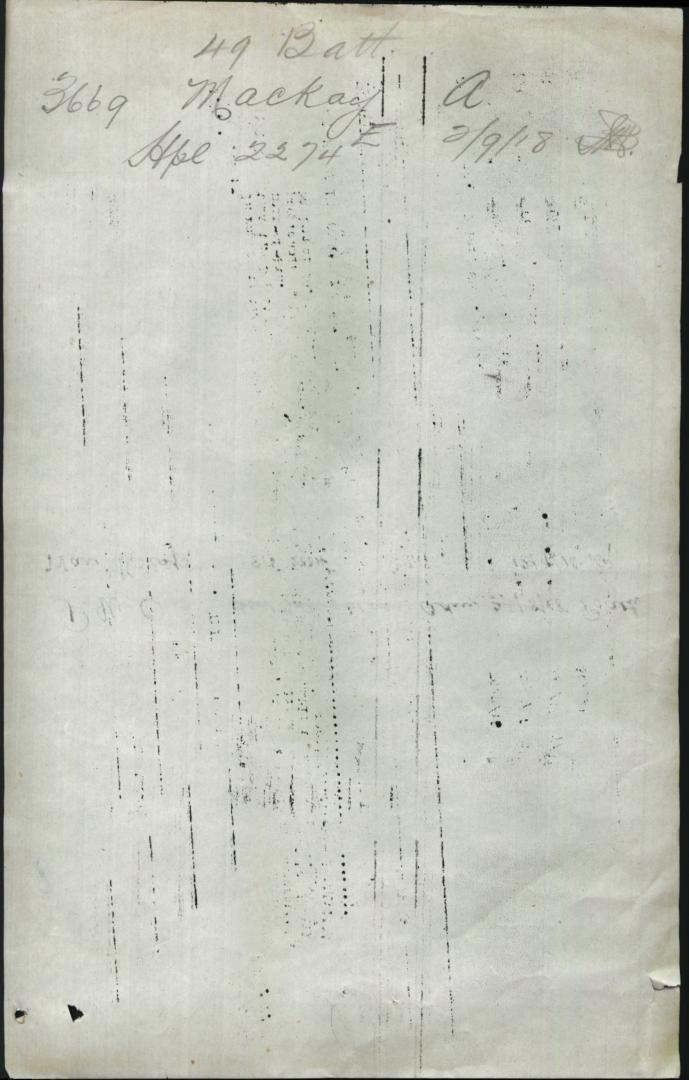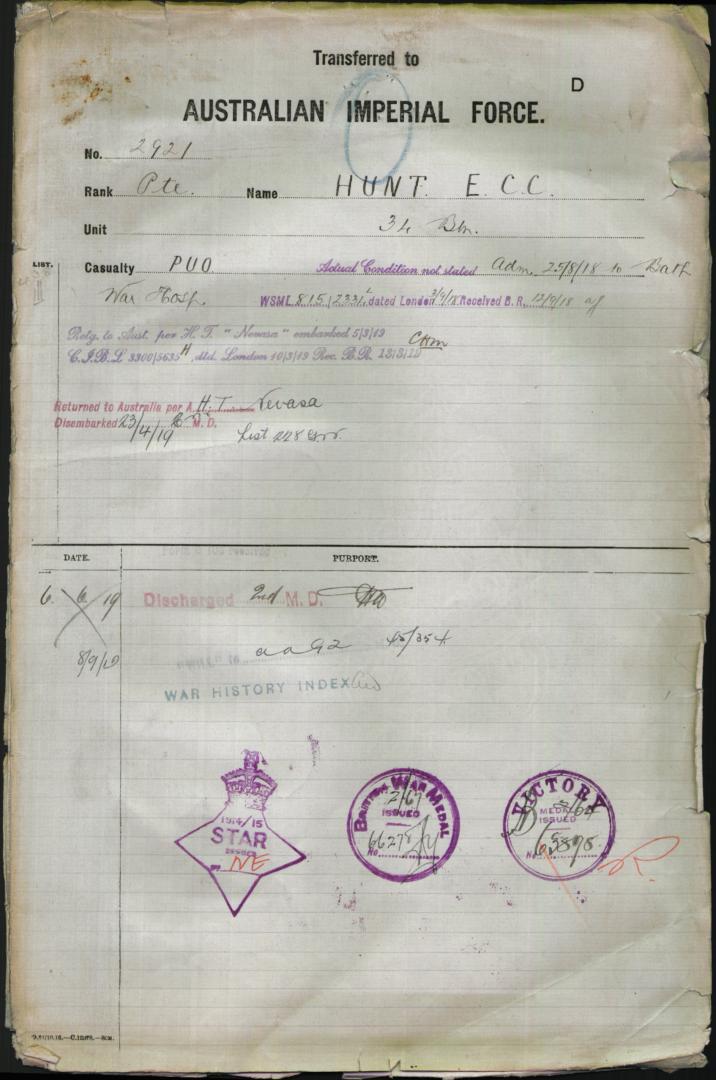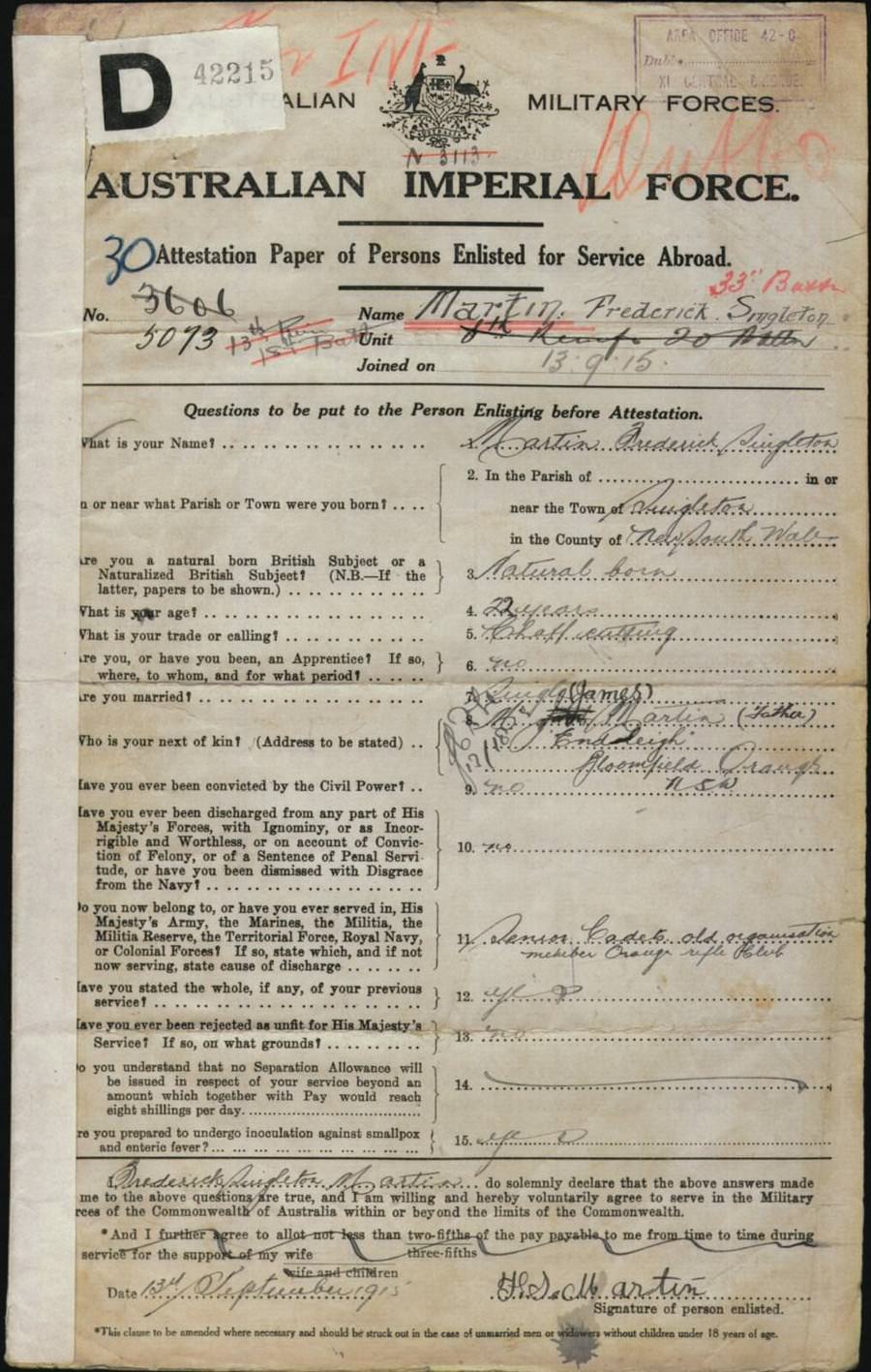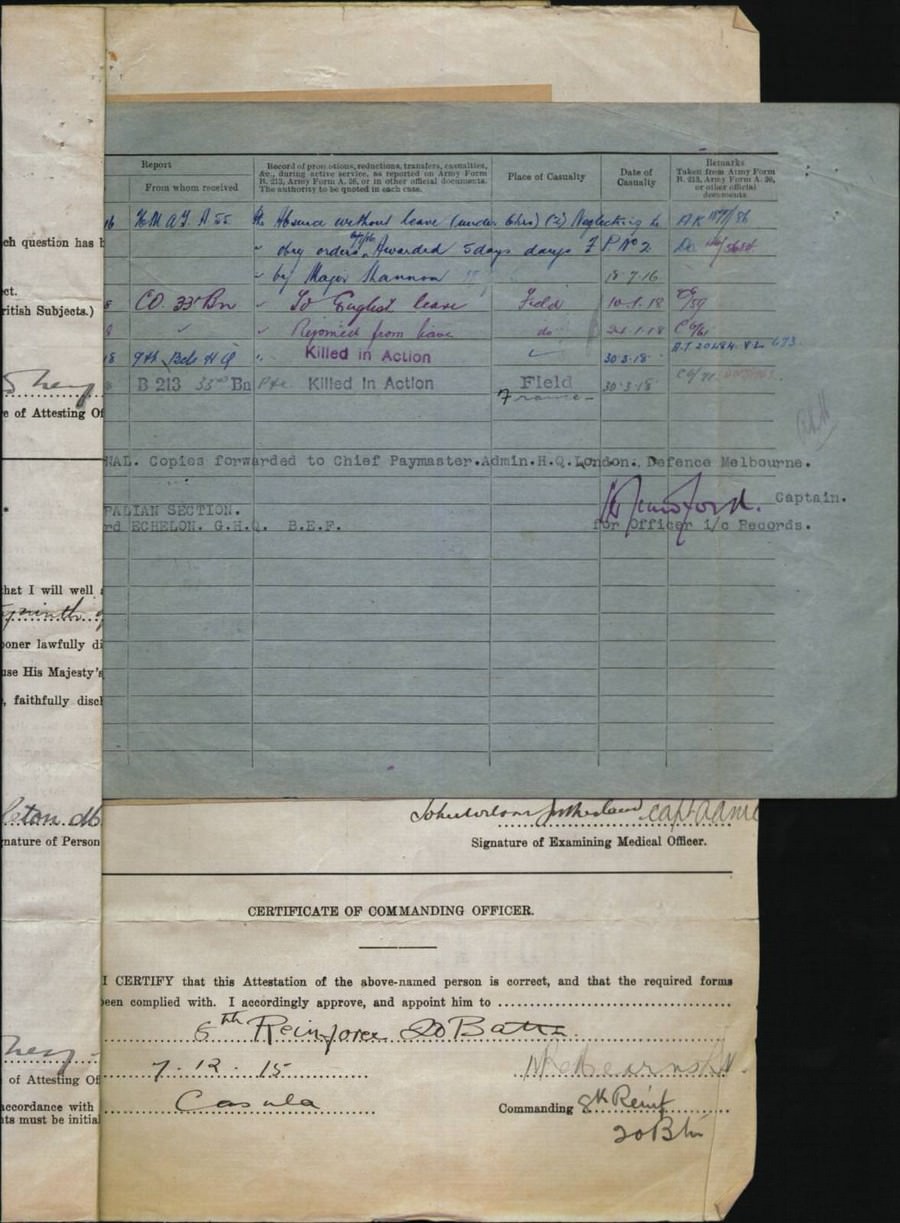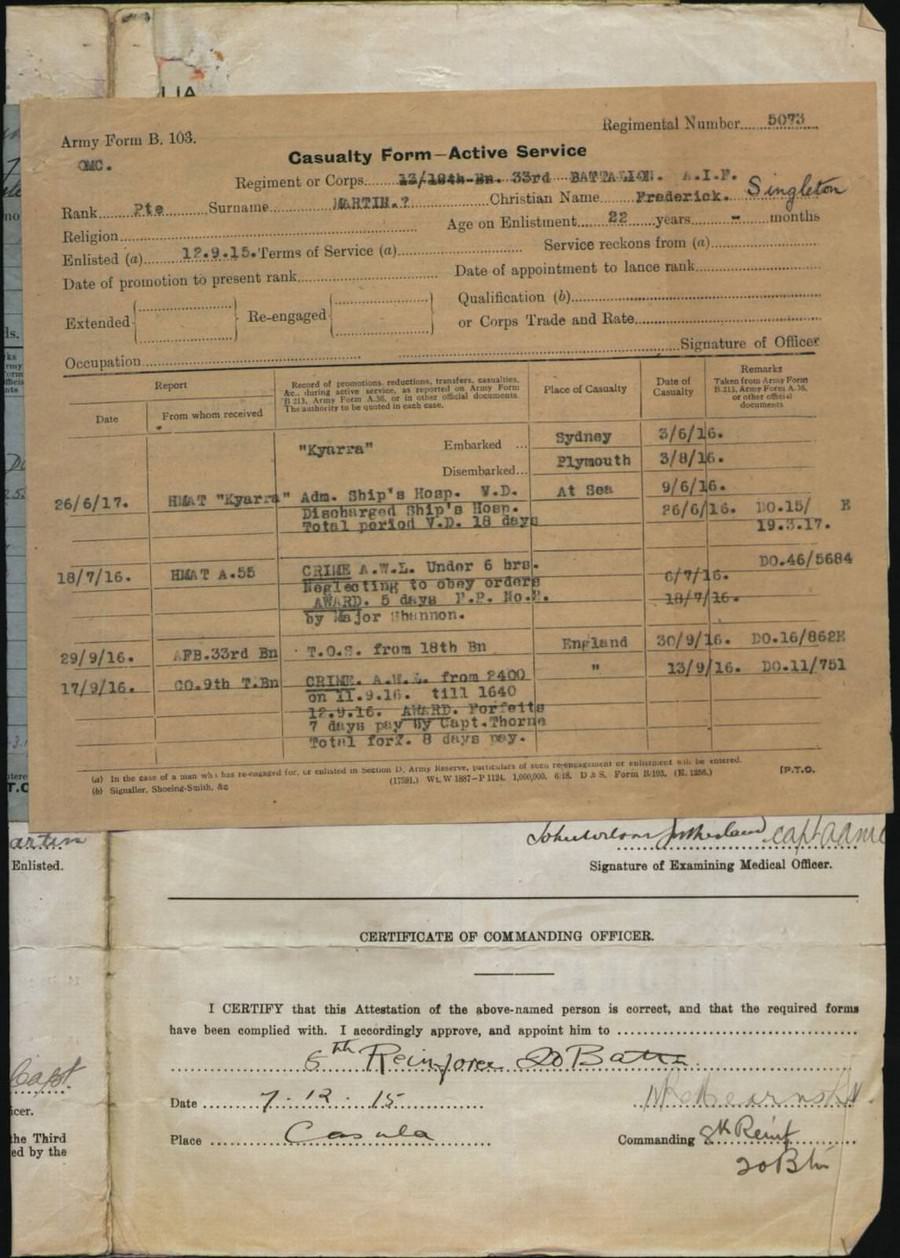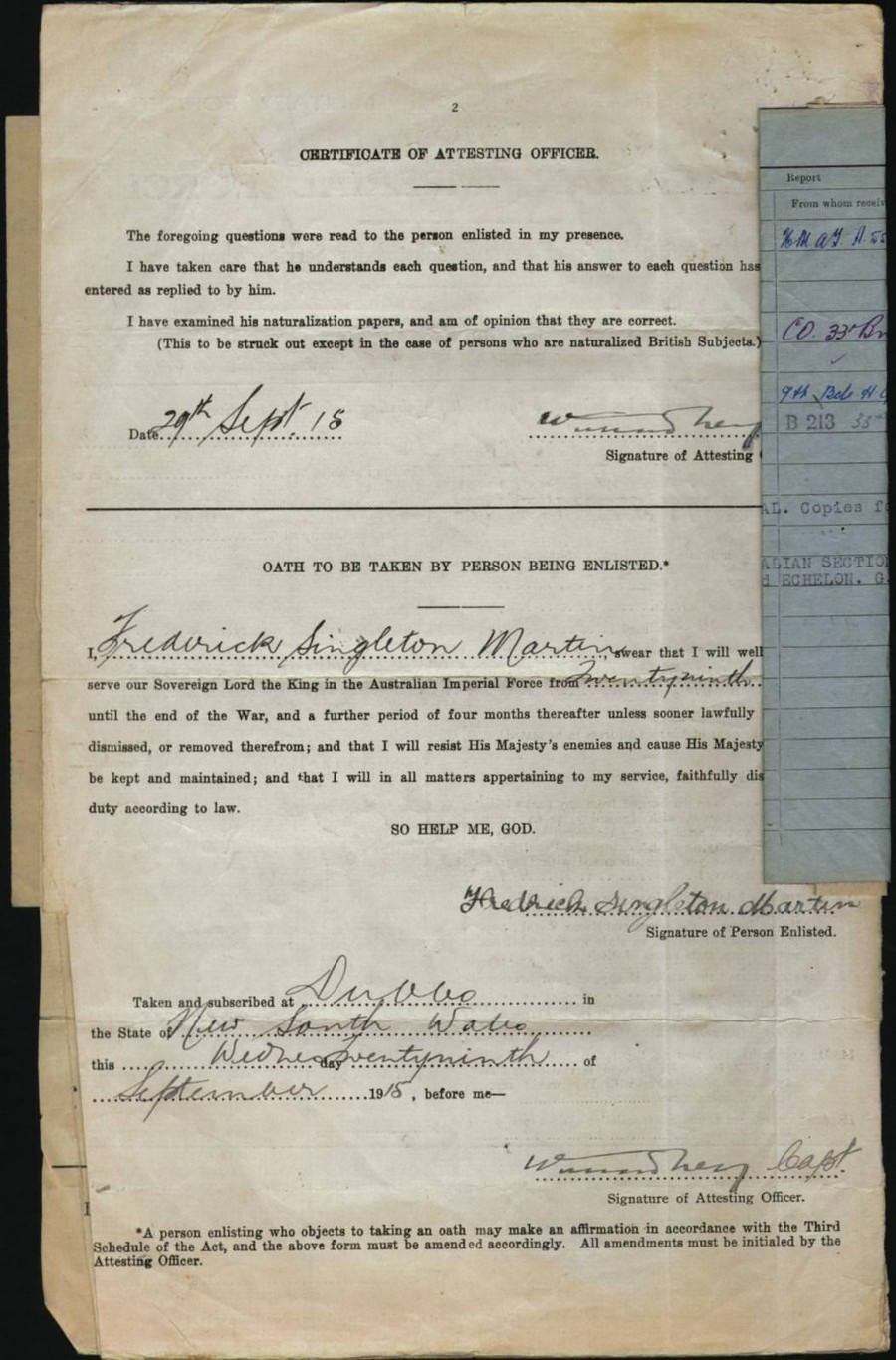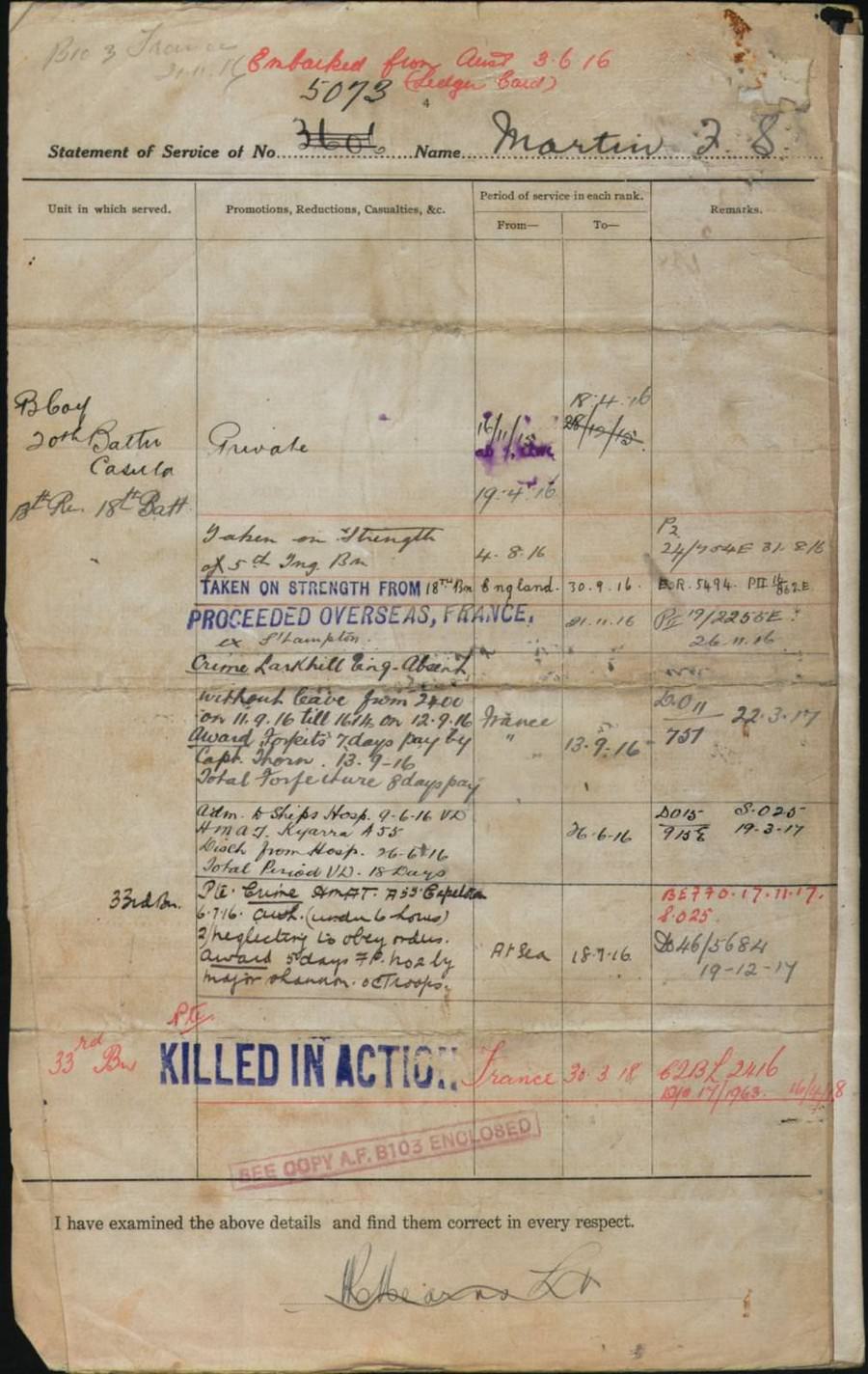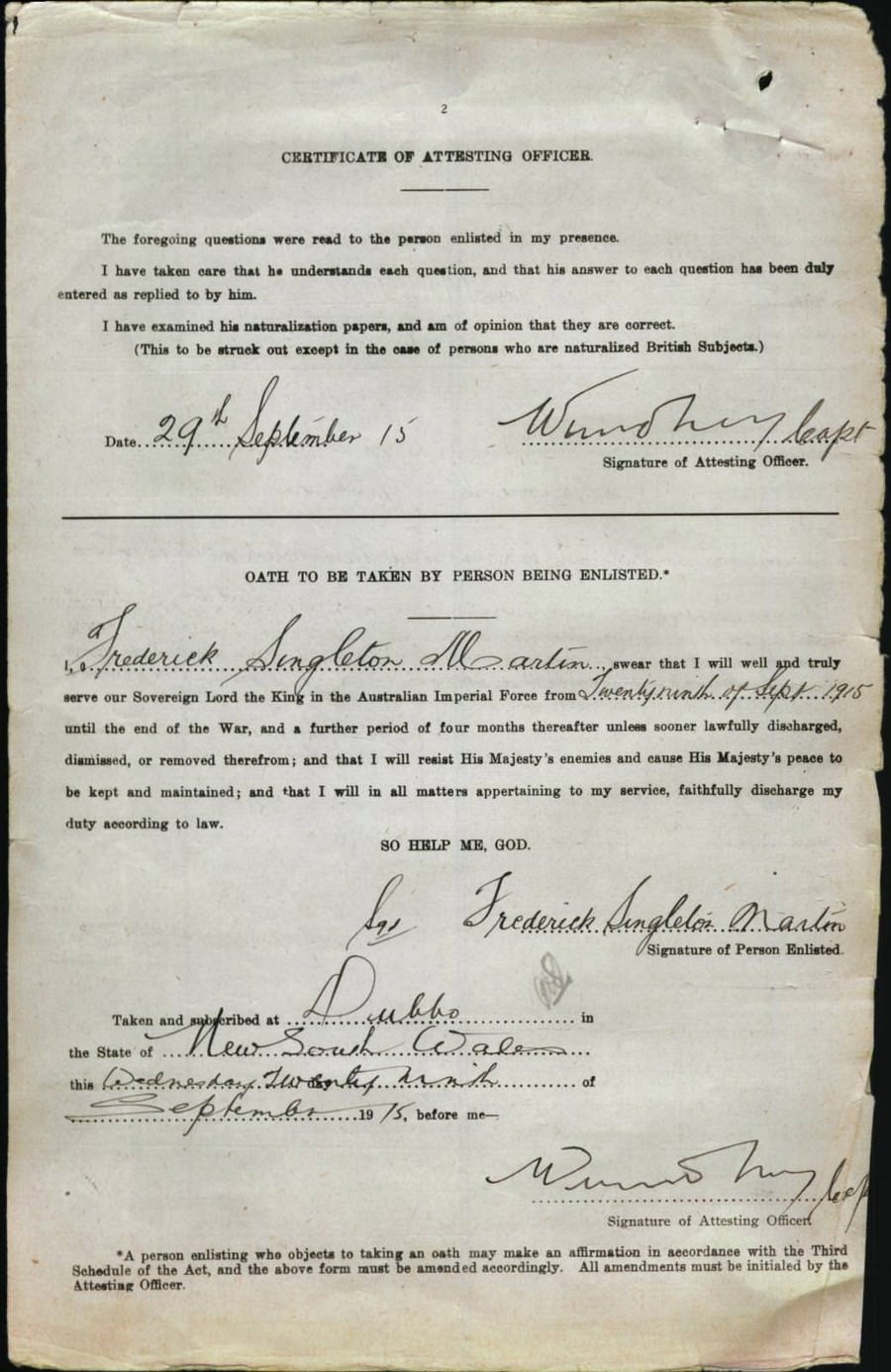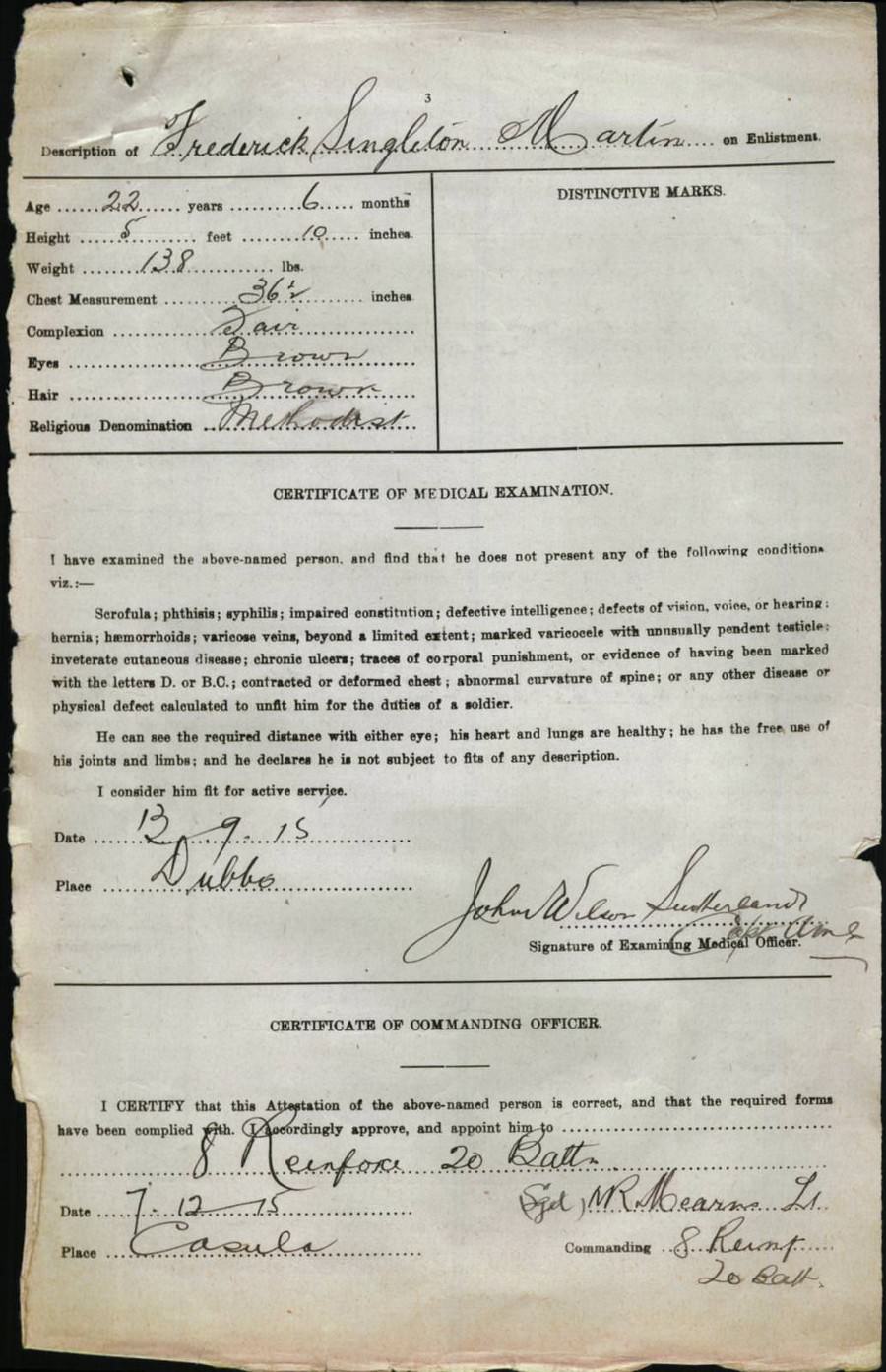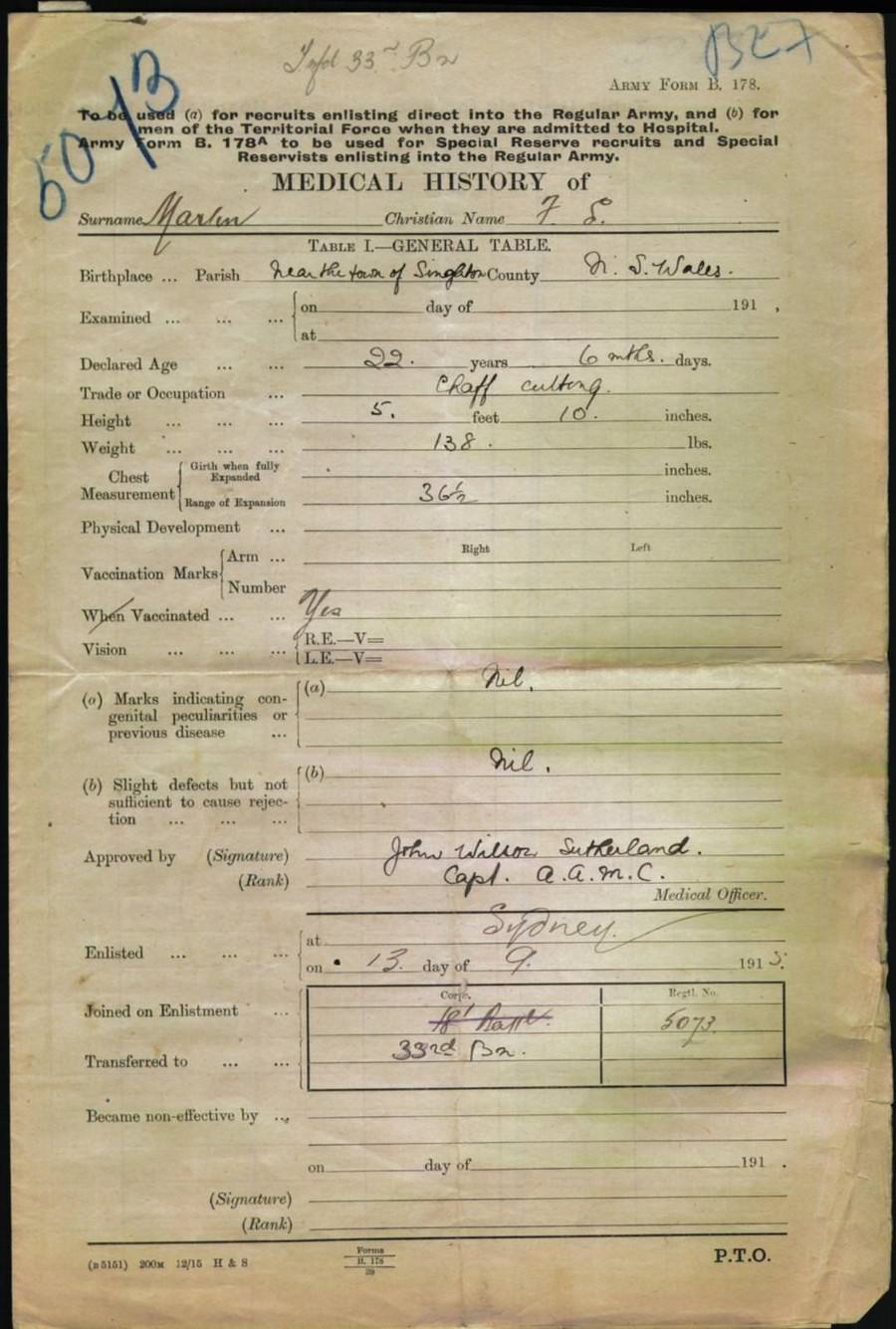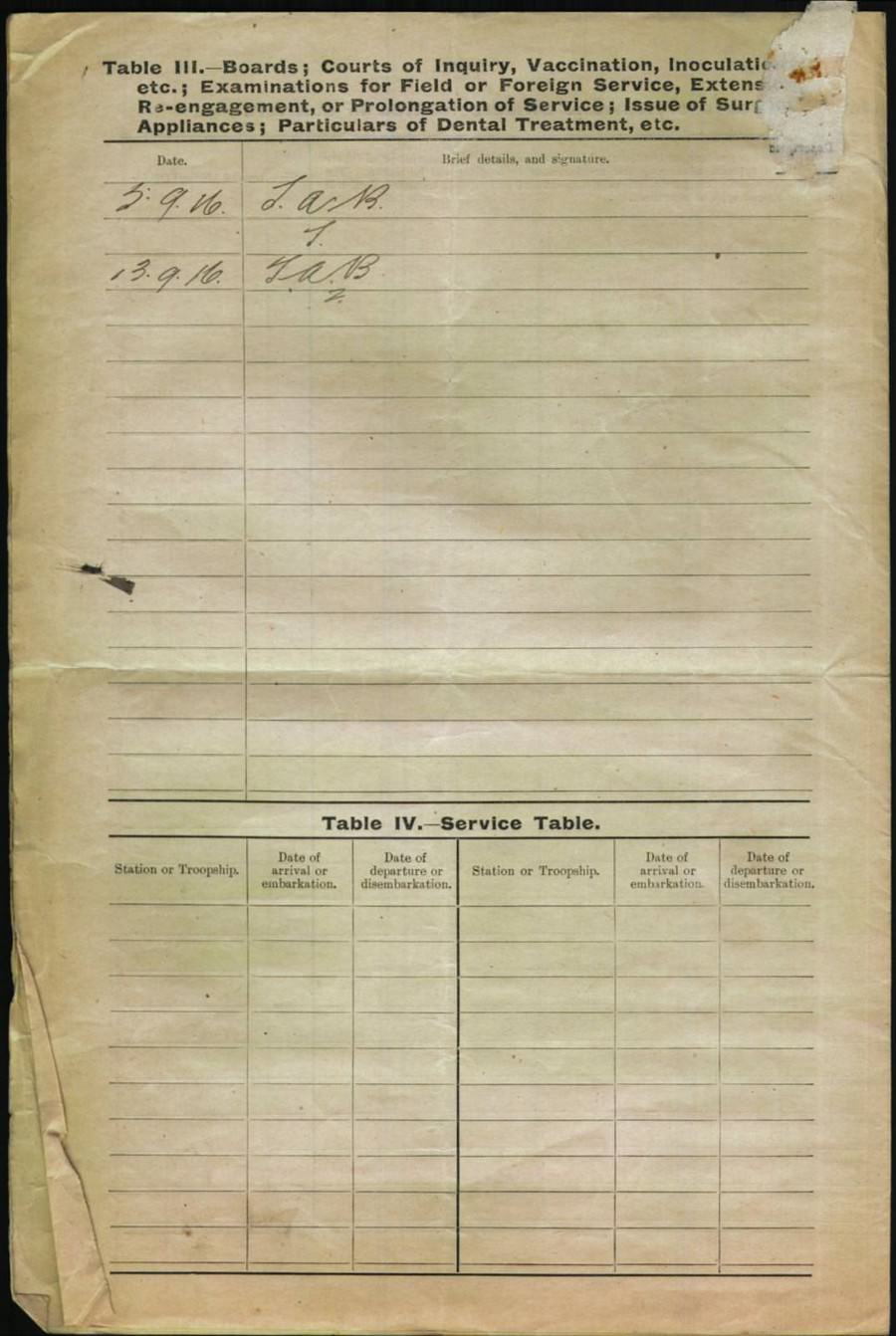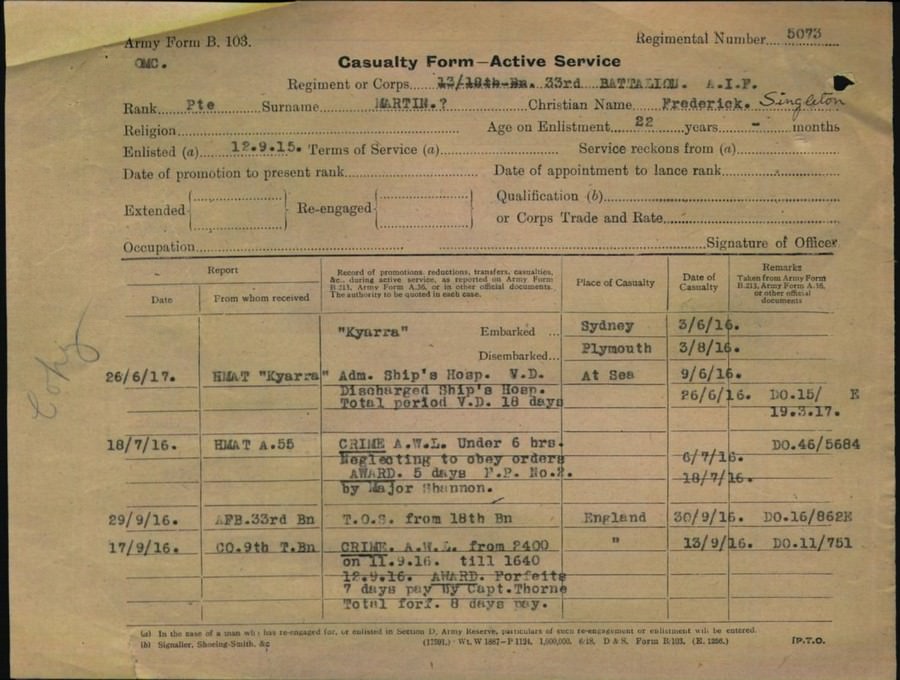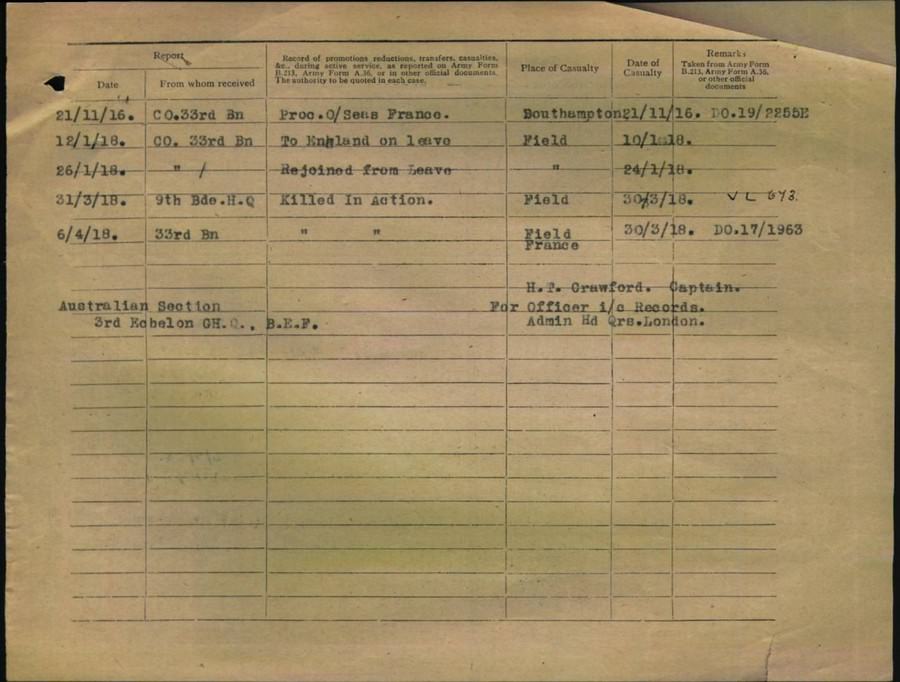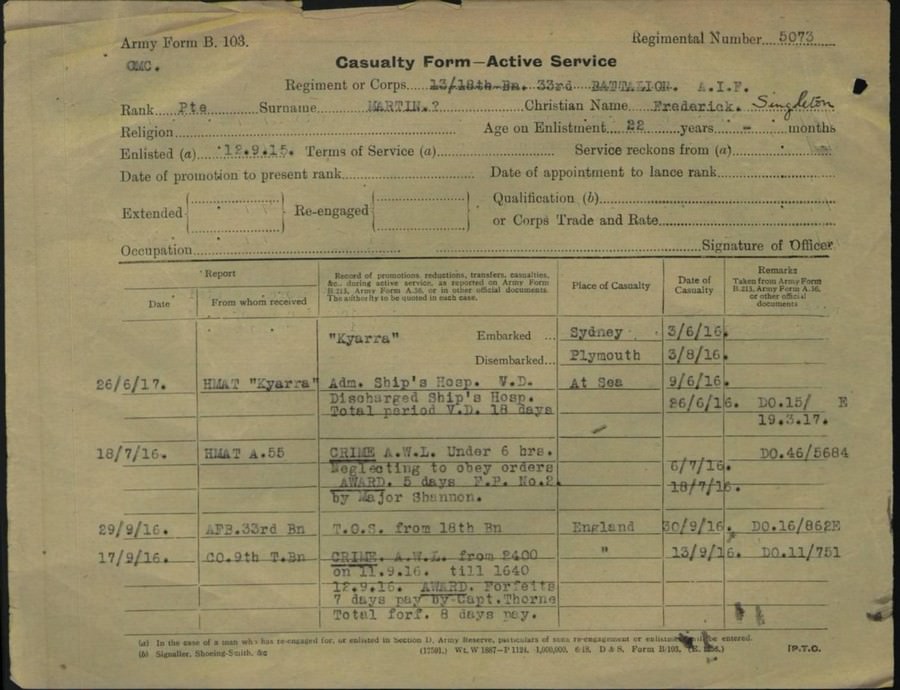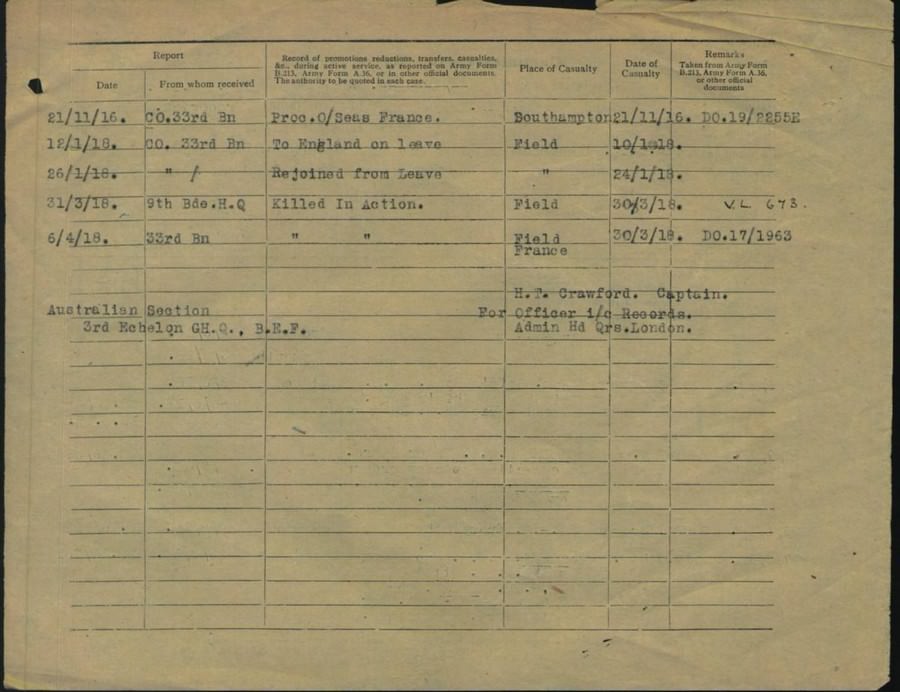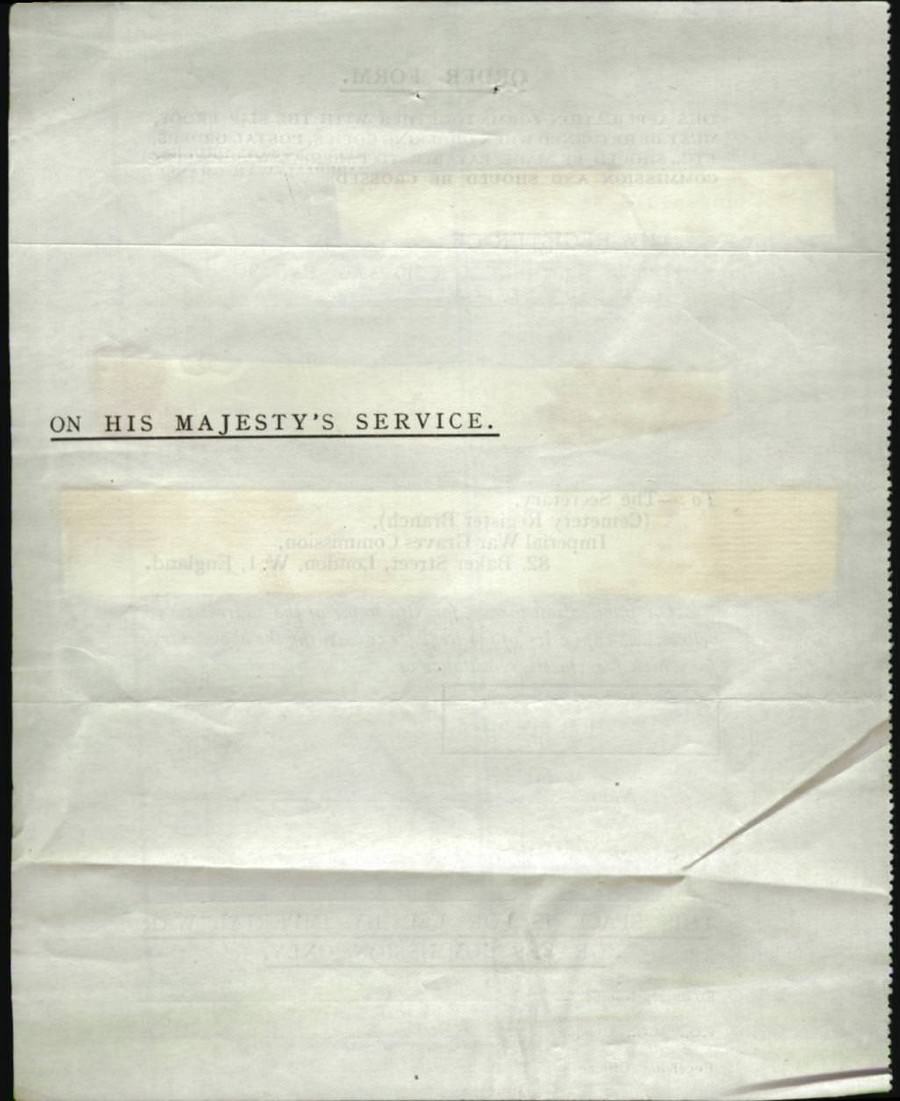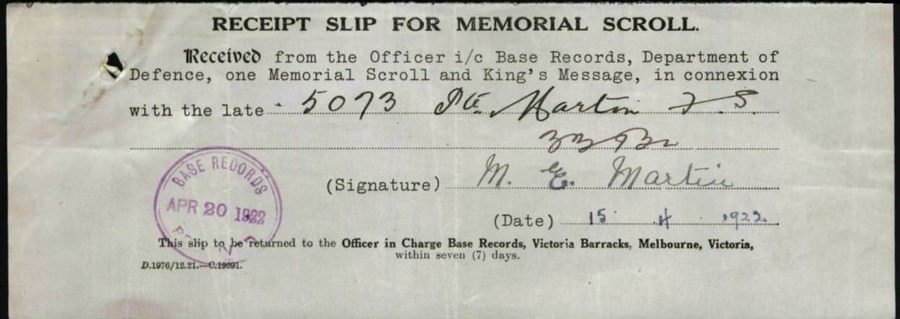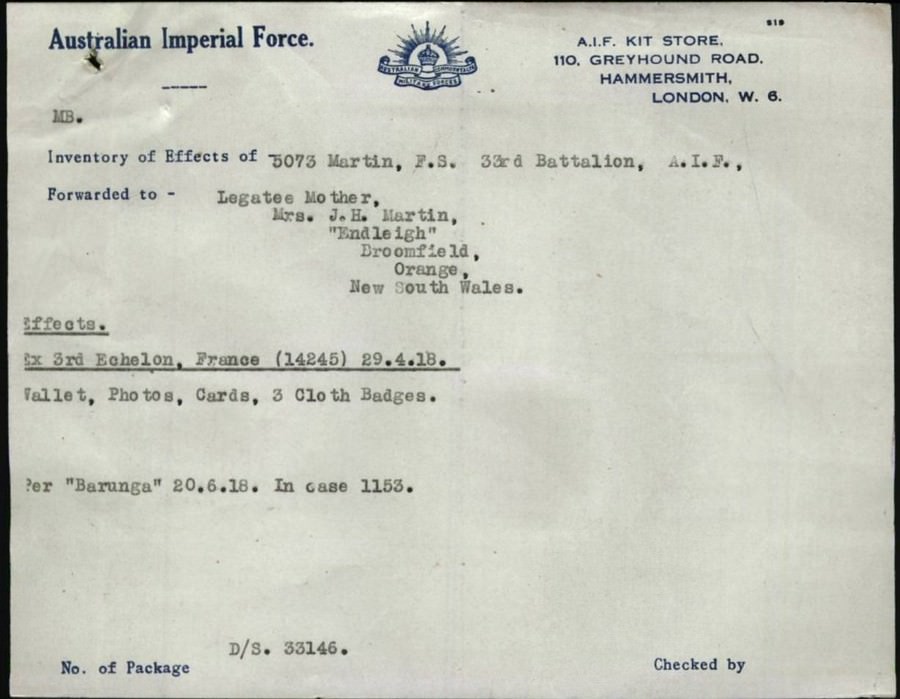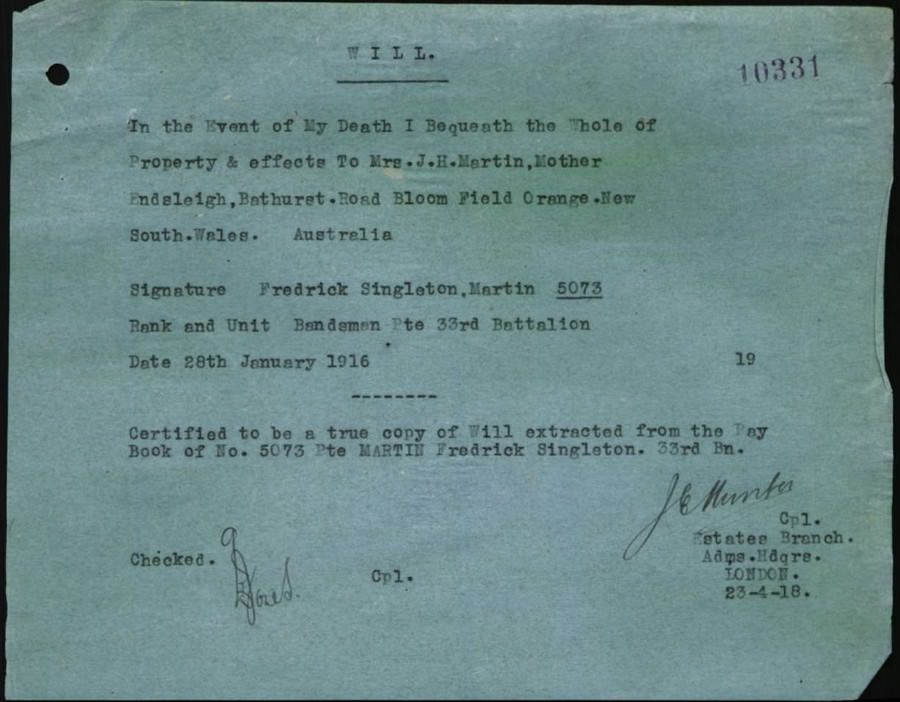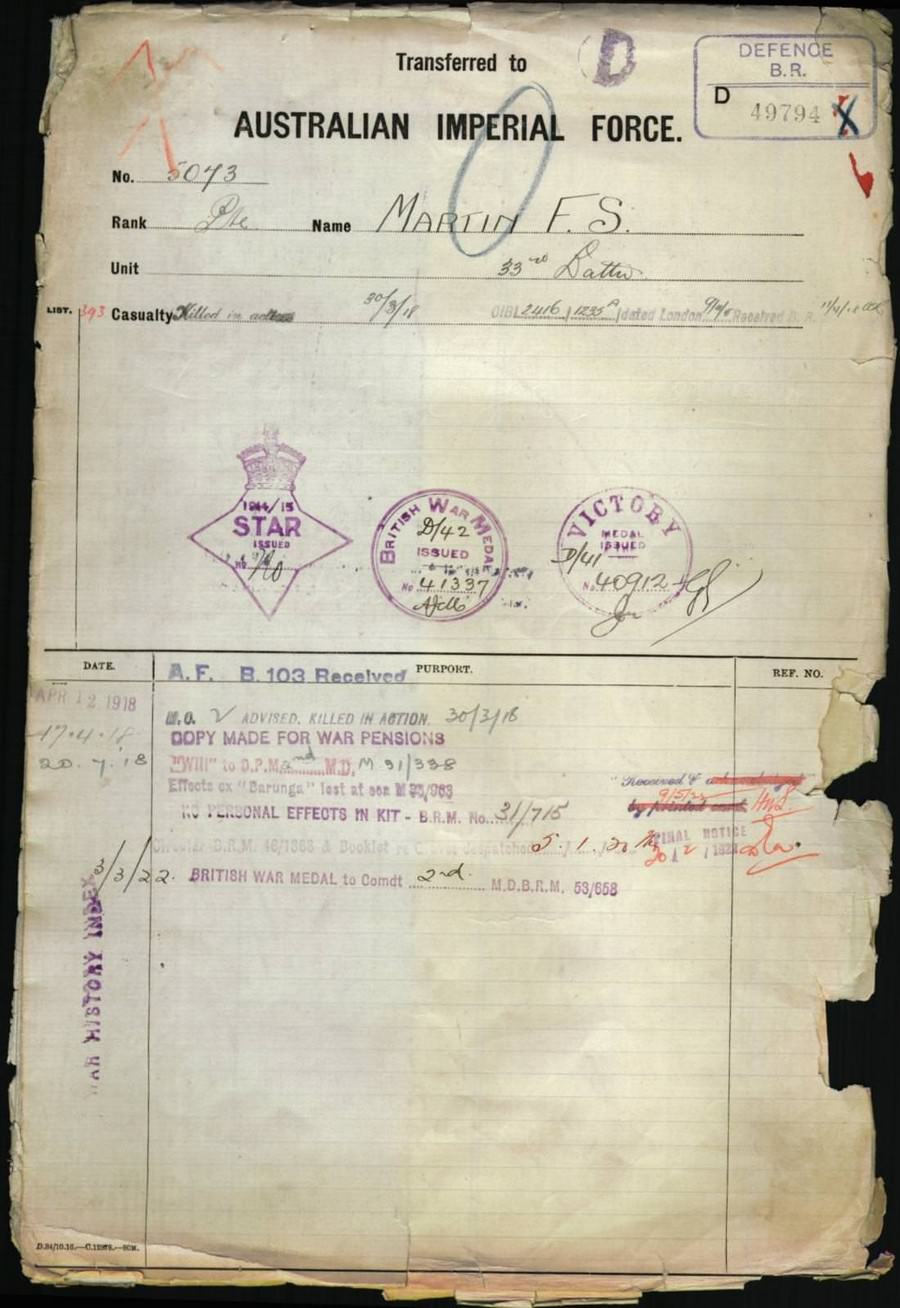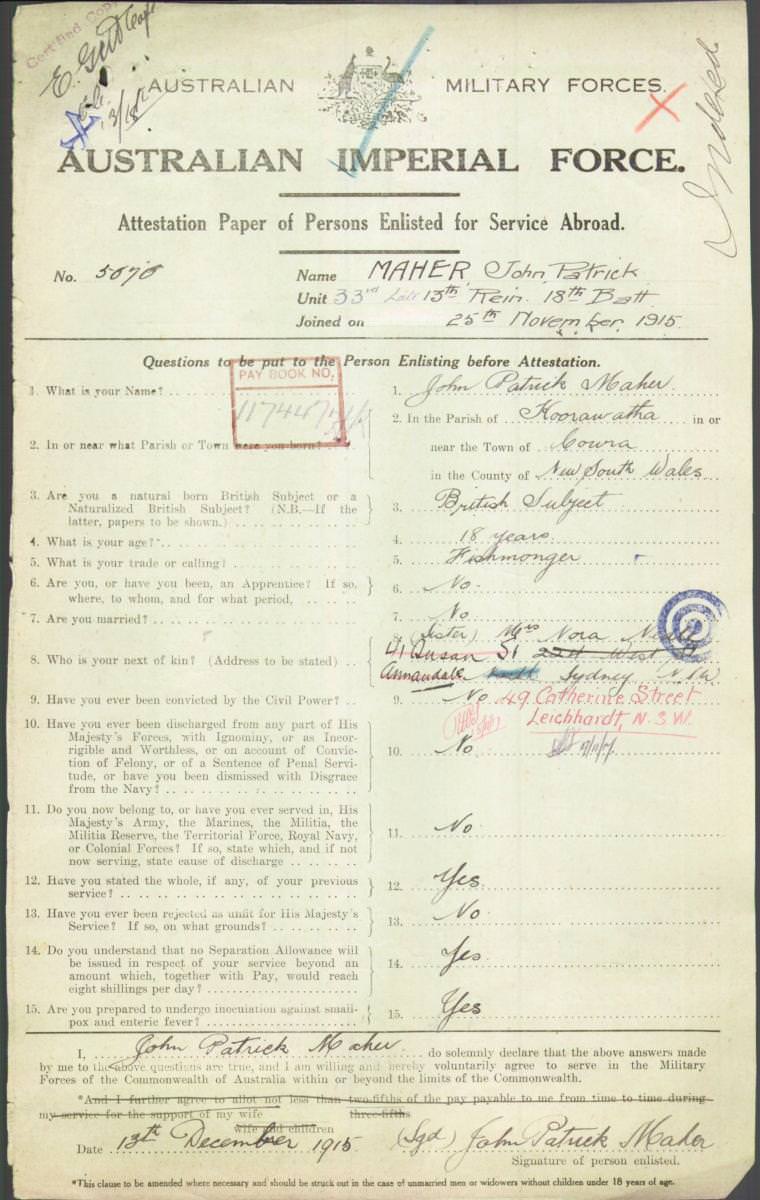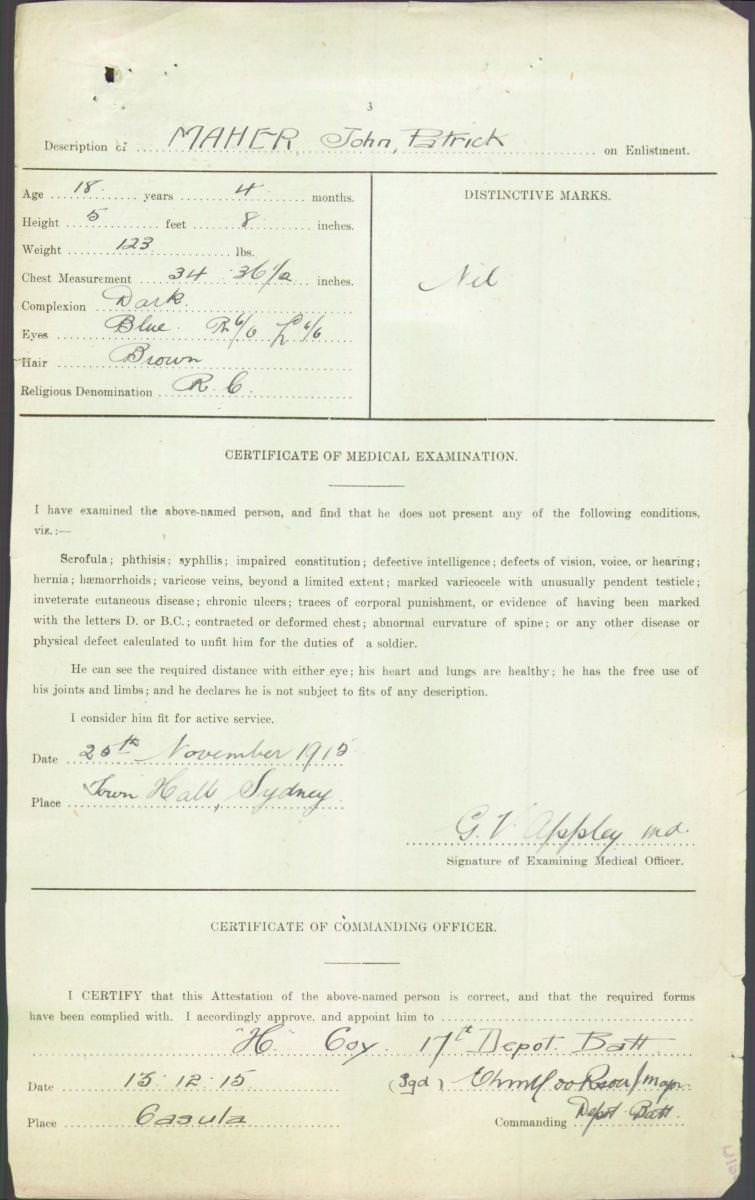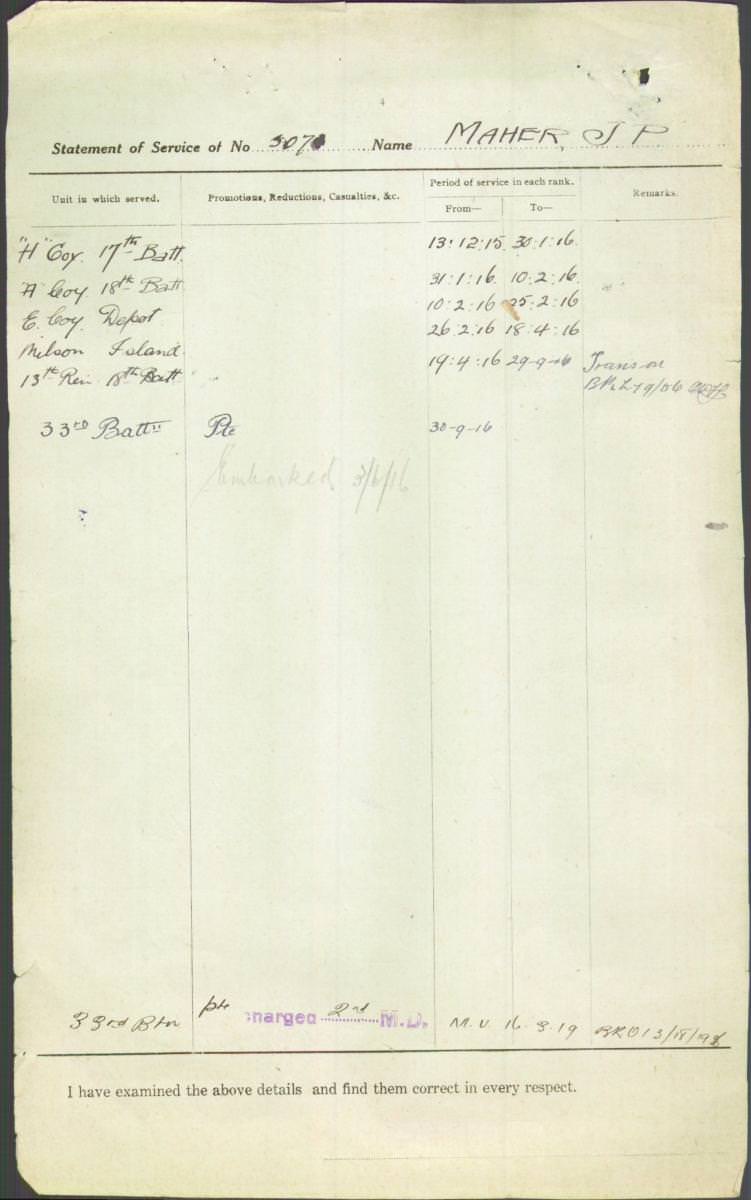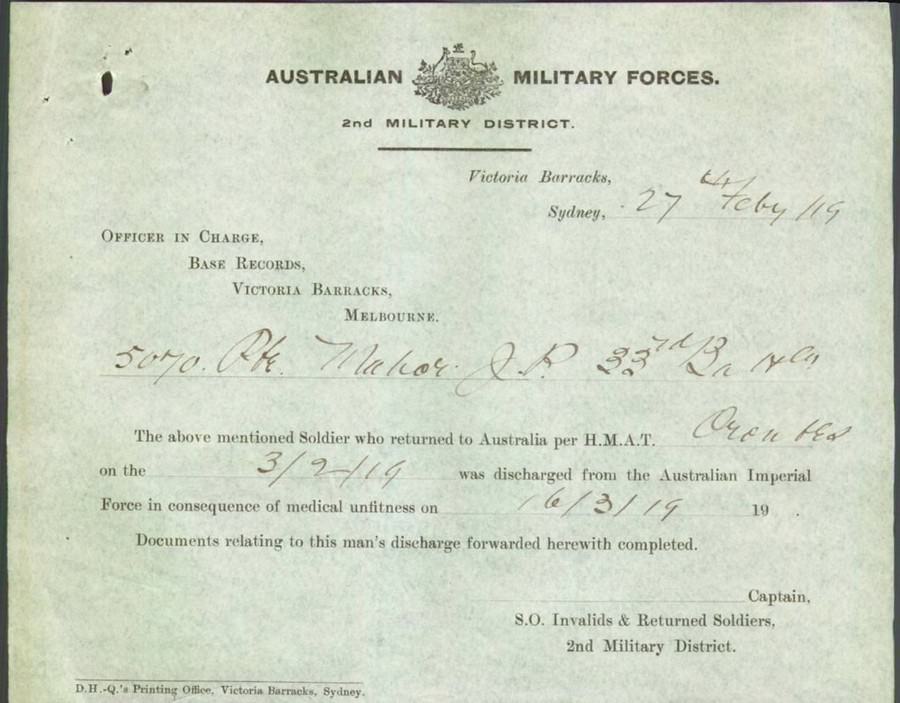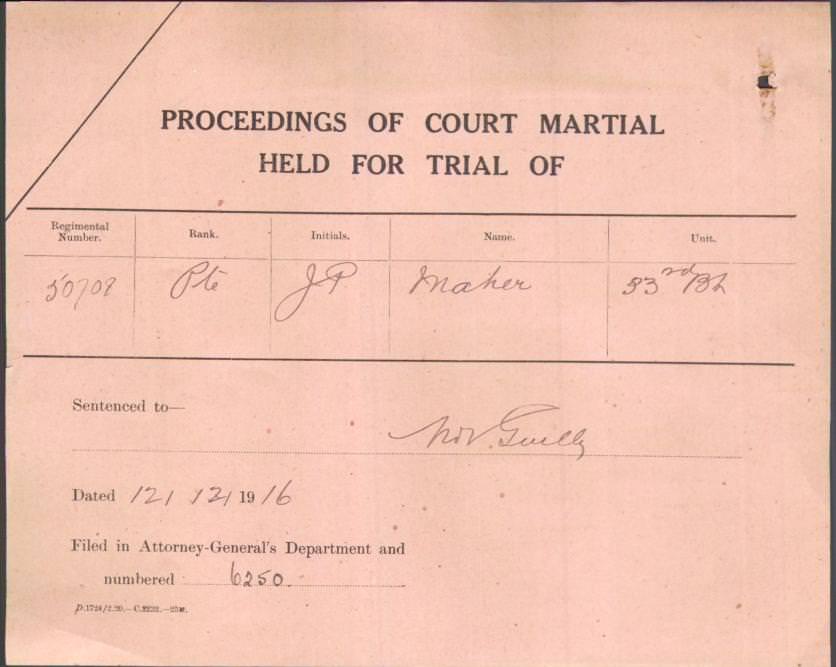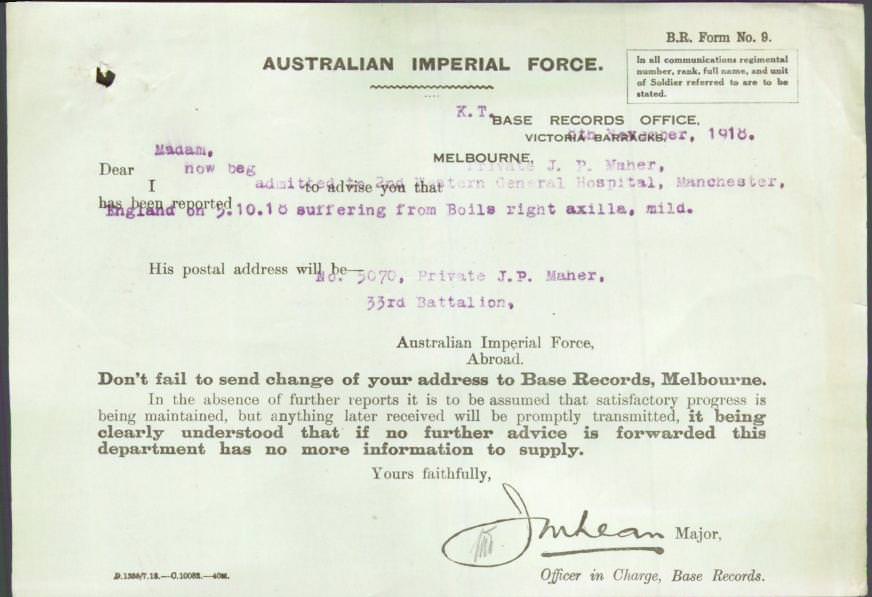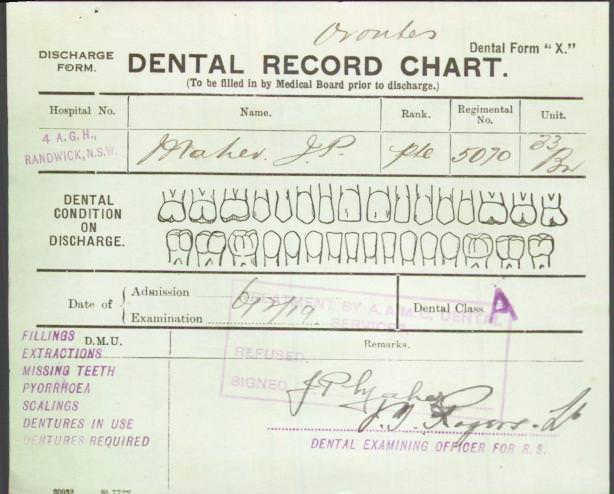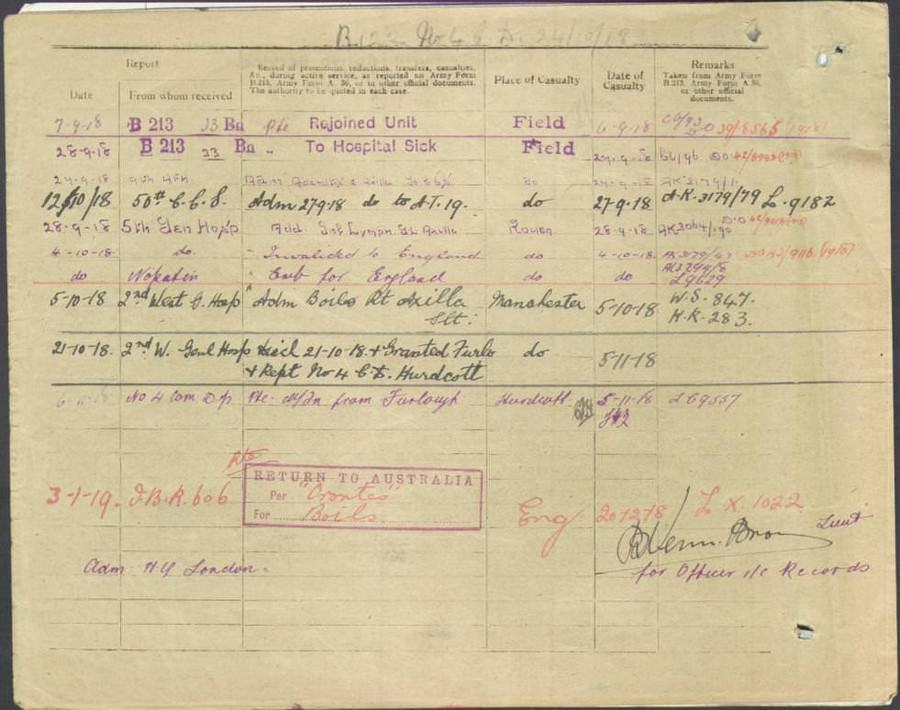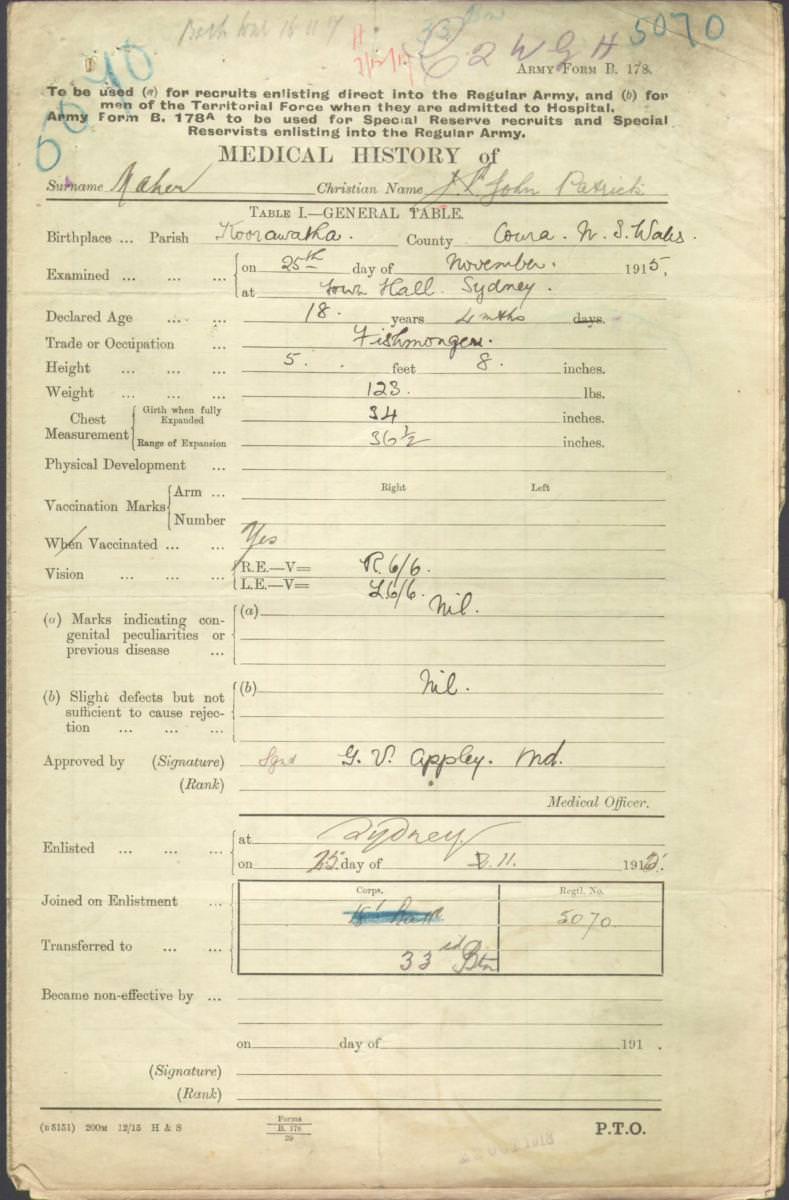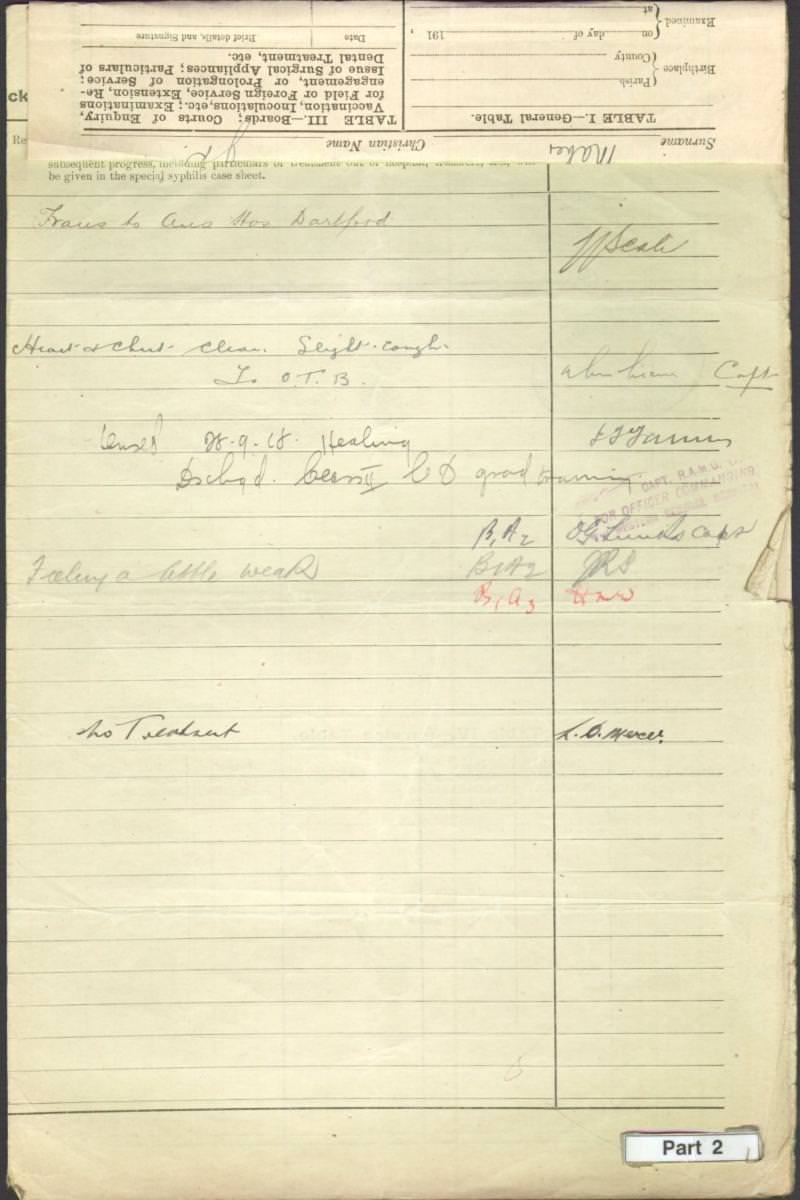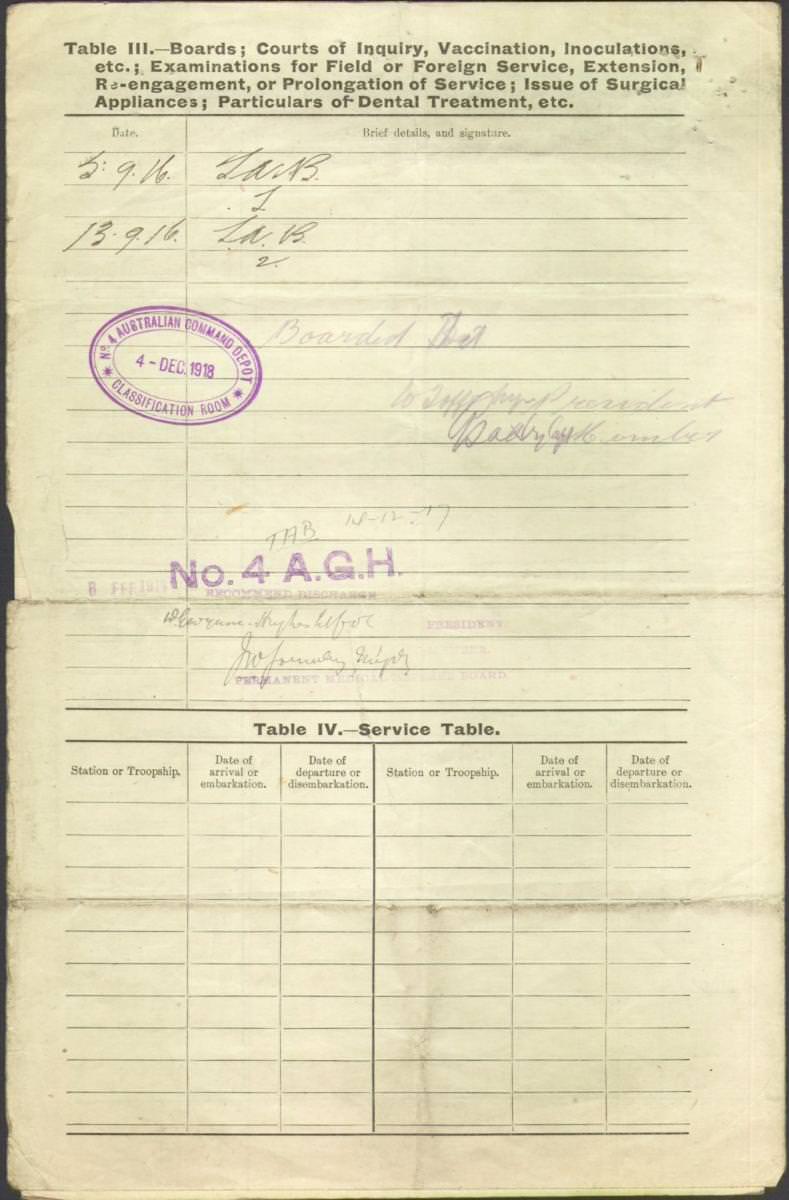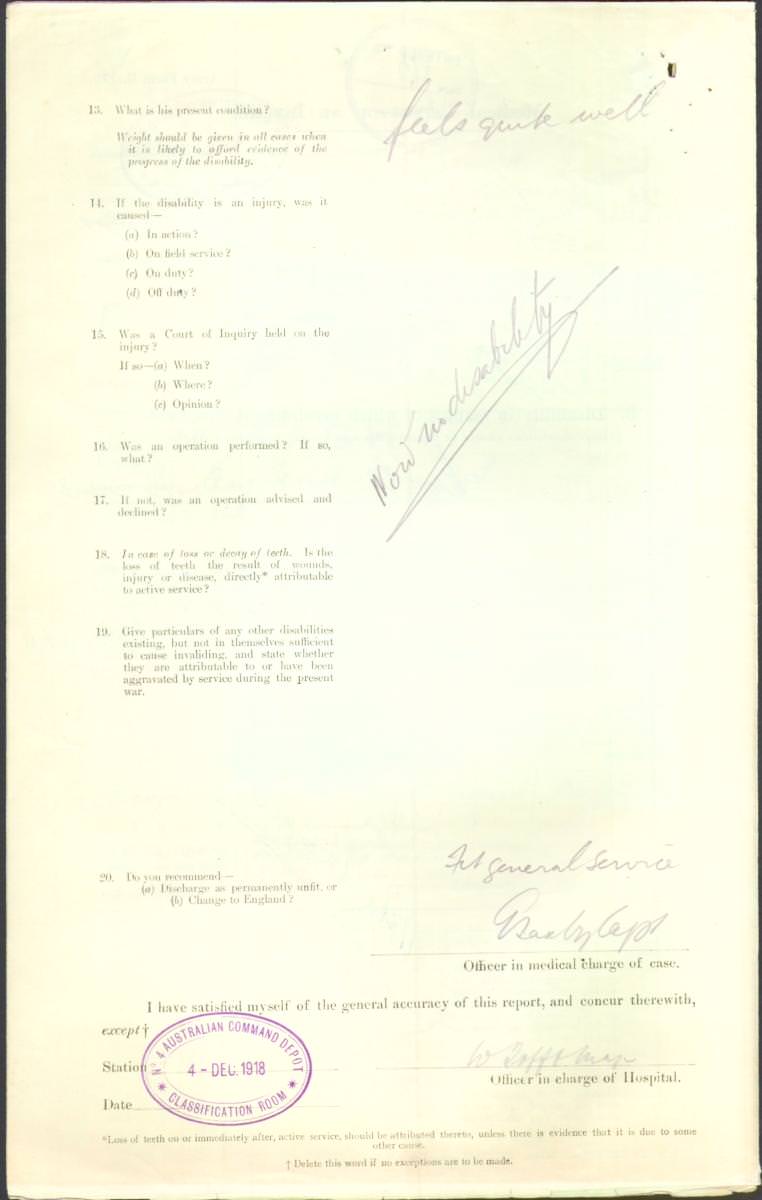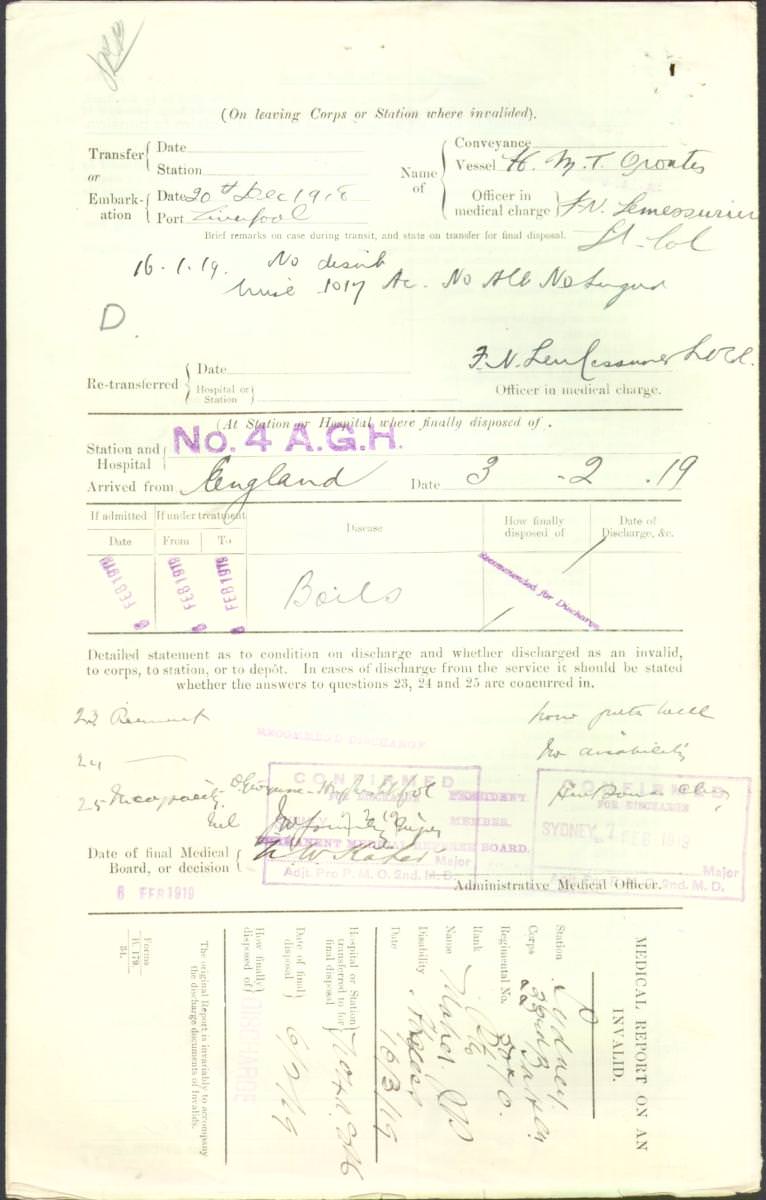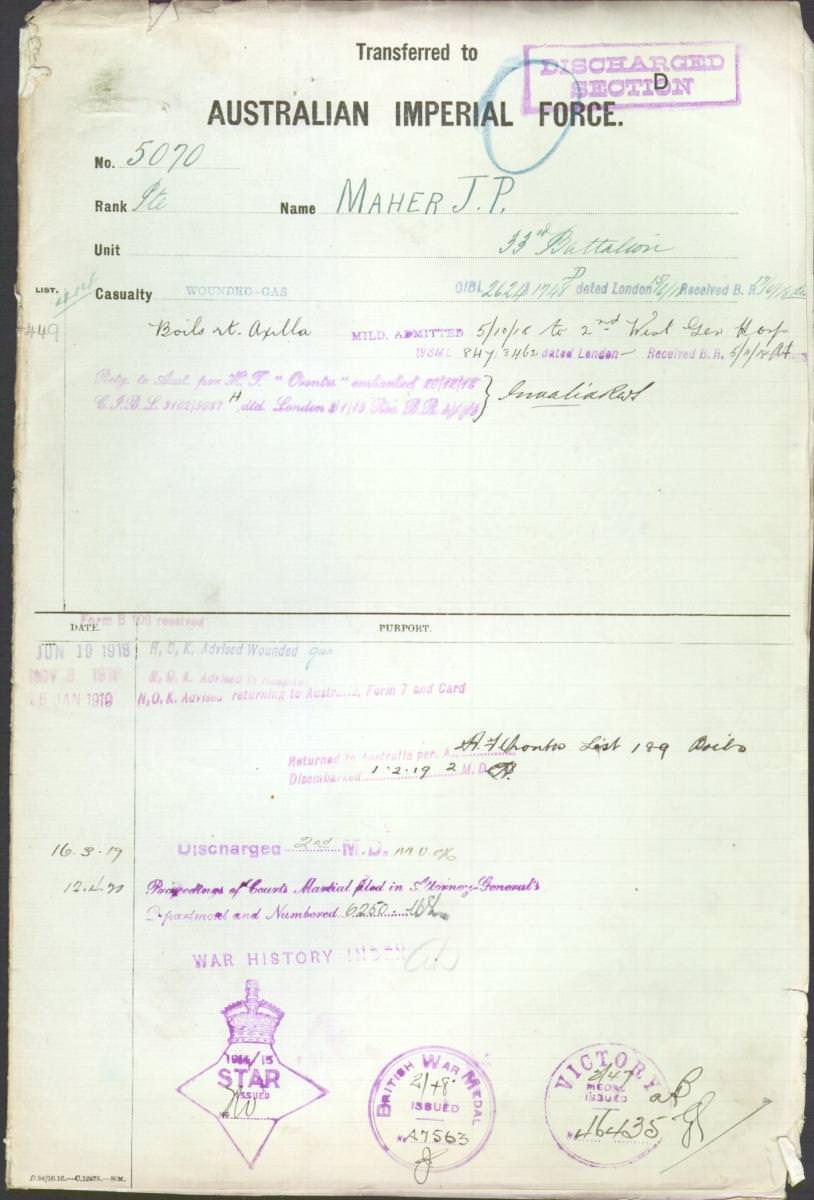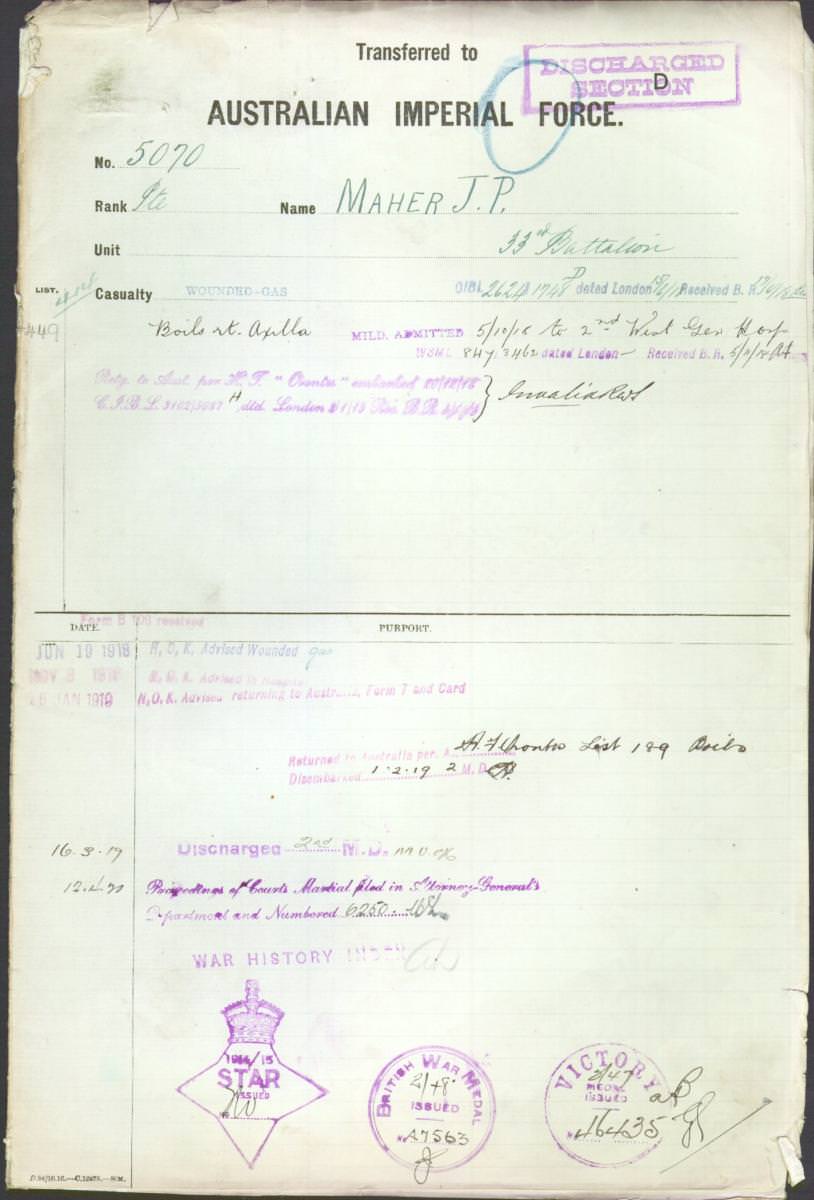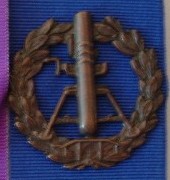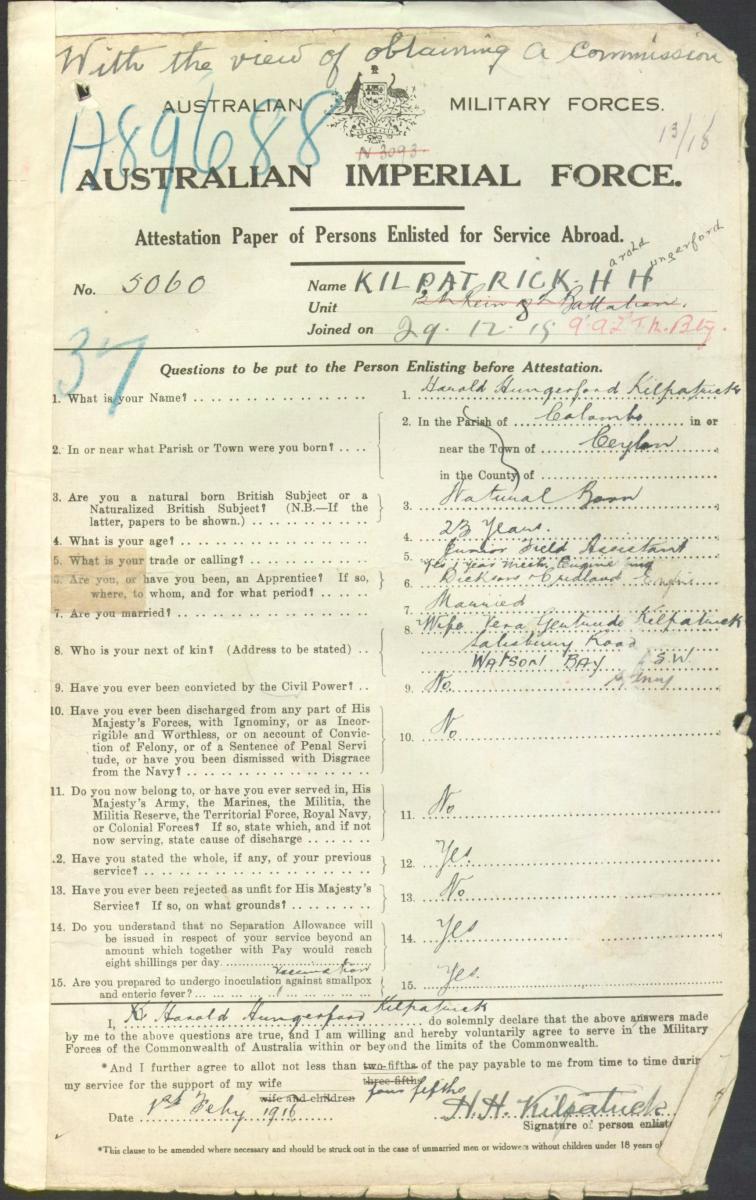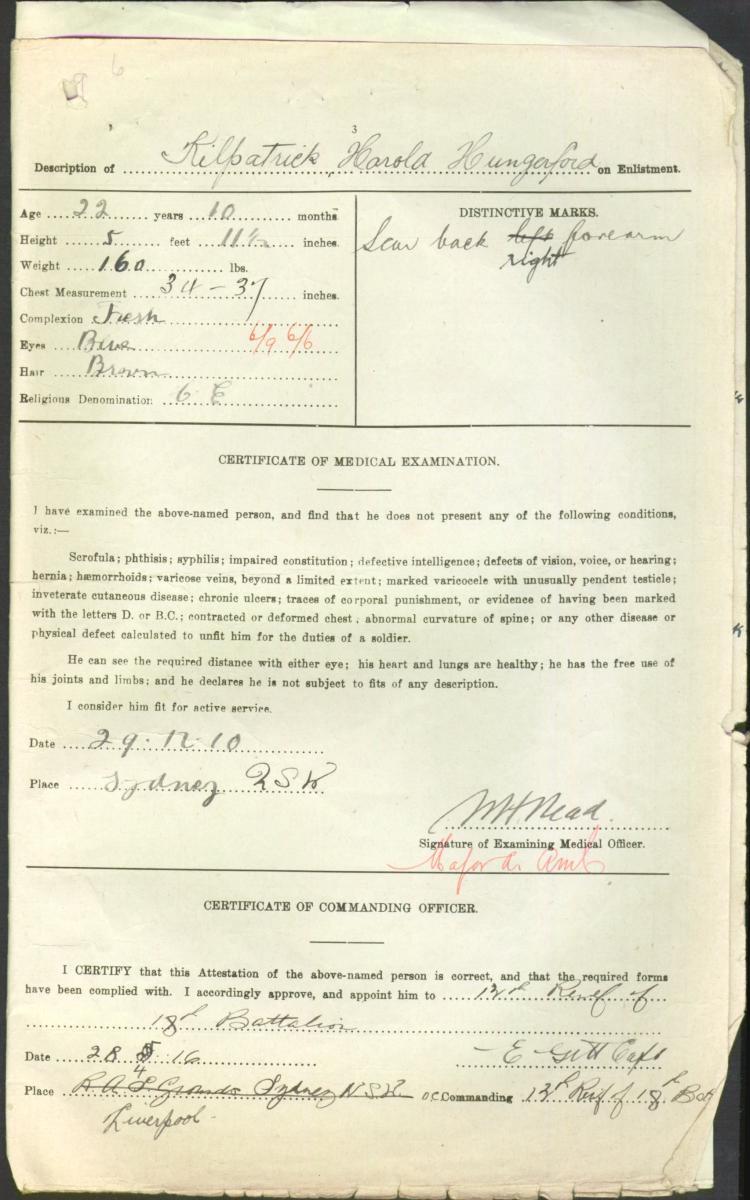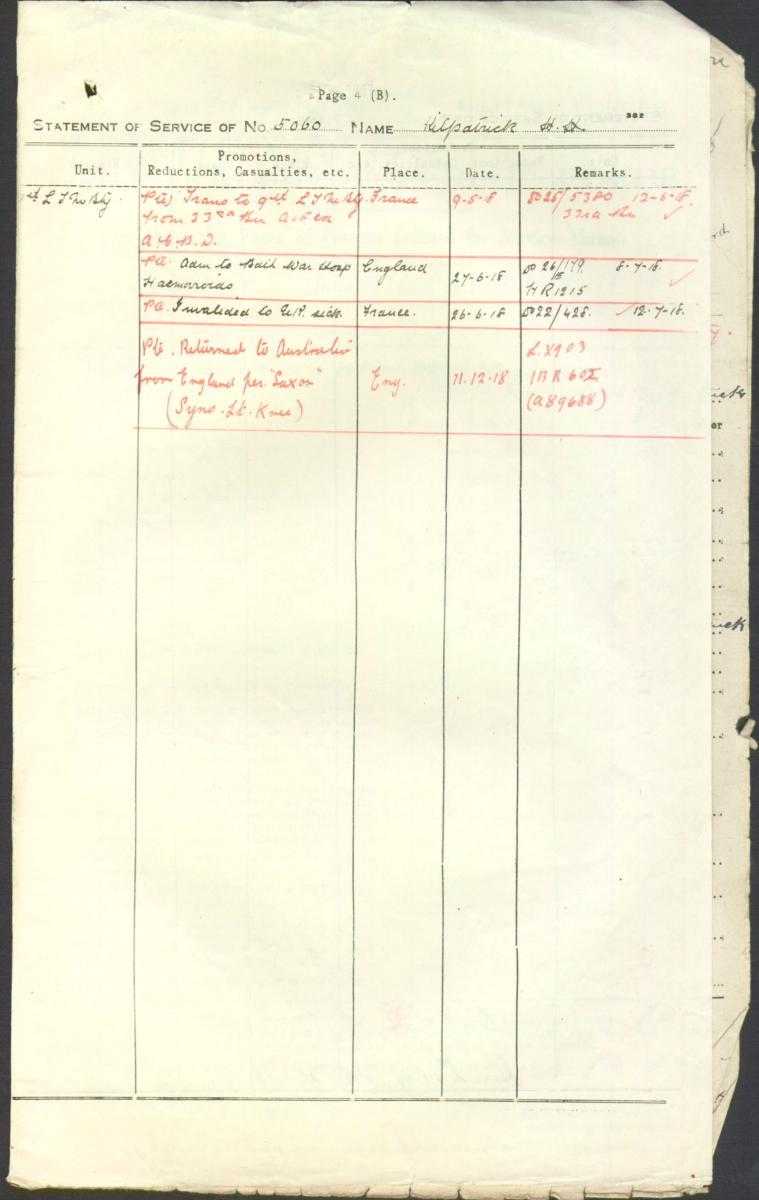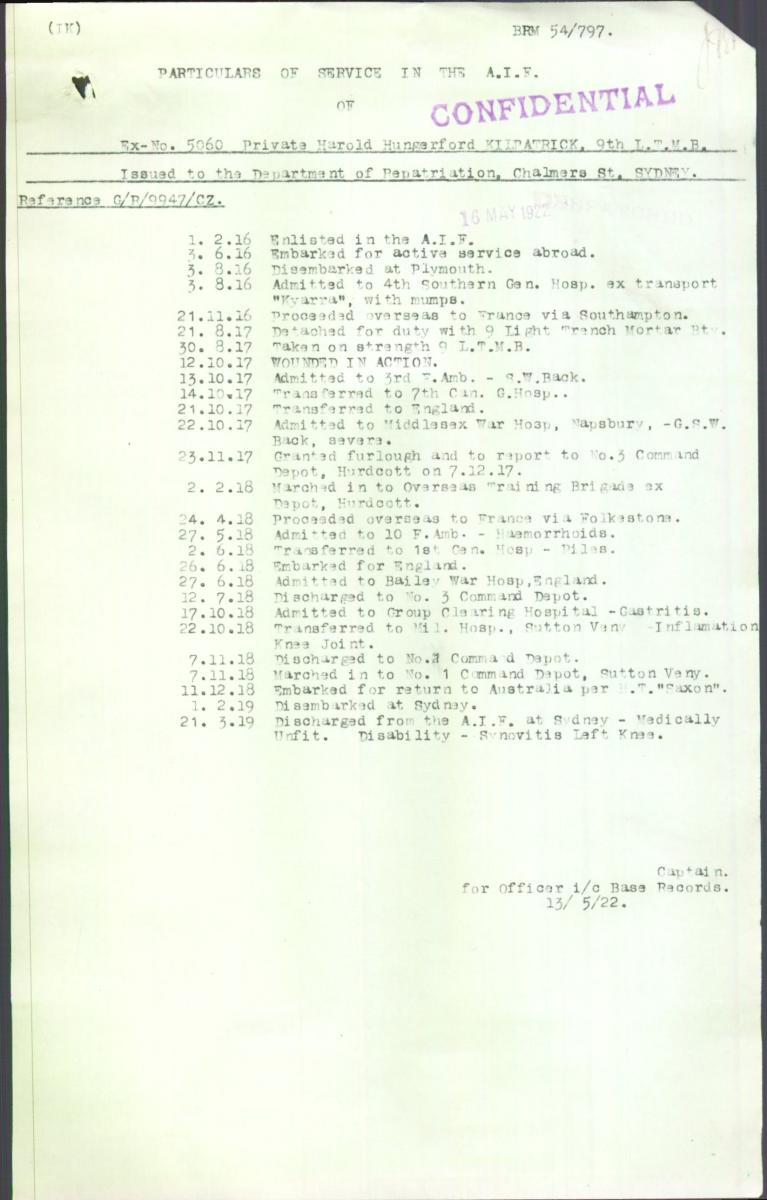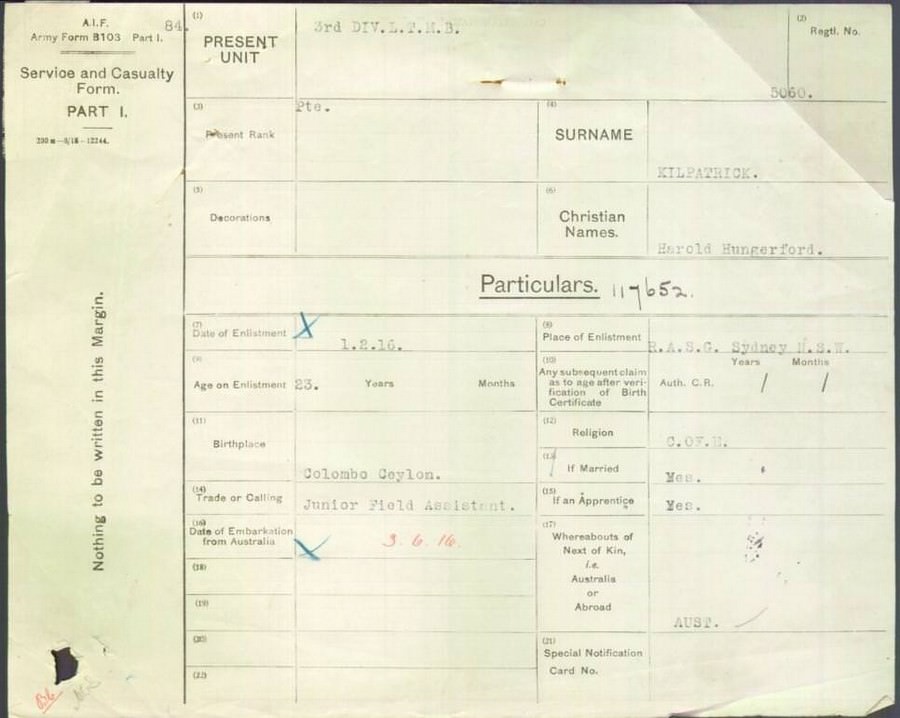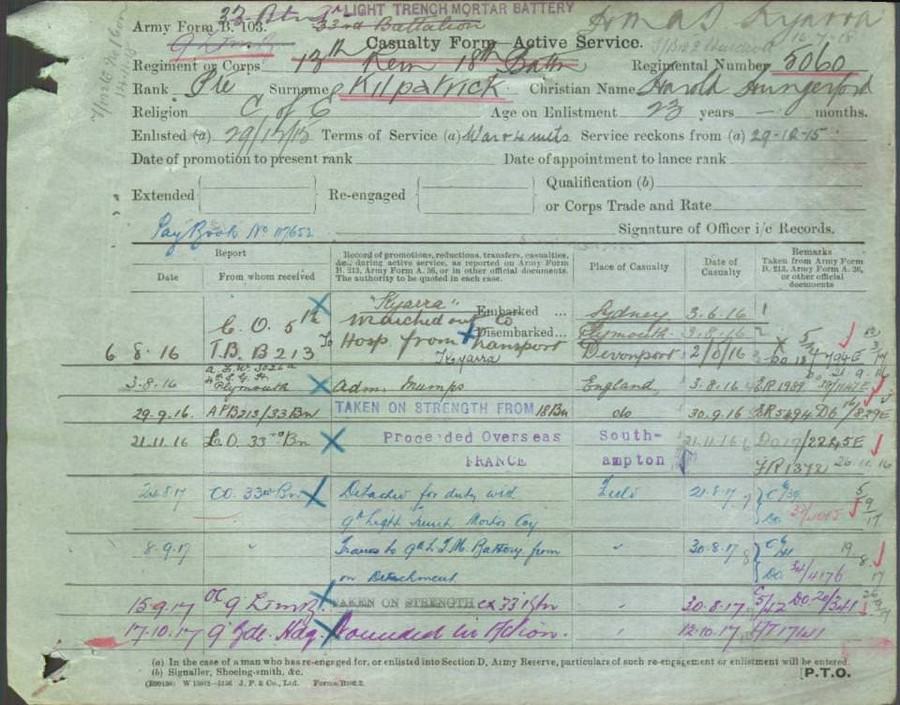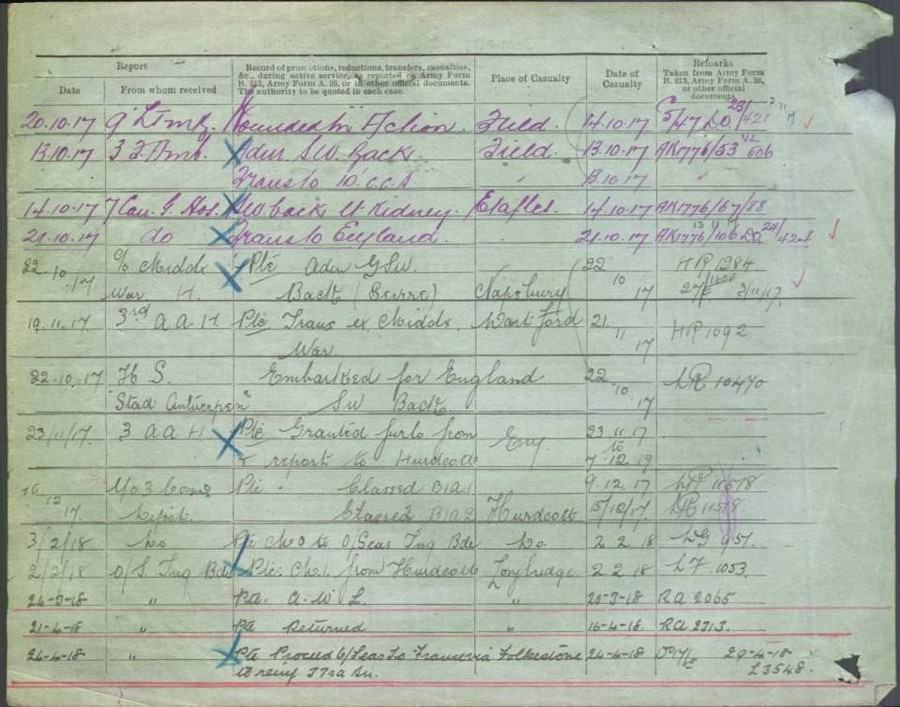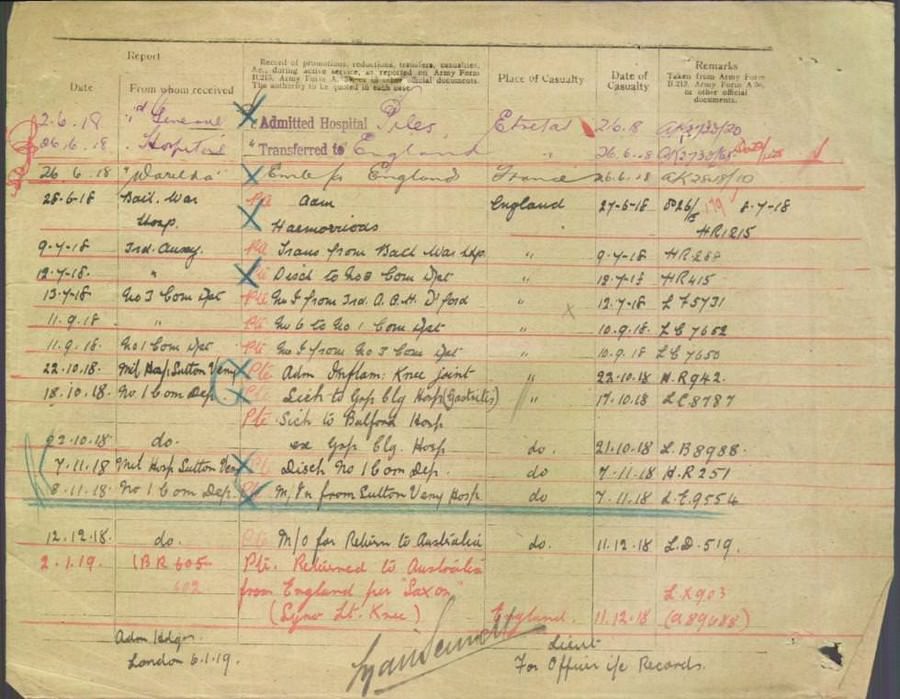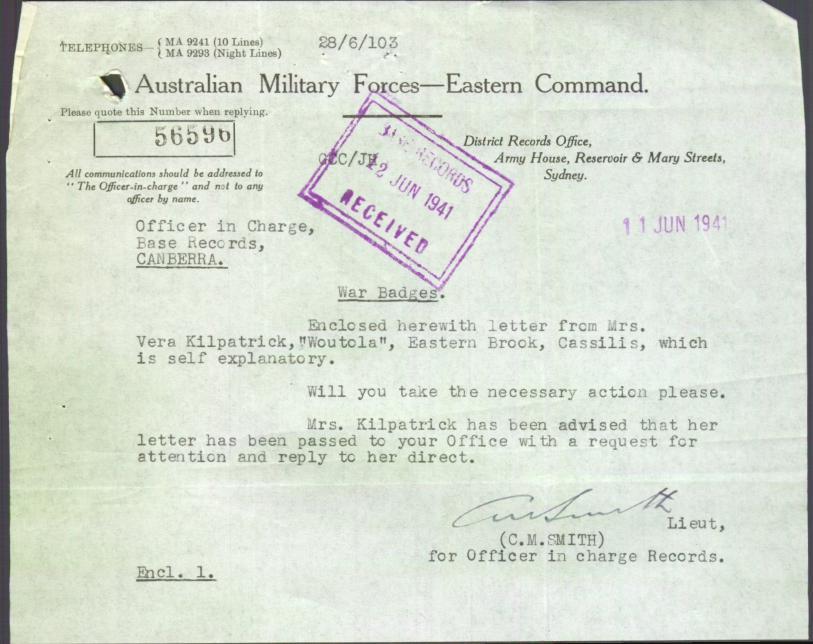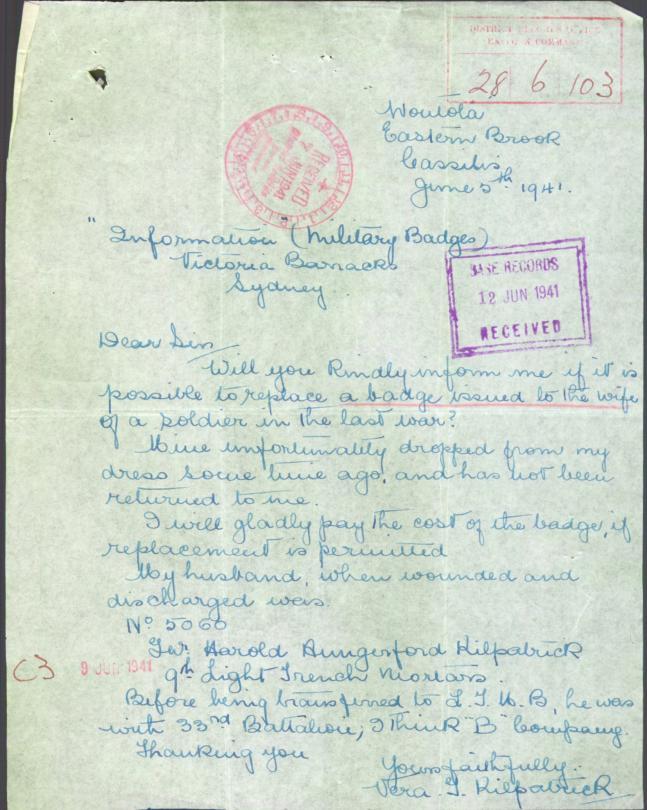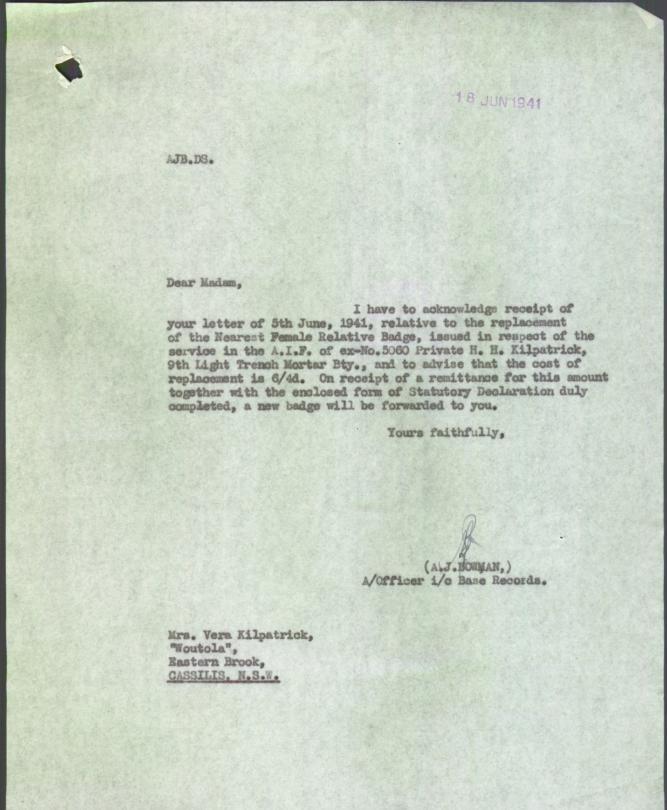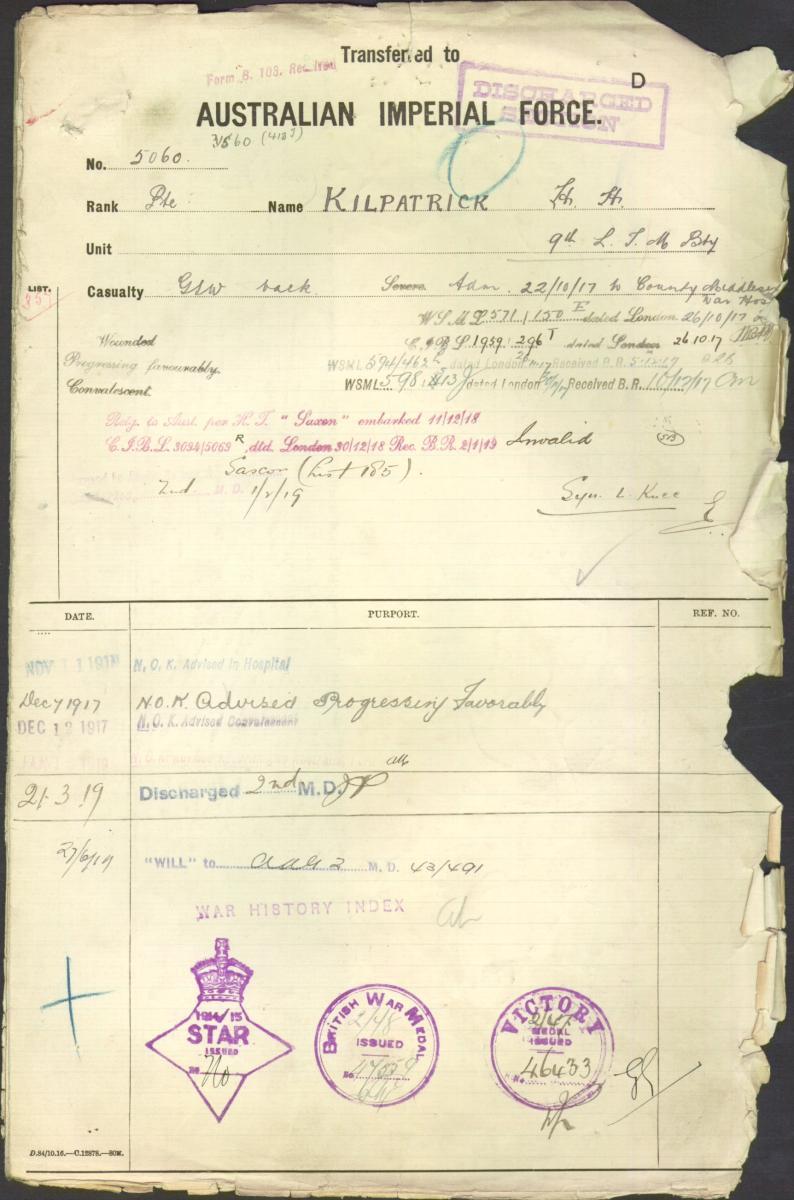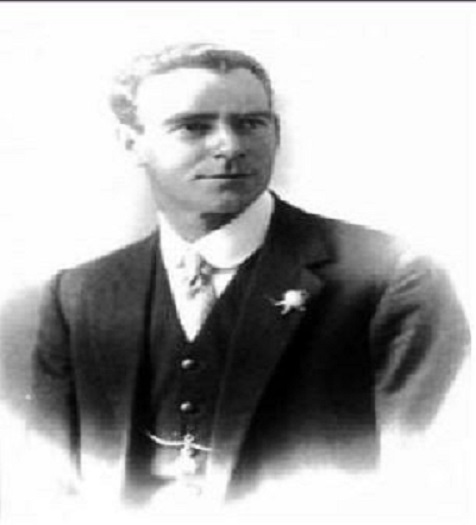
18th BATTALION - 36th BATTALION - 33rd BATTALION A.I.F.
Private: 6399 Alfred TIVEY.
Born: 1884. "Mole Station" Nimmitabel via Cooma, New South Wales, Australia. Birth Cert:24700/1884.
Died: 9th May 1918. Died of Wounds Villers-Bretonneux, France.
Father: Alfred Tivey. (1836-1883)
Mother: Elizabeth Ann Tivey. nee: White. (1849-1893)
INFORMATIONAlfred enlisted with the 18th Reinforcements 18th Battalion AIF on the 30th October 1916 and embarked from Sydney onboard S.S A29 "Suevic" on the 11th November 1916 and disembarked at Devonport where he was admitted to hospital. Alfred embarked form Capetown on board the "Anchises" on the 20th February 1917 and disembarked at Devonport England on the 27th March 1917. He went into camp with the 18th Battalion and proceeded overseas for France on the 23rd August 1917. Alfred was a member of the Nimity Belle Rifle Club and was transferred to 36 Battalion AIF, Rifle Battalion.
The bulk of the Battalion's recruits had enlisted as a result of a recruiting drive conducted amongst the RIFLE CLUBS of New South Wales by the Minister of Public Information in the New South Wales Government, Ambrose CARMICHAEL. Thus the Battalion became known as "CARMICHAEL'S THOUSAND". Carmichael led by example and enlisted as well, serving in the Battalion as a Captain.
Alfred was Taken on in Strength with the 36th Battalion AIF on the 1st September 1917 as the Brigade was preparing for the advance at Passchendaele.
12th October 1917
THE BATTLE OF PASSCHENDAELE I
At 1:30 am rain showers began. By 2:30 am it was raining lightly but steadily, by 3:30 fairly heavily. the infantry moved through the pitch dark in single file. In some battalions each man held on to the equipment of the man ahead of him; if touch was broken, those in front had to come back. The news that the line as reported by the 66th division was not held only just reached the incoming troops. Accordingly, in the right brigade (9th) the leading Company Commanders Captain: Clarence Smith JEFFRIES. V.C. and Captain: Telford Graham GILDER M.C. both of the 34th Battalion stopped their men at the entrance to Broodseinde railway cutting, and themselves went to make sure that their column might not run into the enemy.
At Keerselaarhoek Cemetery they found the tape duly laid, and met the officer of the 36th Battalion who had laid it, and by 3:00 am the time set, the 34th battalion was extended on its jumping-off position. But during the previous halt and afterwards, as it lay on the tape, the battalion was persistently shelled and suffered many casualties.
The first shell killed three signallers. Lieutenant: Albert Leslie WATSON. a signal officer of the 34th Battalion, a brave and enterprising leader who also was at the head of the column was severely wounded and all his staff hit. After establishing a forward command post Lieutenant: Thomas Fraser BRUCE 36th Battalion was also killed. Lieutenant Colonel: John Alexander MILNE. 36th Battalion supervising the assembly was knocked down by a shell but continued to command. Captain, Chaplain: Charles MURPHY was also wounded.
(BEAN; History of World war 1 Vol IV p911) Charles Edwin Woodrow BEAN
Only one Australian Division, the 3rd, was wholly employed in the days offensive. but the division was to capture Passchendaele an in spite of the depressing conditions, it was eager to achieve the distinction of doing so. One unit carried the Australian flag, to be planted in Passchendaele, and although officers and men in general were not enthusiastic concerning such "stunts" the Commander-in-Chief had been informed, and had told General: MONASH that, when this flag was planted, the news would be immediately cabled to Australia.
Some keen spirits looked on the operation simply as a dash for Passchendaele. One young company commander of Monash's reserve battalion, the 33rd, in face of a strict prohibition, led on his company as soon as the barrage fell. Starting from a line 350 yards in rear of the general alignment, the 3rd Division was out of touch with its neighbours from the outset. The heavy shelling on the tapes had made orderly disposition there almost impossible, as German Machine-Guns, undisturbed by the barrage now opened immediately, no opportunity offered of restoring proper formation.
The 9th Brigade went forward in the utmost confusion and a terrible mix up as reported by Captain: Robert Derwent DIXON D.S.O 35th Battalion at 6:40 am and "Great Confusion" was the description given by Captain: Henry Vince CARR 35th Battalion. Even on the ridge, the mud was difficult, the hope, if there ever was one, of catching up before the quick barrage finished.
The 9th Infantry Brigade's intended direction lay not along the ridge and the Passchendeale road, but diagonally across them, and parallel to the railway, which most of the brigade could not see. As the jumping-off line was practically at right angles to the ridge, the brigade tendered to advance alone the heights. The Machine-Gun fire at the start came, on the 9th Brigade's right, from the ruined house near Defy Crossing; on its center from, "Hillside Farm"; and on its left from Augustus Wood.
The pillbox opposite the center was supported from the rear by a trench in which were Germans with Machine-Guns, and here occurred a delay which threatened to wreck to whole attack. it was not until an hour after the program time that these places were rushed by the neighbouring portion of the line under Captain: Henry Vince CARR and Captain: Robert Derwent DIXON. D.S.O of the 35th Battalion. The trench contained 35 Germans and 4 Machine-Guns. Part of the line was also held up by a pillbox close to Passchendaele road near the highest point of the ridge.
Here there was practically no shelter from attack, but Captain Clarence Smith JEFFRIES. V.C. of the 34th Battalion managed to organise a party, with Sergeant: 21 James BRUCE and another N.C.O Corporal: 2036 Vere Cummings STEVENSON and a dozen men, and outflanking it, charged the place from the rear, capturing 25 Germans and 2 Machine-Guns. These actions set free the advance. The pillbox captured by Captain Clarence Smith JEFFRIES. V.C. being not far short of the first objective, the 34th Battalion dug in there.
Great loss had been uncured; the 34th Battalion had only three officers left and there were wide gaps in the line. The right flank had swung far away from the railway, along which the 4th Division was attacking, but on the left Captain: Telford Graham GILDER M.C. of the 34th Battalion who had been wounded by a Machine-Gun bullet, but was carrying on found the 10th Brigade digging in slightly to his left under Captain: LATCHFORD, 38th Battalion, and fell back seventy yards to join it.
The Advance to the second objective was to begin at 8:25, the low clouds had opened, and fleecy cirrus with patches of blue were widening overhead and the sun had come out. The 9th Brigade had been so late in reaching the first objective that, while most of the 34th Battalion dug in, the 35th Battalion, allotted for the second phase, moved straight on. Standing on the Passchendaele road, Captain: Henry Vince CARR and Captain: Robert Derwent DIXON. D.S.O of the 35th Battalion endevoured to decide where the barrage then was; at first Carr thought it may be behind them, but finally decided that it was ahead.
The confusion at the start had split the brigade into mixed parties of all battalions and many of the 34th went on with the 35th, the main body of which, about 100 in all, now advanced along the south-eastern side of the ridge in order to catch the barrage. The hour was probably a little before that for the second advance. A German Machine-Gun in the gap between the brigade's right and the railway immediately opened with deadly effect.
Major: John Bruce BUCHANAN 36th Battalion, the senior forward officer was killed. At this critical juncture Captain: Clarence Smith JEFFRIES. V.C. of the 34th Battalion, again accompanied by Sergeant: 21 James BRUCE, led out a few men from the first objective and made for the gun. it was shooting in short bursts, and he was able to work up fairly close. Seizing a moment when it was firing to the north, he and his men rushed at it from the west. It was switched round, killing him, and sending his men to the ground.
But when its fire eased they worked round it, rushed the position, seized 25 Germans and 2 Machine-Guns. This gallant and effective action Captain: Clarence Smith JEFFRIES. V.C. was posthumously awarded the Victoria Cross for removing the chief danger to the advance along the crest, but as soon as the 35th Battalion crossed to the eastern side of the hill it became the target of a number of field and heavy guns which, from the hedges and other cover in various parts of the landscape, fired over open sights.
After passing a corpse on its right, the 35th Battalion settled down on what its officers took to be the second objective, although on the extreme right they were actually short of the first. Captain: Henry Vince CARR, now the senior officer on the spot, reported; 8:35. On objective, with about 100 Captain: Robert Derwent DIXON. DSO and three officers. Casualties 25 or 30 per cent. Captain: Henry Charles Dight CADELL M.C Lieutenant: Charles Teesdale MAIN Lieutenant: Keith Maitland DAY reported killed and Lieutenant: Frank HORNE Lieutenant: Christopher Kyffin MEARS Lieutenant: Charles John HENRY were wounded. Prisoners sent back 400-500. Contact on flanks uncertain, being heavily shelled.
Three posts were established under surviving officers, right Lieutenant: Norman Beade D'ARCY M.C centre Lieutenant: Joseph Francis ADAMS left Lieutenant: Harold Sydney WYNDHAM. In this brigade the battalion for the final objective was the 36th, and a report came along that it had gone through. Actually, it had advanced with the 35th, but, on the left, penetrated to the second objective, which bad been reconnoitered during the previous halt by the commander of the company Captain Robert Austin GOLDRICK. M.C.
He went up the road towards Passchendaele. The barrage, he said afterwards was no hindrance to him, although he left the line lying as close to it as possible "or where he thought it was." He was unable to detect the intensification of the barrage for the second phase, but led his men forward at the proper hour.
As no other battalion was there, he now established the line with its left on the road 600 yards from the church, about the point reached by the 66th Division's troops on October 9th. In front of the position Captain: Robert Austin GOLDRICK. M.C. and Lieutenant E.H FLEITER (39th Battalion) found hidden in a shell hole men of the 66th Division. One had a broken arm, the other trench-feet. They took the Australians at first for Germans. When reassured,"we knew the Australians would come," they said, 'We prayed hard."
From the direction of the church, which lay straight down the highway, no fire came. two Germans ran up the road and surrendered. South-east of the village, along the Moorslede road, were the Germans who seemed "very windy," and near the road two 5.9-inch howitzers began to blaze at the troops digging in.
The 9th Brigade had taken its second objective and the 10th its first, but the position of the officers in charge of these advanced lines was full of anxiety. On the eastern slope Captain: Henry Vince CARR 35th Battalion, the senior officer in this part of the 9th Brigade's front, could see the 4th Division somewhat ahead of its right, and by 10:55 he had discovered that the 36th was on the left, but farther left than the 10th Brigade was far behind on its first objective . The German Guns ahead were sniping with dreadful accuracy. Carr on the western slope, sent back for instructions: "what am I to do?"
Word of the true situation reached headquarters slowly. As on the 9th, the first news was all encouraging. General: MONASH in the Ypres ramparts heard shortly after 7 that both brigades were "well away"; but by 8:26 he had ample evidence that the first objective was taken. At 9:25 the intelligence officer examining prisoners (Lieutenant: Frederick Morley CUTLACK Official War Correspondent) reported having heard from the wounded men that the second objective had been reached.
At 10:28 headquarters was informed of a statement of a wounded man, that the 38th Battalion had gone through. A further report that Australians had been seen at Crest Farm although quickly contradicting but probably true nevertheless. Which confirmed Monash's impression that his division was succeeding. Concerning the New Zealand brigade on his left, however, there was no word until, at 10:50, there arrived the tragic information that the New Zealand Division was stopped by the enemy alone the entire front.
Monash has already heard at 9:55 that the 10th Brigade was held up by fire from Bellevue Spur. Believing that his division was still advancing, he asked that every gun that the New Zealand Division could spare should be turned upon that ridge to suppress the fire. Meanwhile, he would order the reserve (39th) battalion of the 10th Brigade to be ready to assist in holding the ground already won. The reserve battalion the (33rd) of the 9th Brigade he was still keeping back to assist in the capture of Passchendaele.
Shortly after noon news of the true situation arrived. Lieutenant Jackson of the 40th Battalion had established at Waterfields pillbox near the Ravebeek a forward report-centre from which a series of messages, admirably accurate, was flashed by lamp to the headquarters of Lieutenant Colonel Lord of the 40th Battalion. Thus Brigadier General McNicoll of the 10th Brigade was able to inform Monash of the precise position of Giblin's Line. He added that the situation was very serious and the casualties very heave. At the same time from the front line of the 9th Brigade arrived a pigeon message, sent by Captain: Richard GADD of the 36th Battalion.
We are on the Blue Line (second objective) with composite force all three battalions, both flanks in the air.
The New Zealand Division was to make a second attempt at 3:00 pm, and Monash was of the opinion that from the 9th Brigade, well forward on the ridge, patrols might still work northward around Crest Farm. His reserve, the 33rd Battalion (9th Brigade), was accordingly ordered to attempt this at 4:30 pm and the 10th Brigade's forward line being meanwhile reinforced by its own reserve, the 39th Battalion.
These orders went out, but none of them were fulfilled. The New Zealand Division had been defeated by obstacles which no hastily renewed bombardment could have overcome. no infantry in the world could have crossed the Ravebeek mud, penetrated the dense wire, and attacked the crowded pillboxes of Bellview with the assistance of a barrage which did not even screen the advance. No blame can attach to the artillery. Its commander, according to the New Zealand official history, had reported on the previous day that his guns might be unable to give efficient support.
This magnificent division, which lost nearly 3,000 men, had been held up in almost exactly the same position as the 49th three days before-the left brigade penetrating half-way to the first objective, the right stopped almost at the start. The Germans were reinforcing. The New Zealand battalion commanders knew that their men had no chance of succeeding by renewed attack, and the order was eventually cancelled.
As for the Australians, of the two battalions that MONASH had now ordered to participate, the 39th had already to a large extent been involved in the fighting, and the 33rd, endevouring to reach its position of readiness for outflanking Passchendaele, had suffered great loss. No less than 6 of its Officers were killed or mortally wounded. Captain: Wilfred Frank HINTON in command of the forward company, Lieutenant Leonard Rockley BROWNLOW Lieutenant: Thomas Acheson ARMSTRONG Lieutenant: Albert George KILPATRICK Lieutenant William REES-REYNOLDS and Lieutenant: Norman Francis GOBLE.
By the time Lieutenant Colonels Henderson DSO 39th Battalion and MORSHEAD attempted to carry Monash's orders, they found that the attacking force of both brigades was back almost at its starting point. What had happened was as follows.
Neither Major: GIBLIN near the Ravenbeek nor Captain: Henry Vince CARR on the ridge had received their messages sent several hours earlier. The 9th Brigade's line was still being battered by the German Guns. Captain: Richard GADD 36th Battalion, whose troops were being wiped out, informed Captain: Henry Vince CARR 35th Battalion that Lieutenant Colonel: John Alexander MILNE D.S.O 36th Battalion had now come forward to Hillside Farm. CARR accordingly sent Captain: Robert Derwent DIXON. D.S.O with GADD to explain to Milne the desperate nature of their situation. Milne said that he would try to get their troops relieved after dark, but till relieved they must hold on.
(BEAN; History of Word War 1 Vol IV page 921) Charles Edwin Woodrow BEAN
Meanwhile, however, the German artillery was annihilating some parts of their line. All leaders of Carr's three posts were out of action. Lieutenant: Joseph Francis ADAMS was Killed in Action and Lieutenant: Norman Beade D'ARCY M.C and Lieutenant: Harold Sydney WYNDHAM were wounded. Of the remaining officers of the 36th Battalion, Major: John Bruce BUCHANAN and Lieutenant: Fredrick William PUTNEY had been Killed in Action and Captain: Robert Austin GOLDRICK M.C wounded. Farther back Lieutenant: Sydney COOK had been Killed in Action and Lieutenant: William WAND and Lieutenant: Herbert Reginald MAILER were wounded.
At 3 o'clock rain began to fall steadily. at 3:15 pm Captain: Richard GADD 36th Battalion, thought agreeing with Captain: Henry Vince CARR 35th Battalion that to hold on meant annihilation, refused, in view of his Colonel's orders, to retire. Carr consented to wait while Gadd again sent word to Lieutenant Colonel: John Alexander MILNE D.S.O. Carr himself at 12: 30 had sent Captain Robert Derwent DIXON. D.S.O to the headquarters of the 35th Battalion at " Seine", from which no word had been received all day.
At 3:45 pm, no reply having come from Milne, and Dixon not having returned as he had been kept at 35th Battalion headquarters awaiting the arrival of an order from brigade headquarters concerning the projected operation by the reserve battalion, Gadd agreed to withdraw and Carr sent along the line a note: The 35th Battalion will retire.
When visiting Gadd, Carr had warned the troops of the probable order to withdraw, and he now saw that the left had already begun to retire. He told men whom he passed to get back as fast as they could to the 34th Battalion (which he believed to be on the first objective). Captain: William James GORDON M.C 36th Battalion, strongly dissatisfied with the order, went straight to Lieutenant Colonel: John Alexander MILNE D.S.O urged that the forward position was tenable, and with Milne and Major: John Martin HAWKEY M.C rushed out to stop the withdrawal. But it was too late.
The 34th was not, as Captain: Henry Vince Carr 35th Battalion, believed, on the first objective. The Commander of the line, Captain: John William RICHARDSON 34th Battalion, on hearing of the extreme weakness of the force at the second objective, had reinforced it. He and his only remaining officer's Lieutenant: James Clement BURGES Lieutenant: Bruce Gray McKENZIE Lieutenant: John Abbott LONGWORTH had all been Killed in Action while organising on the first objective, and the first objective now lay empty. The retiring troops, being without orders as to the position to be taken up, streamed back past Milne's headquarters.
All that Hawkey, Gordon, Gadd, and others could then do was to lead a fraction of them forward again to the first objective, where they remained during the night. Captain: Robert Derwent DIXON. D.S.O. with Captain: John Grieve PATERSON adjutant of the 35th, went up to organise the 35th there, but could find none of it's men. When eventually re-formed the remnant of the 35th was temporarily attached as a Company to the 33rd Battalion.
9th-12th October 1917 saw the 3rd Division, 9th and 10th Infantry Brigade in action during the Battle of Passchendaele, which saw massive losses and suffering in the Australian ranks. The casualties numbered 3,199 men in 24 hours during the height battle. The 34th Battalion lost every officer that day, either killed or wounded including their Medical Officer, Major: Gother Robert Carlisle CLARKE and some of his staff were killed while dressing the wounded. The spirit of some of the wounded is illustrated by the case of Corporal: 3170 Winsleigh Alexander MURRAY 35th Battalion, (formerly a Methodist Minister from Newcastle) gave up his place in a queue waiting for stretcher bearers and was never heard of again.
The Battle of Passchendaele saw 60 Officers and 1,322 other ranks loose their lives.
9th Infantry Brigade Casualties.
| 33rd Battalion. AIF |
11 Officers |
273 Other ranks |
| 34th Battalion. AIF |
15 Officers |
323 Other ranks |
| 35th Battalion. AIF |
18 Officers |
296 Other ranks |
| 36th Battalion. AIF |
15 Officers |
383 Other ranks |
| 9th Machine Gun Company. AIF |
1 Officer |
36 Other ranks |
| 9th Light Trench Mortar Battery. |
- Officer |
11 Other ranks |
13th October 1917.
Received instructions to take command of the front line. Issued instructions to C.O's 34th and 35th Battalions to re-organize at dawn and to hold as follows; 35th Battalion Right Battalion. 36th Battalion Center Battalion. 34th Battalion Left Battalion. This was done and consolidation proceeded with shelling of our position immediately in rear of it was at times very heavy. 5.9-4.2 and 77 mm being used. Our bombardment of enemy points appeared to be very light and our barrages throughout the battle much lighter than any yet experienced by this battalion.
On the other hand the Boche bombardment was the heaviest I have ever experienced and only the very soft ground smothering the shell bursts very few men would have got through it. This Battalion was relieved by the 44th Battalion 11th Bde A.I.F. Relief commenced about 7:00 pm and was complete about 11:00 pm. The Battalion moving back along Railway Line to BOSTON FARM. The Battalion to up a shell hole position near JACOB'S HOUSE. All ranks very exhausted.
14th October 1917.
Resting
15th October 1917.
Moving up to front line and relieved 42nd Battalion in support at AUGUSTUS WOOD relief being complete by 7:00 pm. Enemy heavily shelled our position and ABRAHAM HEIGHTS with 5.9-4.2 and wizz bang a few 8" being noted and much Gas Shell (Mustard)
16th October 1917.
Consolidation position. Heavy shelling still continues with much Gas Shell during hours of darkness. A few men led back practically blind from the Gas effect.
17th October 1917.
Heavy shelling during early hours of morning with conditions much the same as 16th. Very few casualties considering weight of Boche shelling. New Zealand troops caught it heavy on ABRAHAMS HEIGHTS.
(36th Battalion War Diary)
17th October 1917.
Brigade Transport Lines near CAVALRY FARM were bombed by enemy aeroplanes. Two horses were killed and three wounded. Enemy shelled Batteries near Brigade Headquarters constantly throughout the afternoon. On the 18th of October Brigade Transport Lines were again bombed by enemy planes. Two grooms wounded, 1 horse killed and 1 horse wounded.
(9th Infantry Brigade War Diary)
4th April 1918.
A heavy burst of shelling occurred at CACHY and on some 6" Howitzer Batteries situated under cover of the S.E. corner of the BOIS D'AQUENSE, at about 3.30 am. At 5.30 am the fire thickened to heavy and general shelling, counter battle work and harassing fire suggestive of preparations for an attack. Just before 6.00 am shells fell in the wood near our bivouacs. The troops were hastily got out into the open. The shelling continued to be very heavy for about two hours, in the course of which two men were killed, and Lieutenant: 927 John LANG and 8 other ranks were wounded.
At 9:00 am orders were received to "Stand To" as it was expected the enemy would attack. At 11.45 am orders were received to proceed to position of readiness at U.5. central (South of VILLERS-BRETONNEUX) for defense of the village. Moved at 11.55 am and arrived at position of readiness without casualty despite general shelling of the area crossed. Lieutenant: Sydney Horace NEWELL (Scout Officer) reported direct to C.O. 35th Battalion, who was defending the line in part of the attack area. As the position of readiness the Battalion took up a position on the reverse slope of the hill on the east side of the VILLERS-BRETONNEUX - HANGARD ROAD, with "A" and "B" Companies just below the crest, "C" Company in close support, and "D" Company in reserve.
At 1.45 pm the C.O. and Adjutant reported to the C.O. 35th Battalion, at VILLERS-BRETONNEUX the village was being heavily bombarded. At 2.30 pm the Adjutant returned with the preliminary instructions to the 2nd in Command and the C.O. awaiting developments. At 4.45 pm the C.O returned with information that the Bosch had broken through the English line and was advancing on the village. While he was speaking heavy bursts of Machine Gun fire sprayed over the hill. English troops had been retiring for half an hour through our line but efforts to stop them were in vain.
The C.O ordered "A" Company and "B" Companies to immediately counter-attack. They did so with great spirit and in fine style sweeping along the southern end of the RAILWAY LINE. A party of English troops were seen to be reforming on our right. The Adjutant was sent with an invitation to their C.O to join in a Counter-Attack. Brigadier General: WOOD of the 55th Brigade was found to be Commanding in person and he immediately agreed, and went forward on the right flank of our "C" Company. In the advance great progress was made by "A" Company on the left under Captain: John Edward Wallace BUSHELLE who imbued them with wonderful Spirit and Confidence by his gallant leadership.
Owing however to organized opposition from special M.G. strong points in an orchard and two hay stacks "B" and "C" Companies were not able to keep up to the line of "A" Company's advance and wide gaps were left between all the Company frontages by reason of the extended front on which it was necessary to deliver our Counter Attack. The Reserve Company was however sent up to reinforce the center, link up the Companies, and, as far as possible, straighten out the line. Two small Companies of the 6th London Regiment who appeared at the time were also sent into the gap between "A" and "B" Companies and our gain was consolidated. Tools and ammunition were hastened forward by a small party from Headquarters - signallers, batman, police and gas personnel, - and this party brought back wounded on the return trip, doing excellent work.
36th Battalion War Diary
4th-5th April 1918
The First VILLERS-BRETONNEUX
The Strength of the 9th Infantry Brigade was about 2,250 but their casualties during the 2 days of fighting numbered 30 Officers and 635 men either killed in action or missing.
9th Infantry Brigade Casualties.4th-5th April 1918
| 33rd Battalion. AIF |
3 Officers |
82 Other ranks |
| 34th Battalion. AIF |
5 Officers |
120 Other ranks |
| 35th Battalion. AIF |
9 Officers |
282 Other ranks (including 44 missing) |
| 36th Battalion. AIF |
12 Officers |
133 Other ranks (including 1 missing) |
| 9th Machine Gun Company. AIF |
1 Officer |
18 Other ranks (including 4 missing) |
12th April 1918.
Just after dawn (at 6:00 am) the enemy opened a barrage along our front and to our right on the French. The French S.O.S. went up immediately and was answered by a heavy barrage. Very soon the whole of the forward areas and the immediate rear was screened by heavy smoke from the enemy barrage which consisted principally of 5.9's and 4.2's. At about 7:00 am the fire slackened and it was learnt that the French had been pushed back on our immediate right and partly out of HANGARD. Reinforcements for the French came along the slope of the hill on our right flank till almost level with our line and then went half right over the hill into HANGARD. Enemy Machine Gun's attempted enfilade fire on those troops from the BOIS de HANGARD, but "C" Company on the left stopped this by rifle and Lewis Gun fire.
The line was shelled heavily several times during the day. At 7:30 pm the French, West Kent's and Essex counter attacked on our right. The barrage was lighter than in the morning. Fire died away about 8:30 pm and it was learnt that the line on the right had been re established and in some parts had gone further than the position lost in the morning. The Battalion was relieved by the 18th Battalion AIF commencing about 10:00 pm and was completed at 1:30 am, the Battalion then moved to billets in the BOIS de BLANGY where a hot meal awaited them.
At 1:09 pm a 5.9 Howitzer Shell landed in Battalion Headquarters and killed Lieutenant Colonel: John Alexander MILNE. D.S.O., Captain: Thomas Rodger MacNEE, also the Adjutant of the 5th Essex Regiment and 6 other ranks; the same shell wounded Major: John Ambrose McDOWELL. and 3 other ranks.
(36th Battalion War Diary)
Private: 2179 Denis "Denny" SHERRY. 36th BN AIF. Killed in Action 12/04/1918. Villers-Bretonneaux, France.
Private: 1257 William Halkyn WESTWOOD. 36th BN AIF. Killed in Action 12/04/1918. Villers-Bretonneaux, France.
Major: Francis George GRANT. D.S.O. 33rd Battalion and Major: Albert DUNLOP of 9th Brigade Headquarters, brought the Battalion out the billets above mentioned and "handed over" to Lieutenant Colonel: Harold Fletcher WHITE. C.M.G. D.S.O. Croix de Guerre
13th April 1918.
Private: 1155 Claude Hastings KERRISON. 36th BN AIF. Died of Wounds 13/04/1918. Villers-Bretonneaux, France.
Alfred was transferred to the 33rd Battalion AIF on the 30th April 1918 when the 36th Battalion was disbanded to reinforce the 33rd-34th and 35th Battalions. Alfred was Taken on in Strength with the 33rd Battalion
5th May 1918.
The Nucleus garrisons with the exception of 2 men per post rejoined their Companies during the afternoon. The men rested during the day and that evening moved up to the left Battalion Sector to assist the 35th Battalion in operations to advance their line by taking the trenches held by the Bosche opposite. Two Companies of 33rd Battalion, B and C Companies were to hold the Line. A and D Companies to provide carrying parties for the attack.
A Company carrying from 35th Bn H.Q to forward dumps in the front of 35th Line and D Company from there to the new position. Zero hour was 11:45pm when it turned out to be extremely dark and raining lightly. Despite this everything went well. The objective was taken and also the support trench, 200 yards further on. 3 Officers and 165 other ranks, 9 Machine Guns and 3 Trench Mortars were captured. Many casualties were inflicted on the Enemy both by the barrage and the advancing troops.
The Line was advanced on a front of 1500 yards to a depth pf 800 to 900 yards and a much better position occupied than that previously held. Carrying Parties. A Company employed 2 Officers and 45 other ranks. D Company employed 3 Officers and 45 other ranks. Stores carried. Bombs, 20 boxes. S.A.A. 12,000 rounds. French wire, 48 coils. Screw pickets, 200. Barbed wire, 60 coils.
Time spent - 5 hours. The No: 1 and 3 carrying parties of D Company encountered parties of Bosche in the German Front Line that had not been mopped up. These were dealt with without casualties. 1 N.C.O. and 10 men detailed by 35th Bn to carry for the 9th A.L.T.M. Battery, 8 men from A Company also detailed for Stretcher Bearers.
(33rd Battalion War Diary)
Alfred was Wounded in Action on the 7th May 1918 when he received a Gun Shot Wound to his Chest and was treated by the 11th Australian Field Ambulance before he was evacuated from the lines by Stretcher Bearers and carried to the 61 Casualty Clearing Station where he died of Wounds on the 9th May 1918.
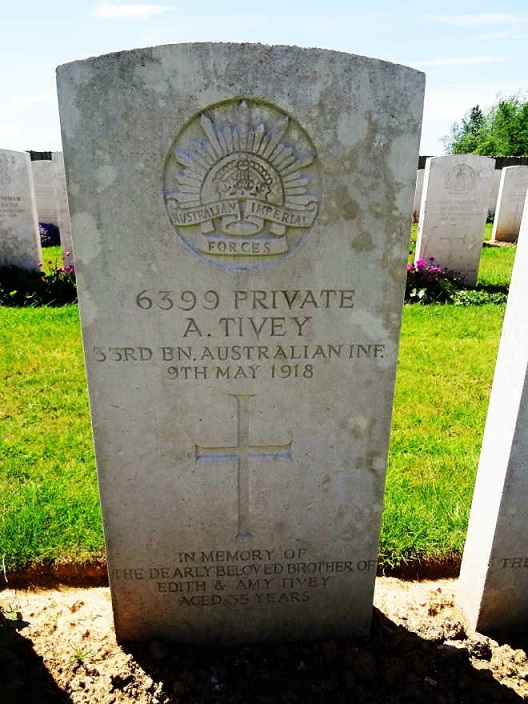
Alfred is remembered with honour and is commemorated in perpetuity by the Commonwealth War Graves Commission at the Vignacourt British Cemetery, France.
 Family InformationAlfred was a single 32 year old Selector from Bundanoon, N.S.W. upon enlistment and was a member of the Nimity Belle Rifle Club. His parents Alfred and Eliza Tivey were married in 1868 at Nimmitabel via Cooma, N.S.W. and had 8 children. Edith Tivey born 1869 at Nimmitabel, N.S.W. Birth Cert:9852/1869 and died in 1959 at Bega, N.S.W. Death Cert:1510/1959. Francis Tivey born 1871 at Nimmitabel, N.S.W. Birth Cert:9156/1871 and died in 1961 at Bowral, N.S.W. Death Cert:29952/1961. Ellen M Tivey born 1875 at Nimmitabel, N.S.W. Birth Cert:9935/1875. Lilian Tivey born 1877 at Nimmitabel, N.S.W. Birth Cert:10472/1877 and died in 1893 at Nimmitabel, N.S.W. Death Cert:11091/1893. (Twins) Ruby Rebecca Tivey born 1879 at Nimmitabel, N.S.W. Birth Cert:11893/1879 and Pearl Rosa Tivey born 1879 at Nimmitabel, N.S.W. Birth Cert:11894/1879. Amy Violet Tivey born 1881 at Nimmitabel, N.S.W. Birth Cert:20820/1881. Alfred Tivey born 1884 at Nimmitabel, N.S.W. Birth Cert:24700/1884 and died in 1918 at Villers-Bretonneux, France.
Family InformationAlfred was a single 32 year old Selector from Bundanoon, N.S.W. upon enlistment and was a member of the Nimity Belle Rifle Club. His parents Alfred and Eliza Tivey were married in 1868 at Nimmitabel via Cooma, N.S.W. and had 8 children. Edith Tivey born 1869 at Nimmitabel, N.S.W. Birth Cert:9852/1869 and died in 1959 at Bega, N.S.W. Death Cert:1510/1959. Francis Tivey born 1871 at Nimmitabel, N.S.W. Birth Cert:9156/1871 and died in 1961 at Bowral, N.S.W. Death Cert:29952/1961. Ellen M Tivey born 1875 at Nimmitabel, N.S.W. Birth Cert:9935/1875. Lilian Tivey born 1877 at Nimmitabel, N.S.W. Birth Cert:10472/1877 and died in 1893 at Nimmitabel, N.S.W. Death Cert:11091/1893. (Twins) Ruby Rebecca Tivey born 1879 at Nimmitabel, N.S.W. Birth Cert:11893/1879 and Pearl Rosa Tivey born 1879 at Nimmitabel, N.S.W. Birth Cert:11894/1879. Amy Violet Tivey born 1881 at Nimmitabel, N.S.W. Birth Cert:20820/1881. Alfred Tivey born 1884 at Nimmitabel, N.S.W. Birth Cert:24700/1884 and died in 1918 at Villers-Bretonneux, France.

This rather Grand looking house can be found at Mole Station, Nimmitabel, New South Wales in Australia. This photo was taken around 1910 and features (amongst others) Elfreda May Tivey (1905), Frank L Tivey (1907) , Jack N Tivey (1902) ,Mabel Tivey nee Elphick (1876) and Francis Tivey (1871). The house originally belonged to Samuel Tivey and his wife Phoebe Wild who emigrated there in 1848. This photo was greatfully received from Angela Jones (Tivey) who is the grand daughter of Frank L Tivey. "The style of the house is Federation characterised by bull nosed verandahs and dark colours. I think the two parts of the house at either end would have been a sandstone type stone, but definitely not weatherboards like the main house. The gardens had lots of English type flowers and often had a circular driveway with a round flower bed in the centre. In the really wealthy gardens more often than not there was a fountain and other statues throughout the garden."
Alfred's first cousin was Brigadier General: Edwin TIVEY. C.B.-C.M.G.-D.S.O.-V.D. Commanding Officer 5th Australian Division. (1866-1947)
Military Records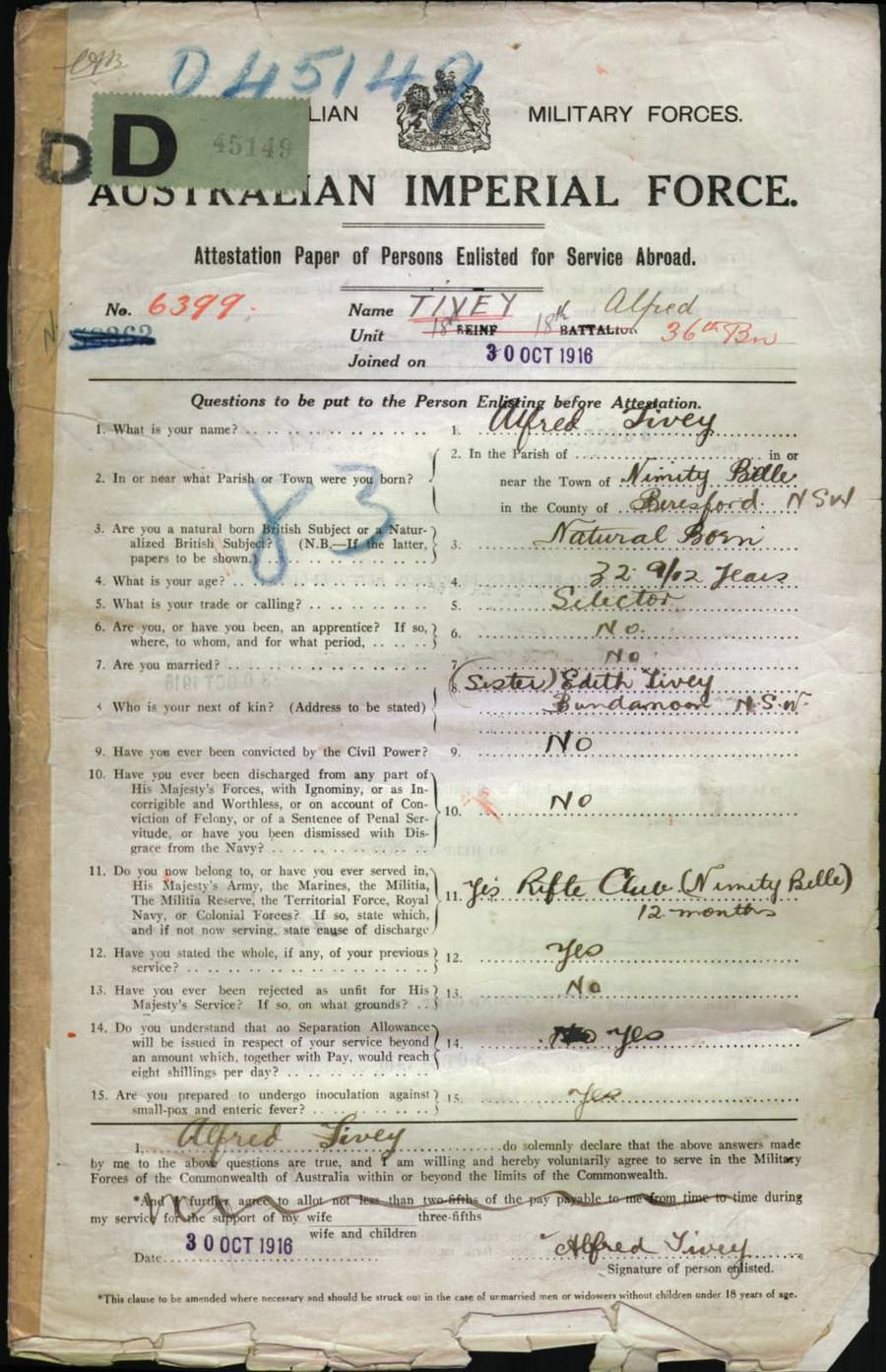
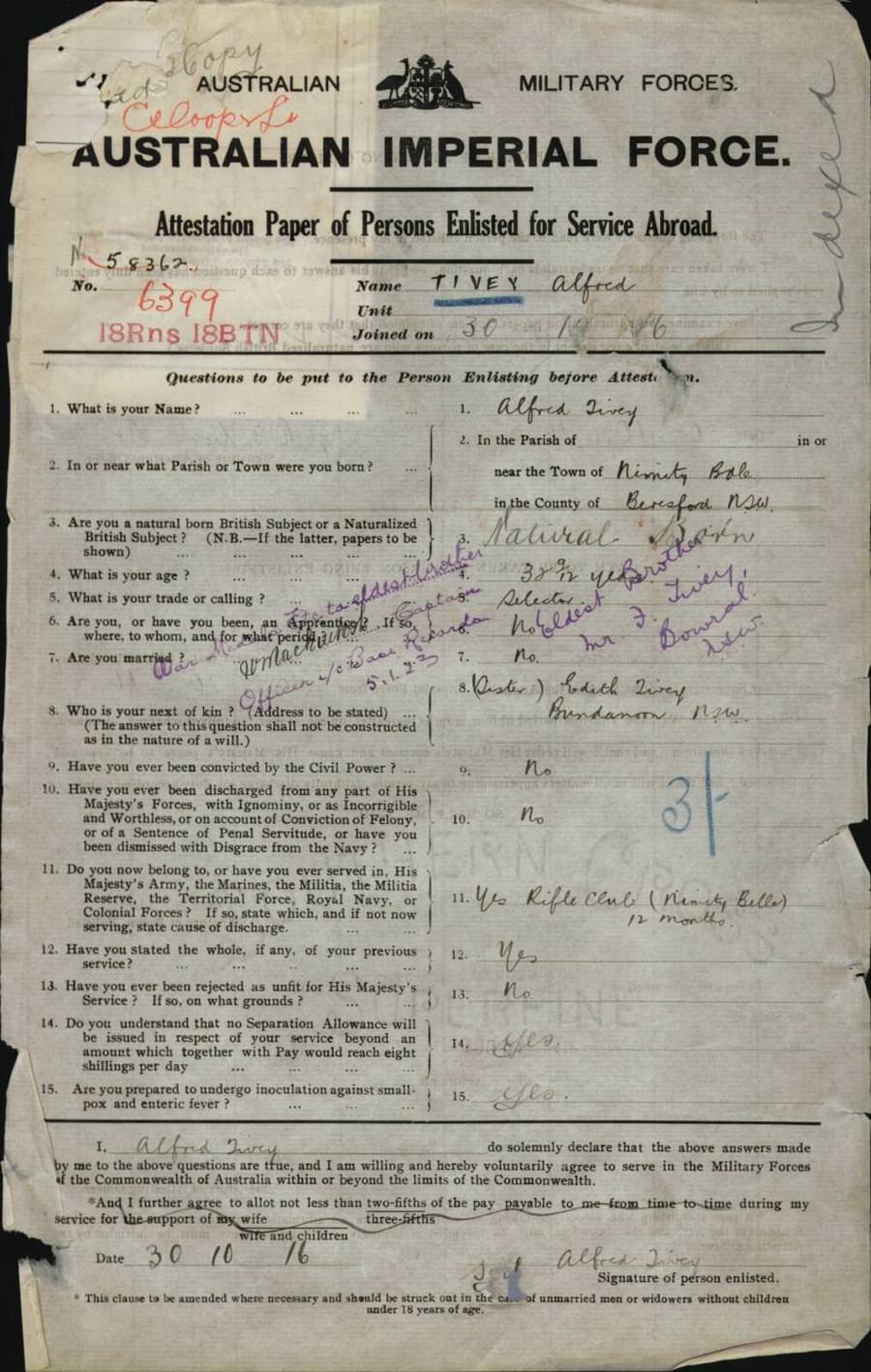
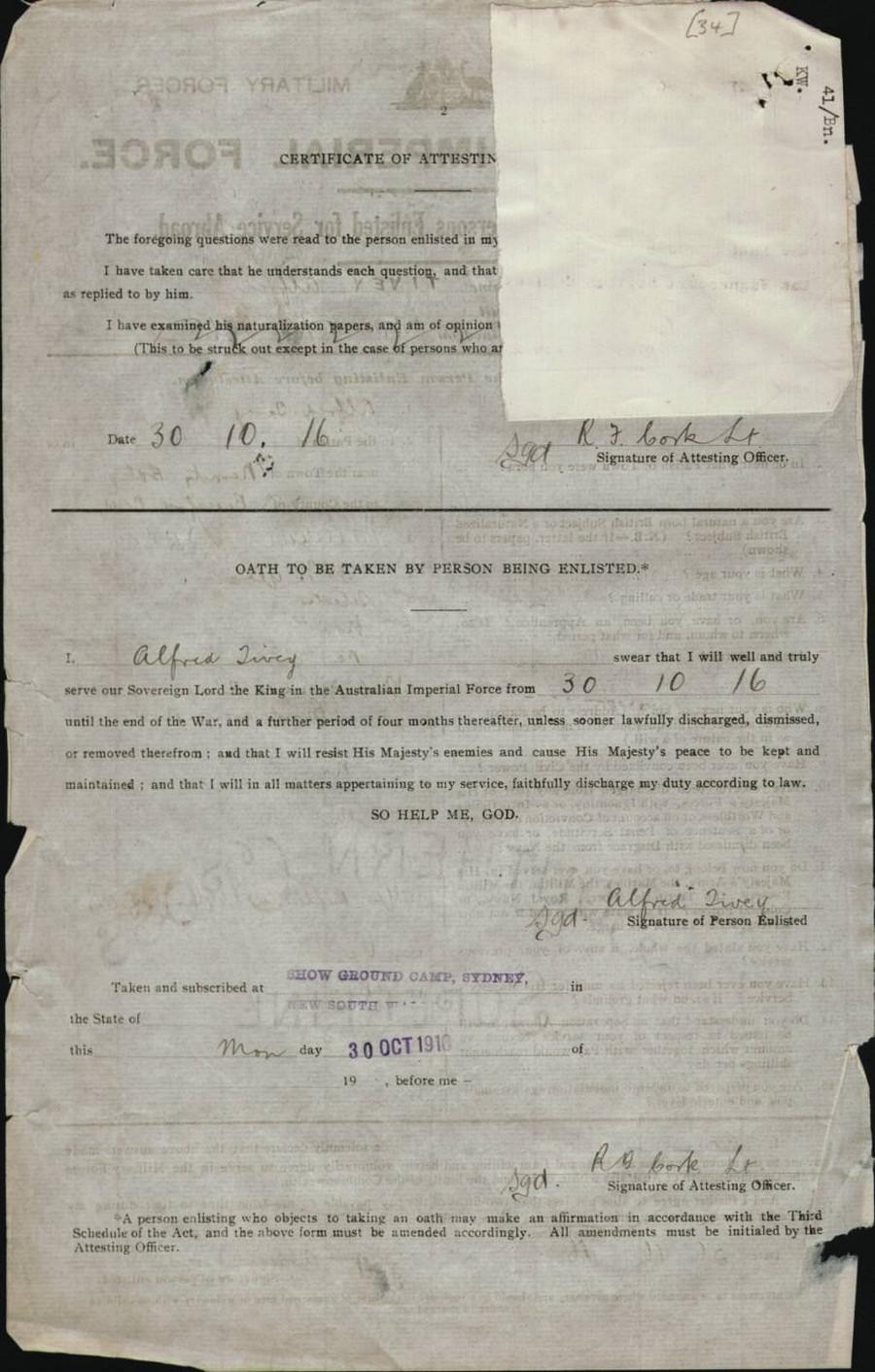
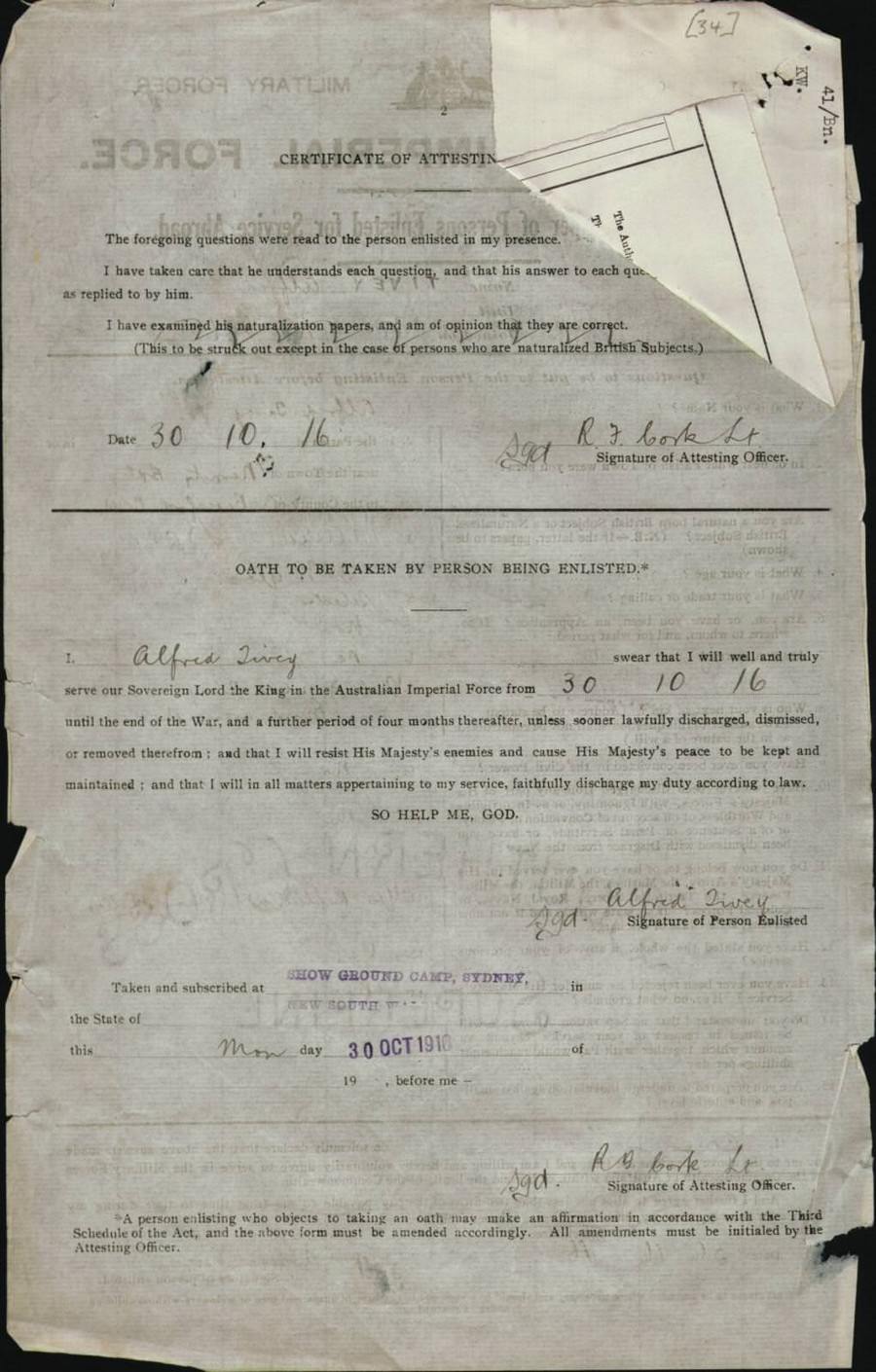

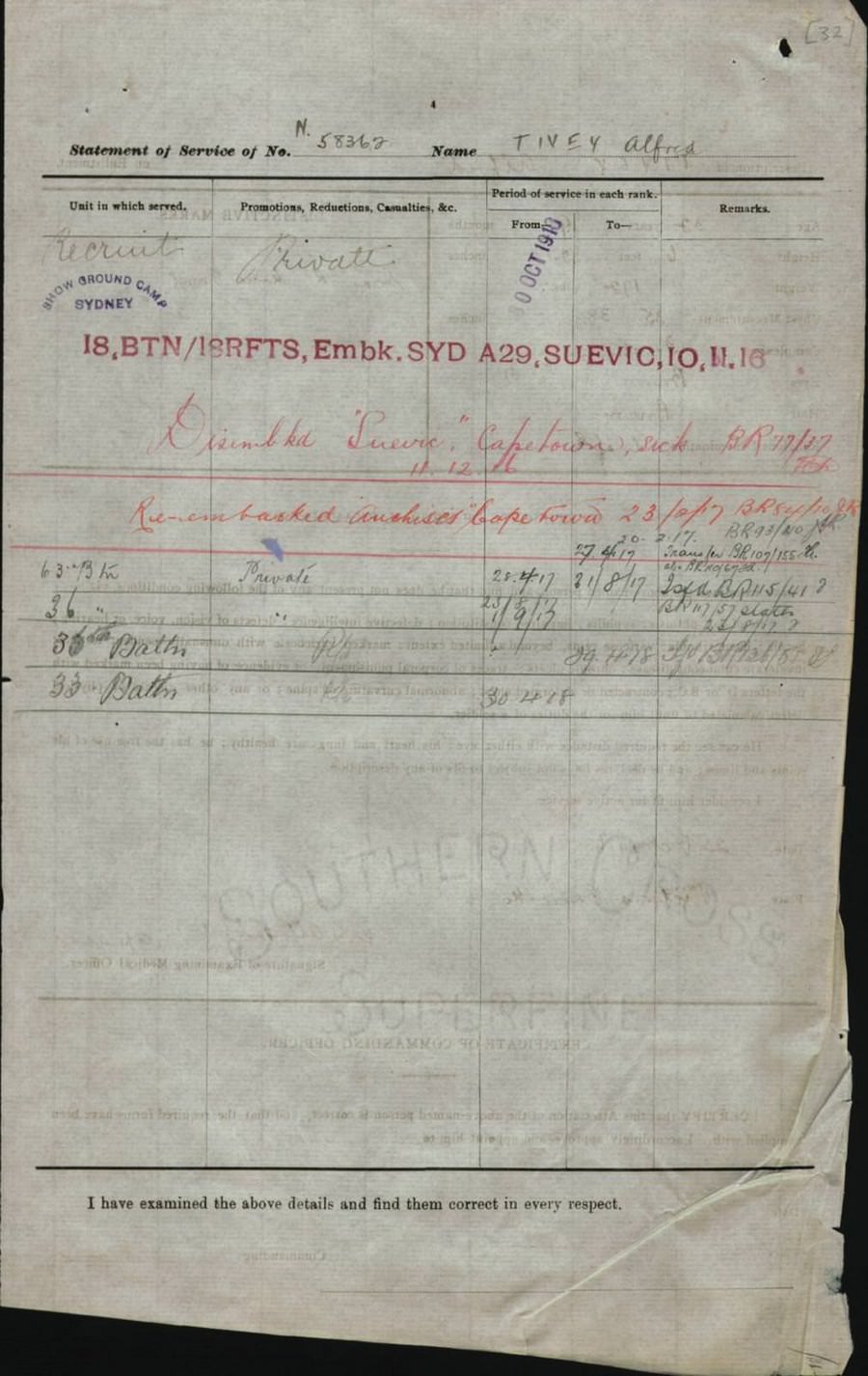
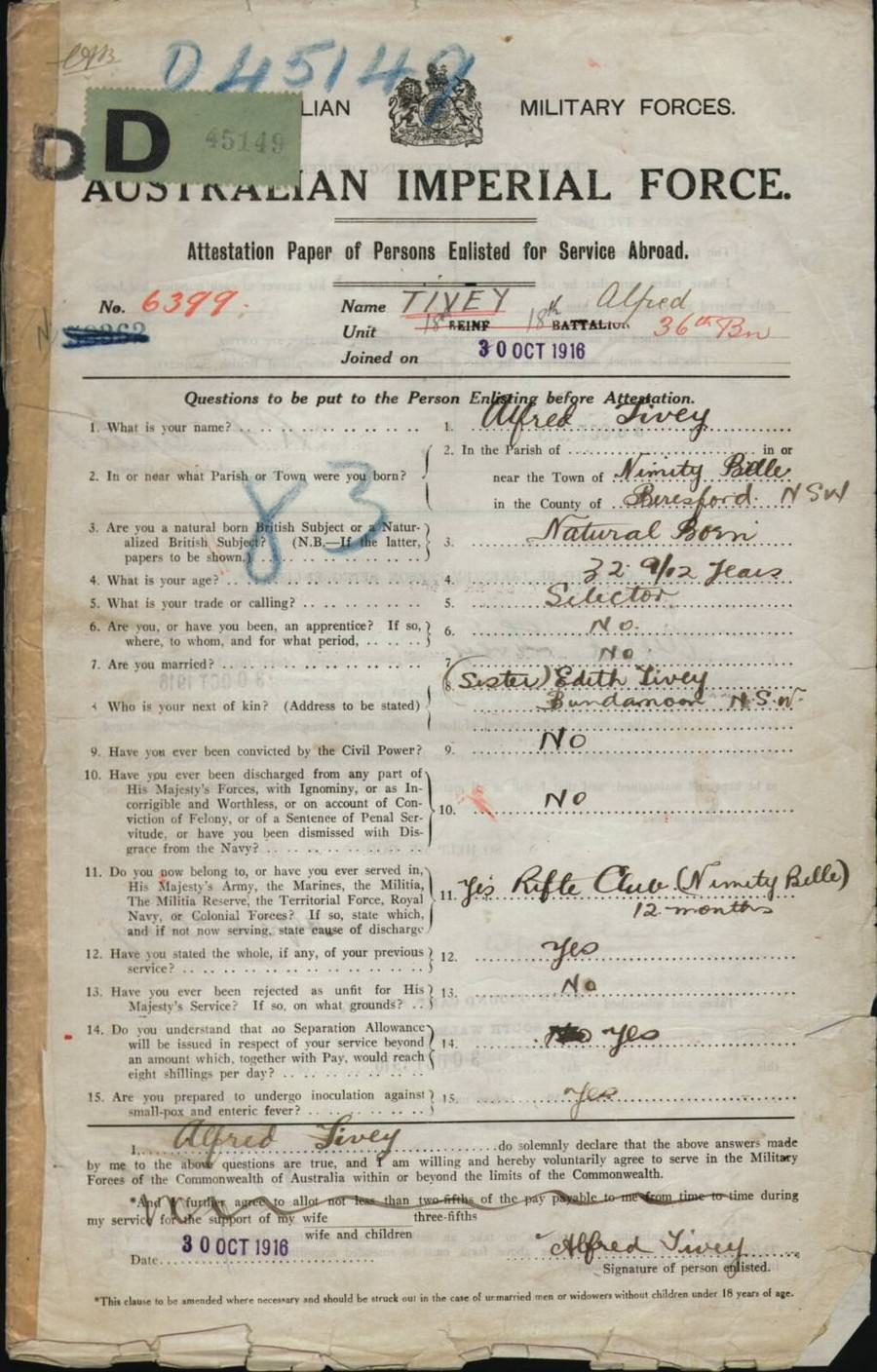
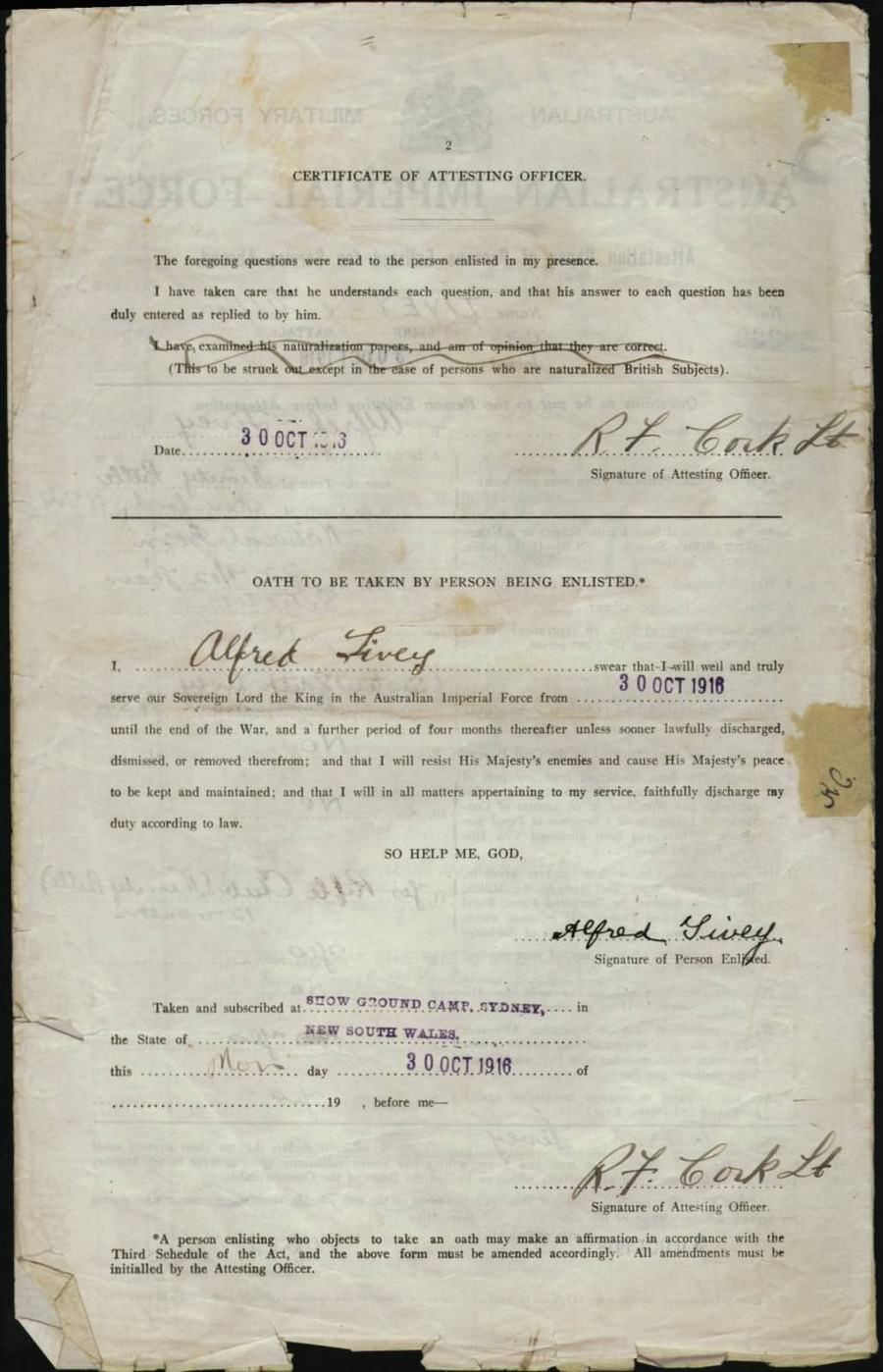
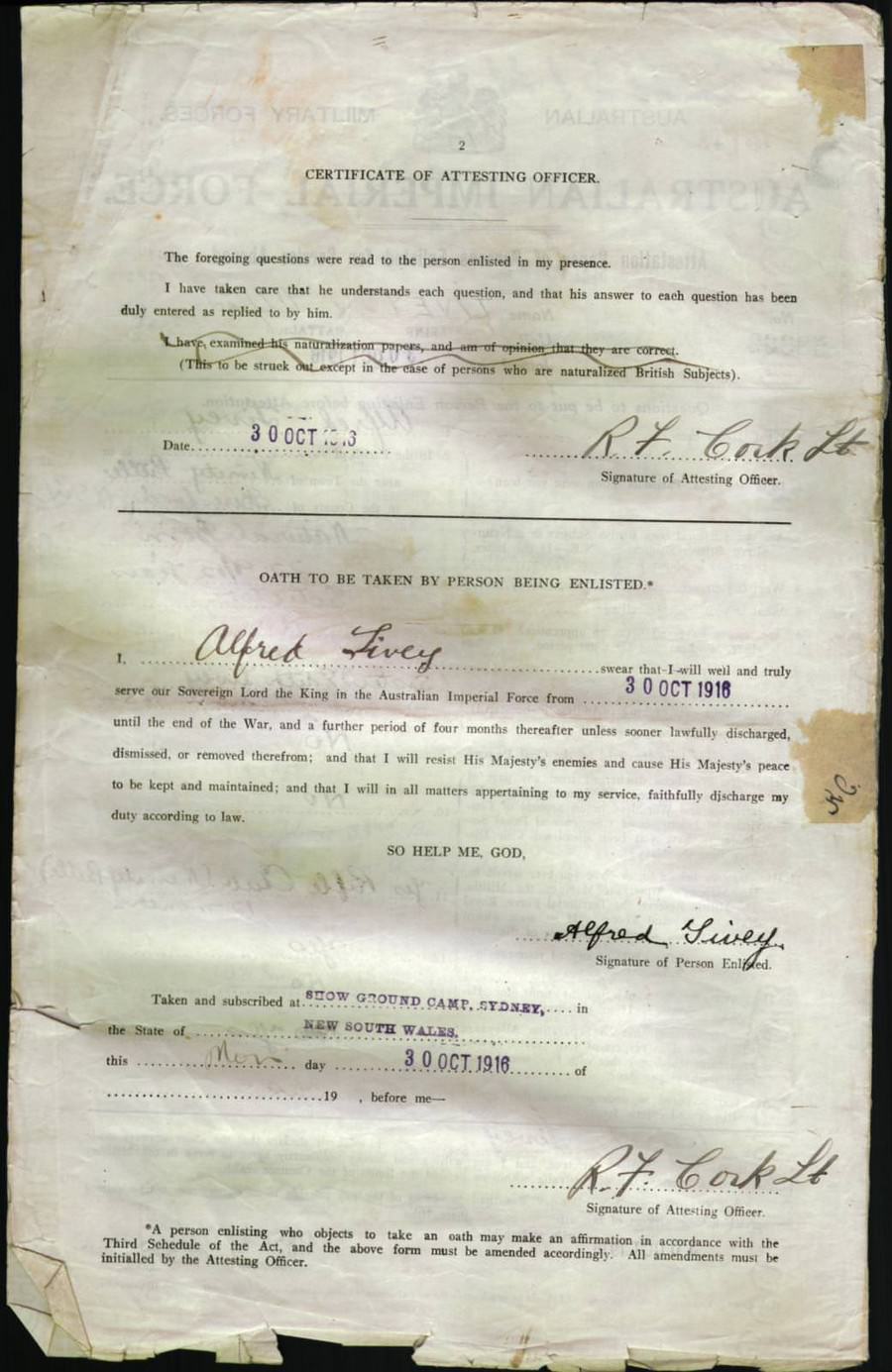
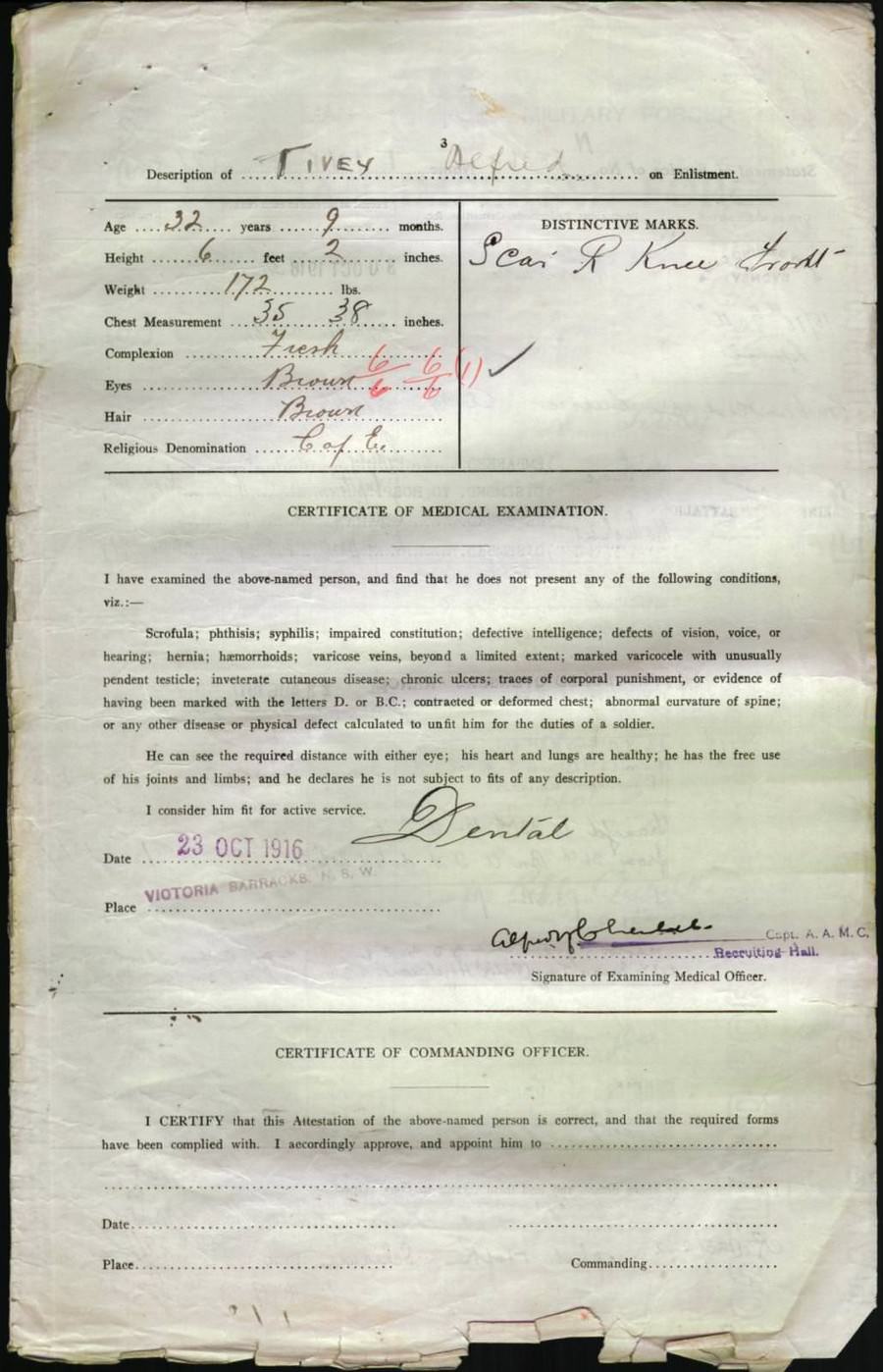
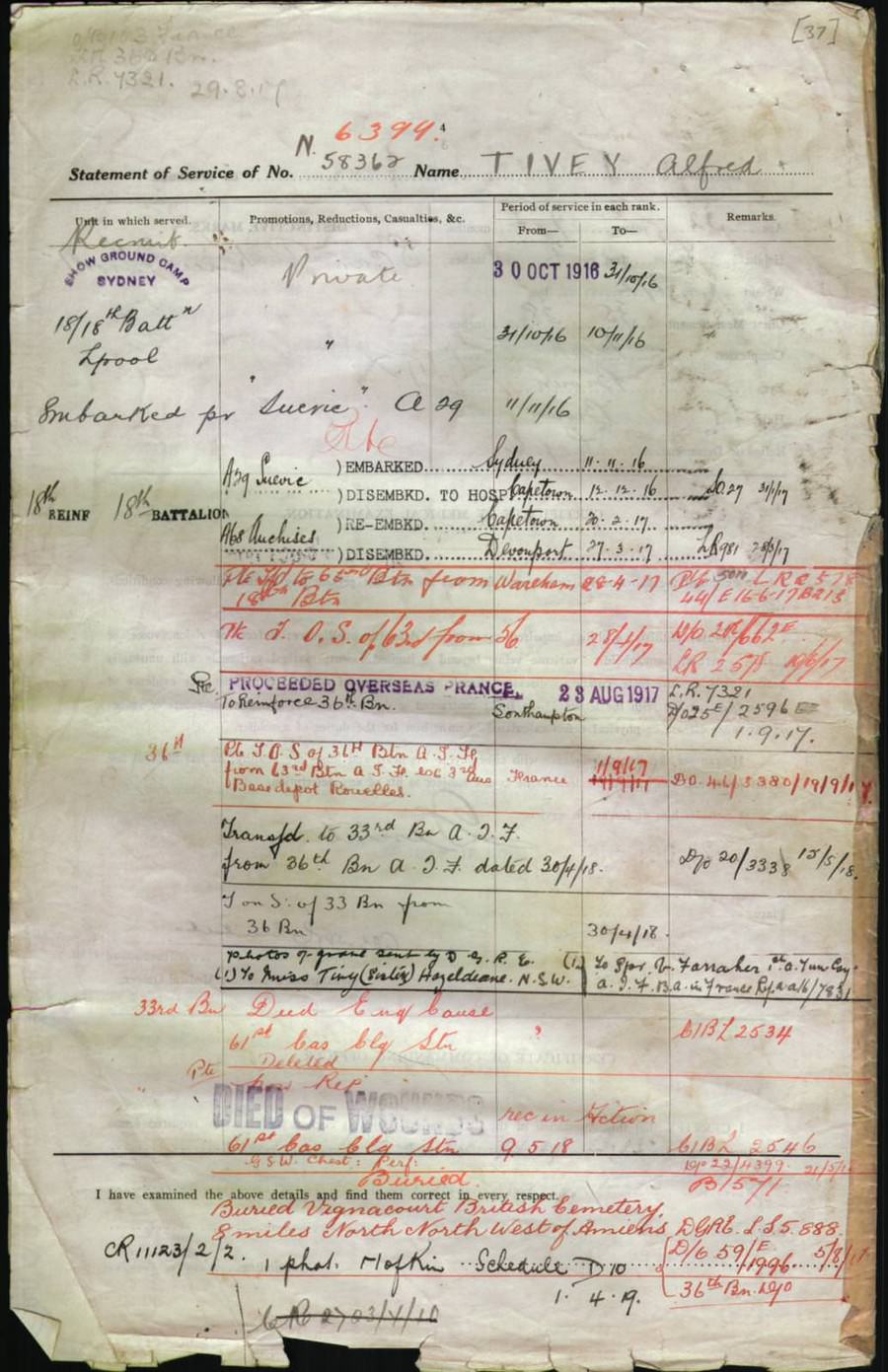
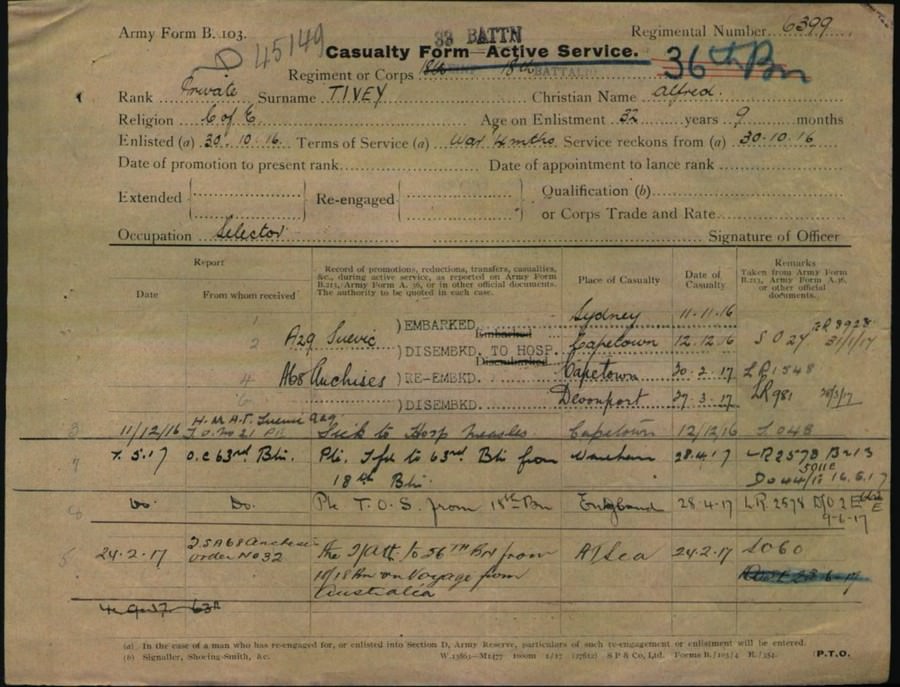
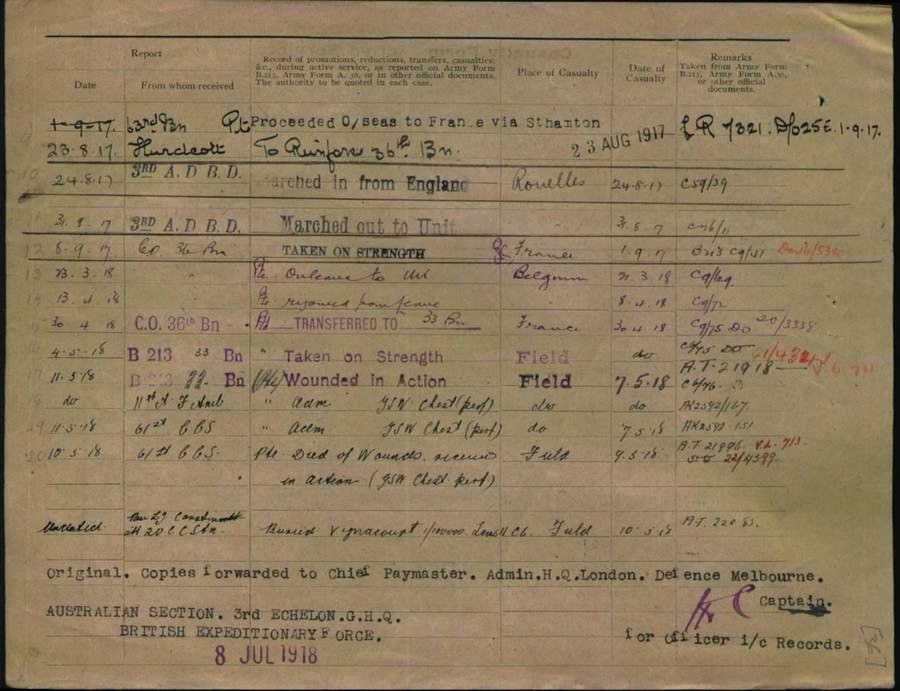
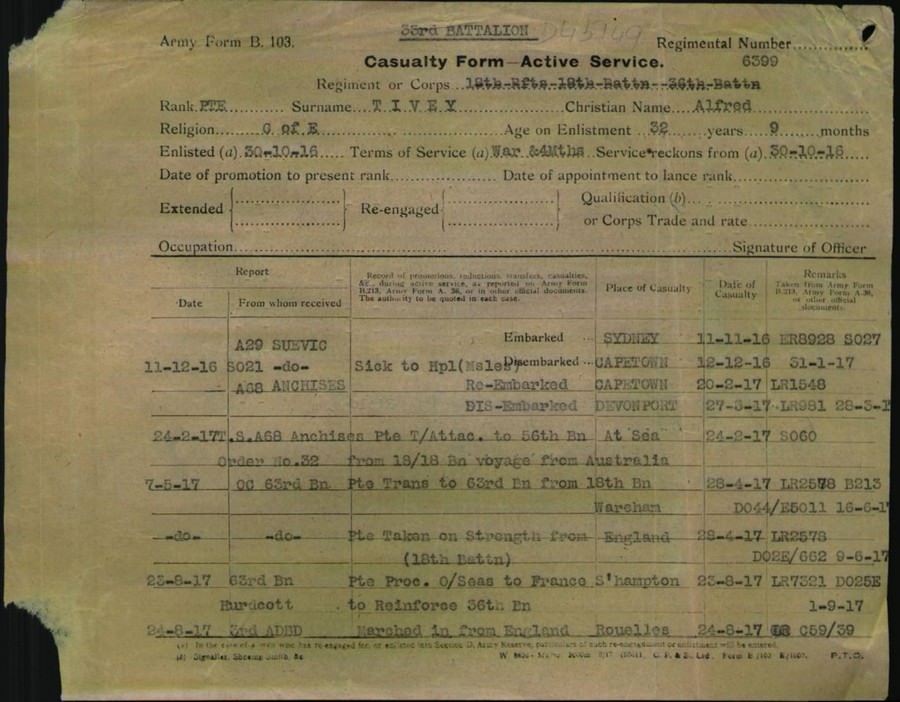
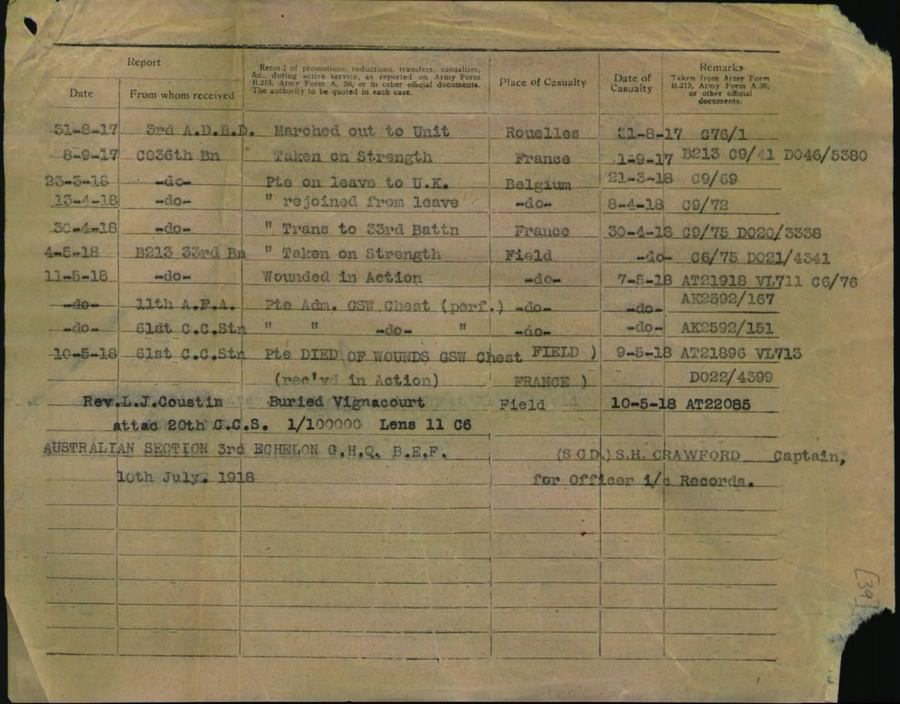

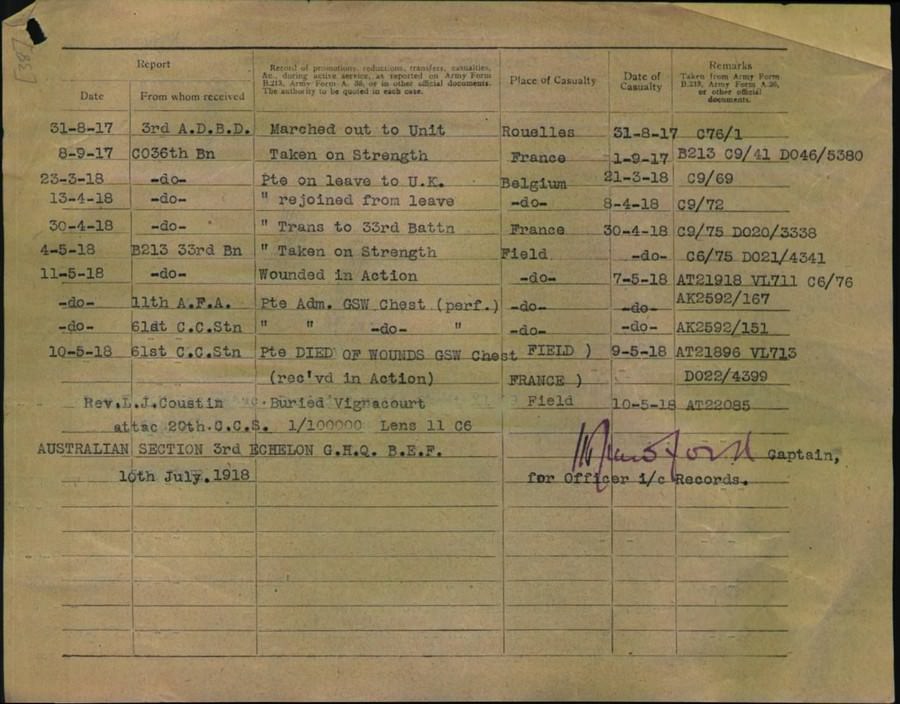
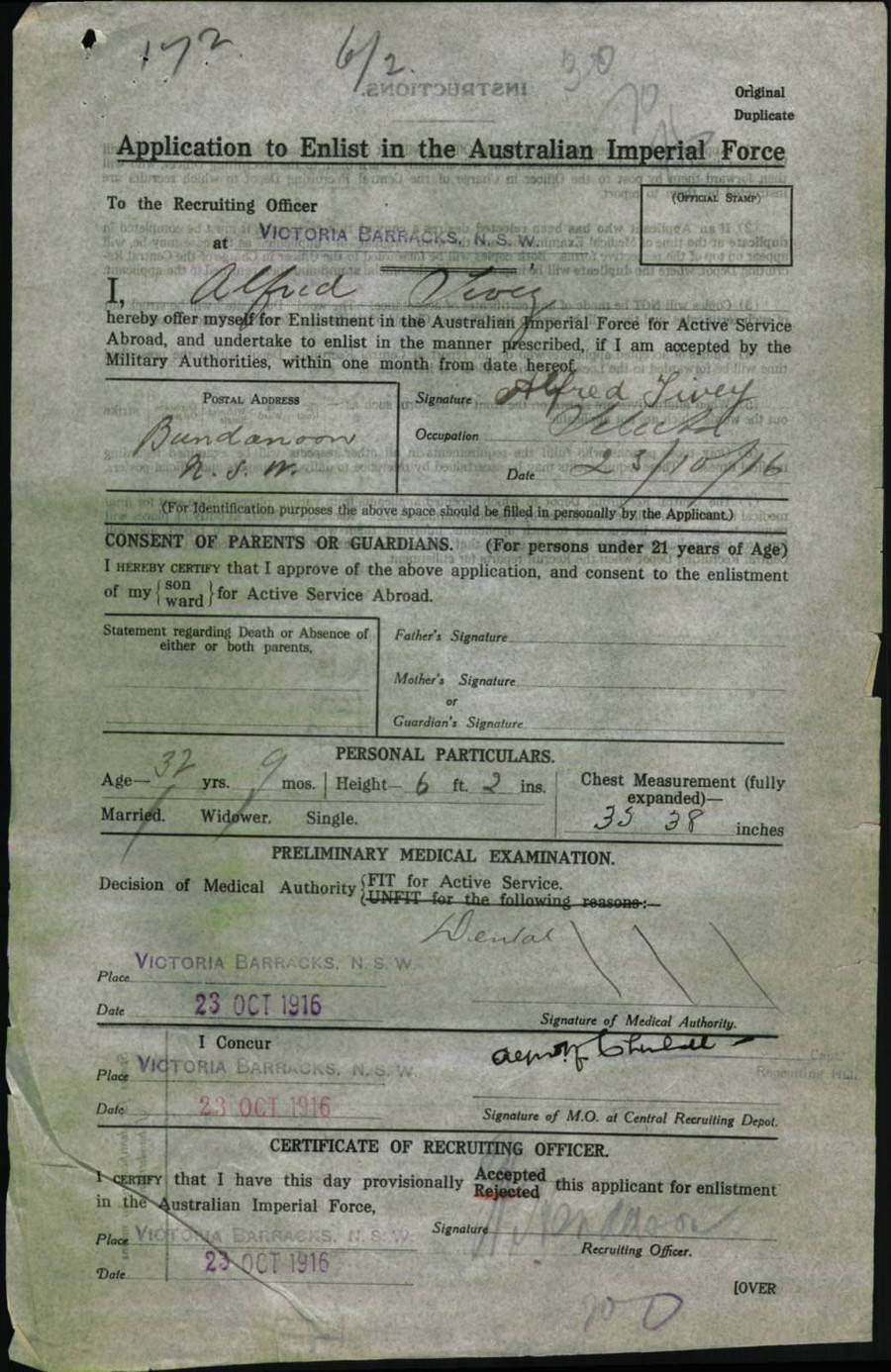
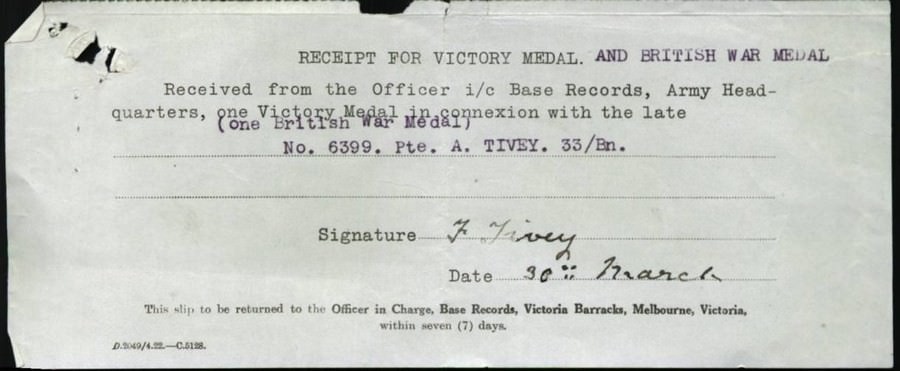
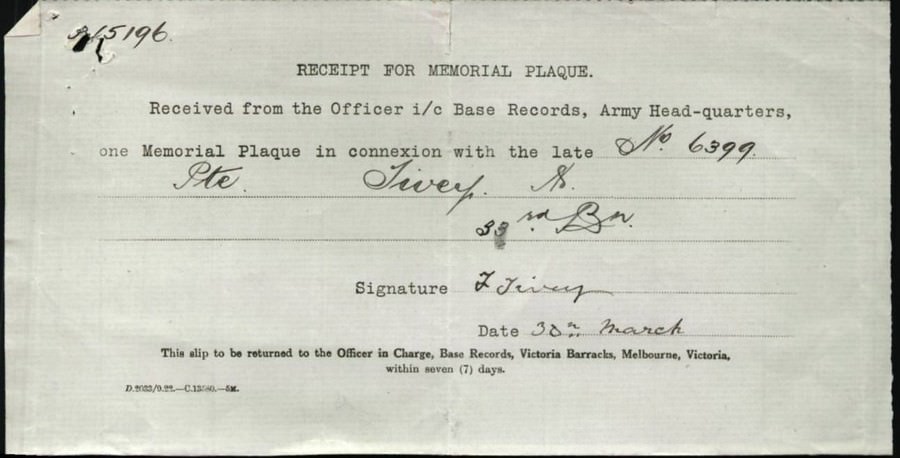

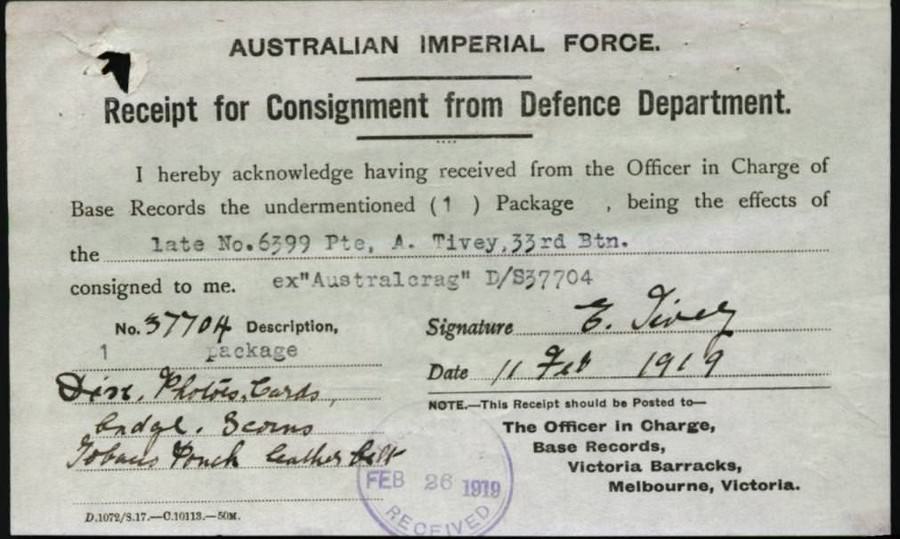
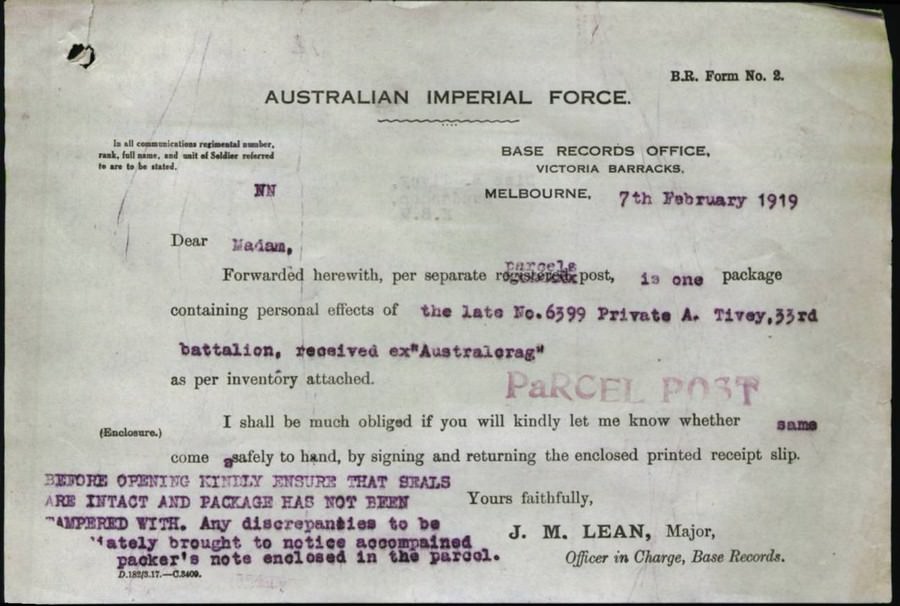
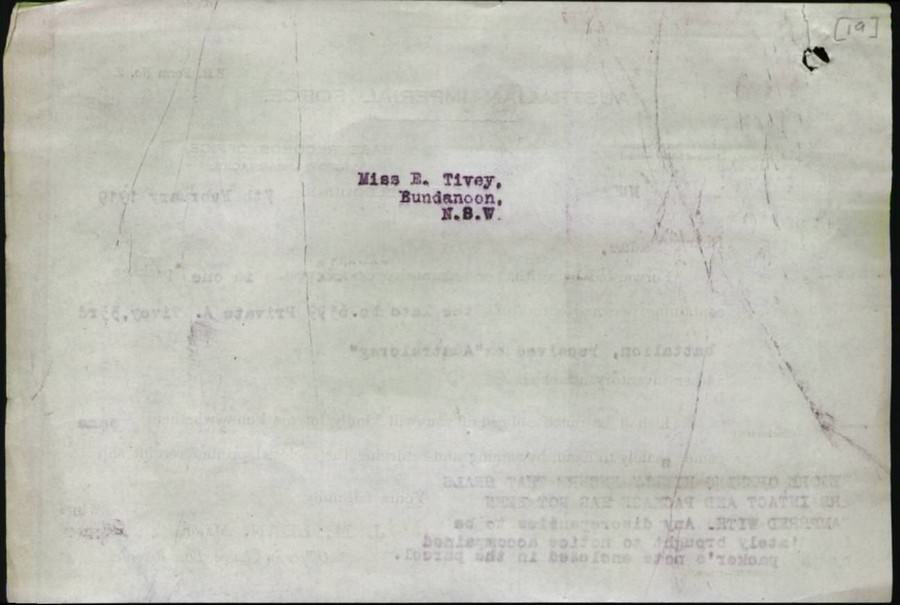

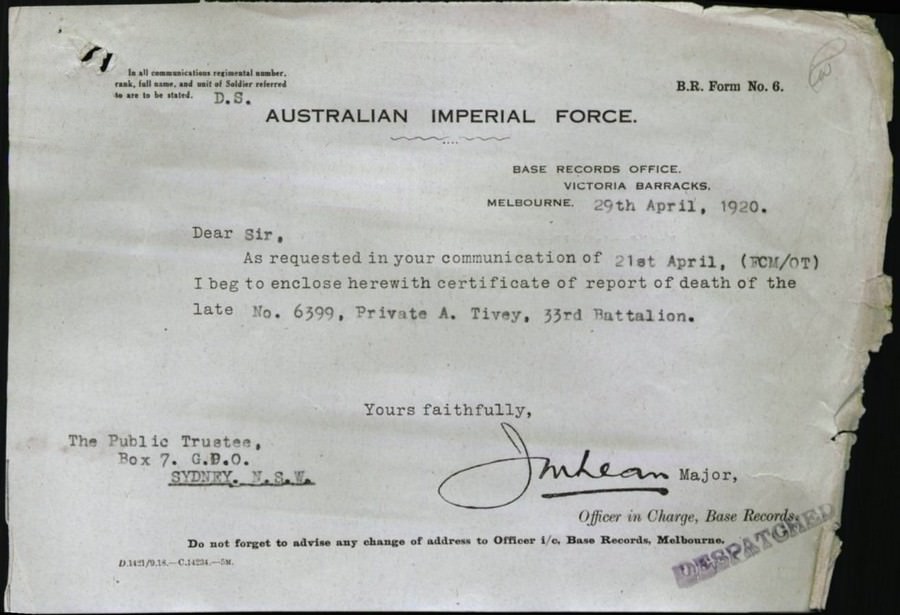


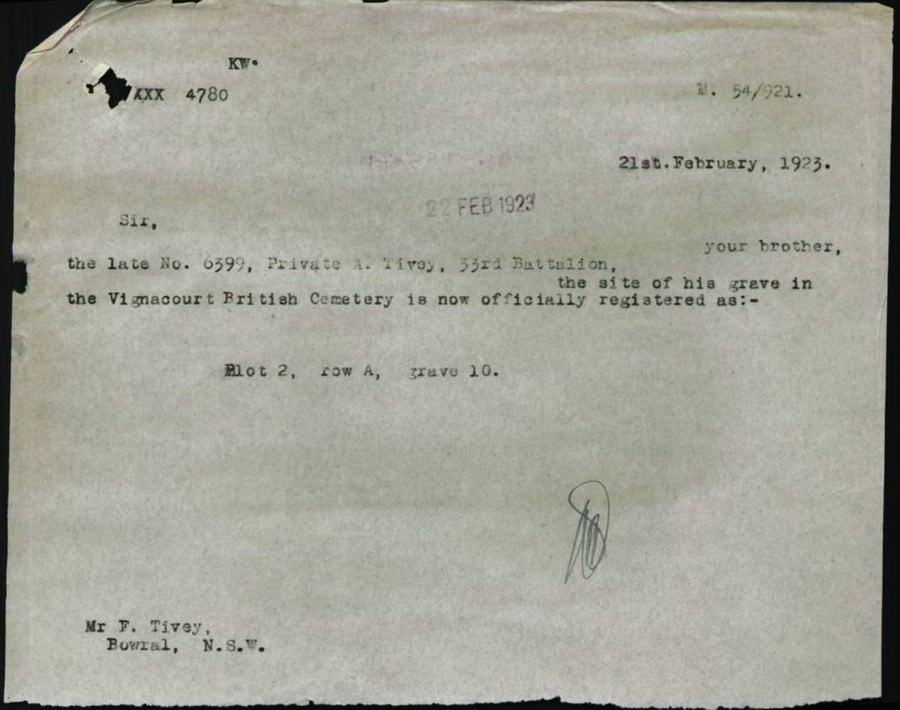

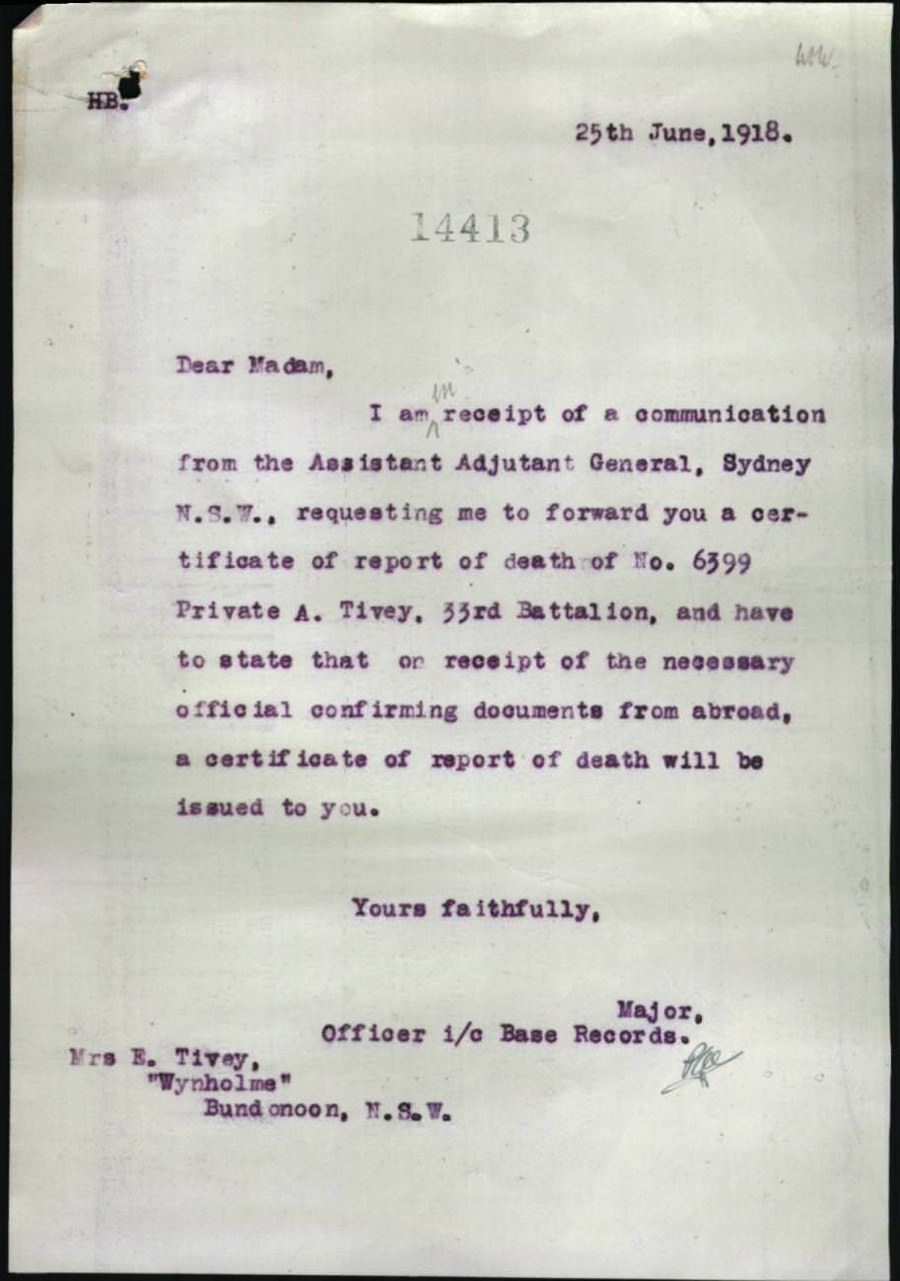
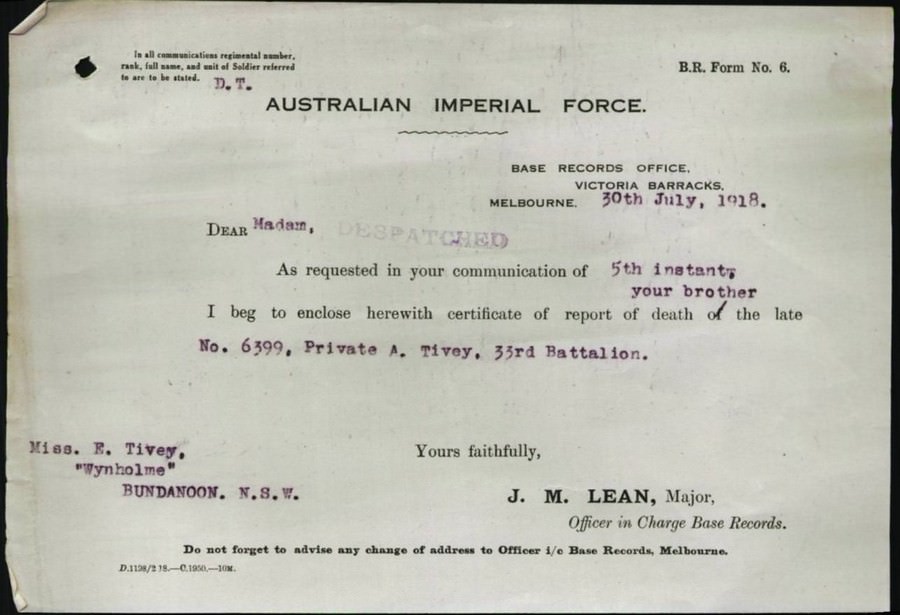
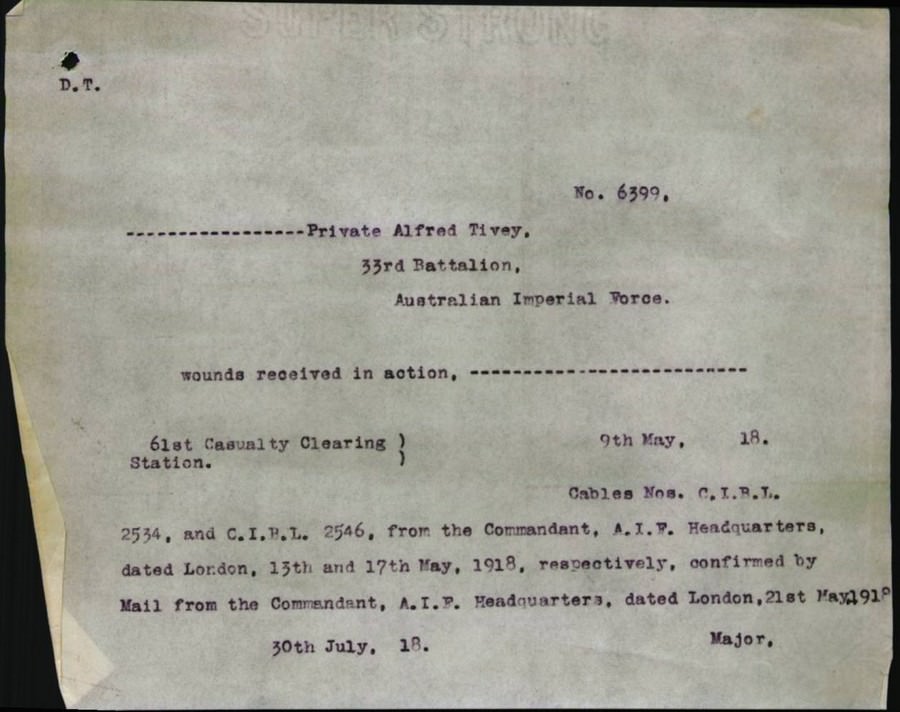
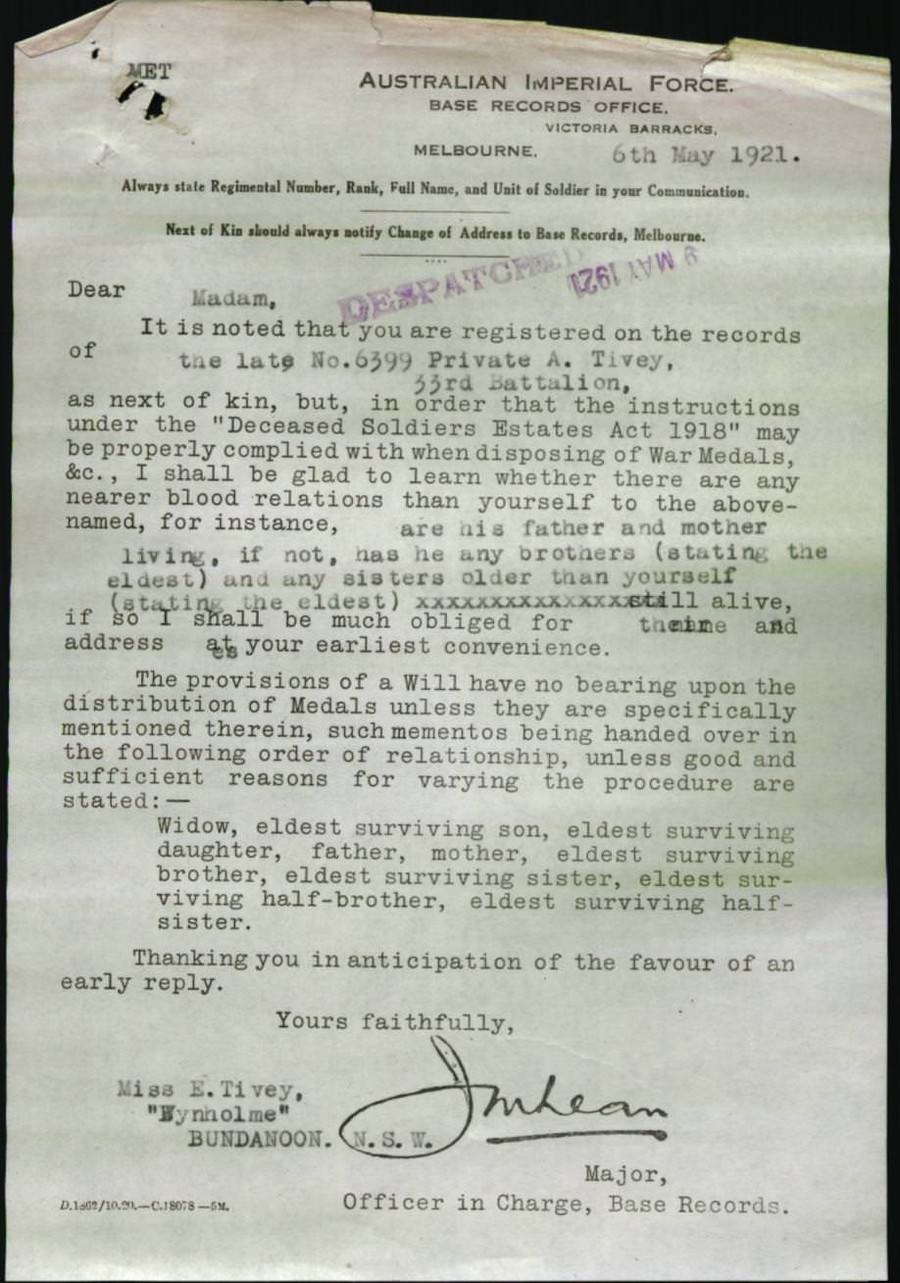
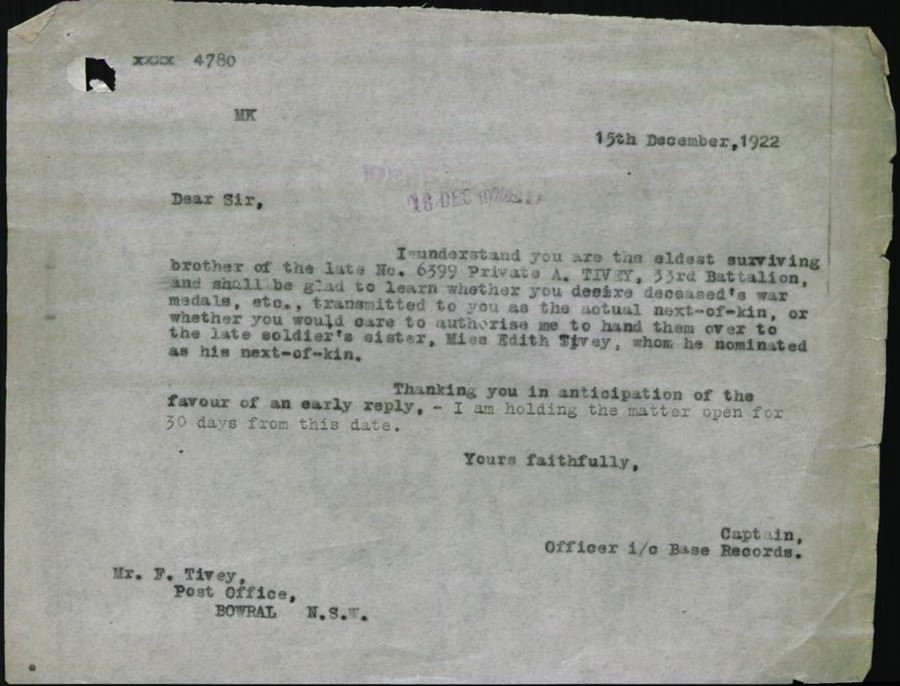
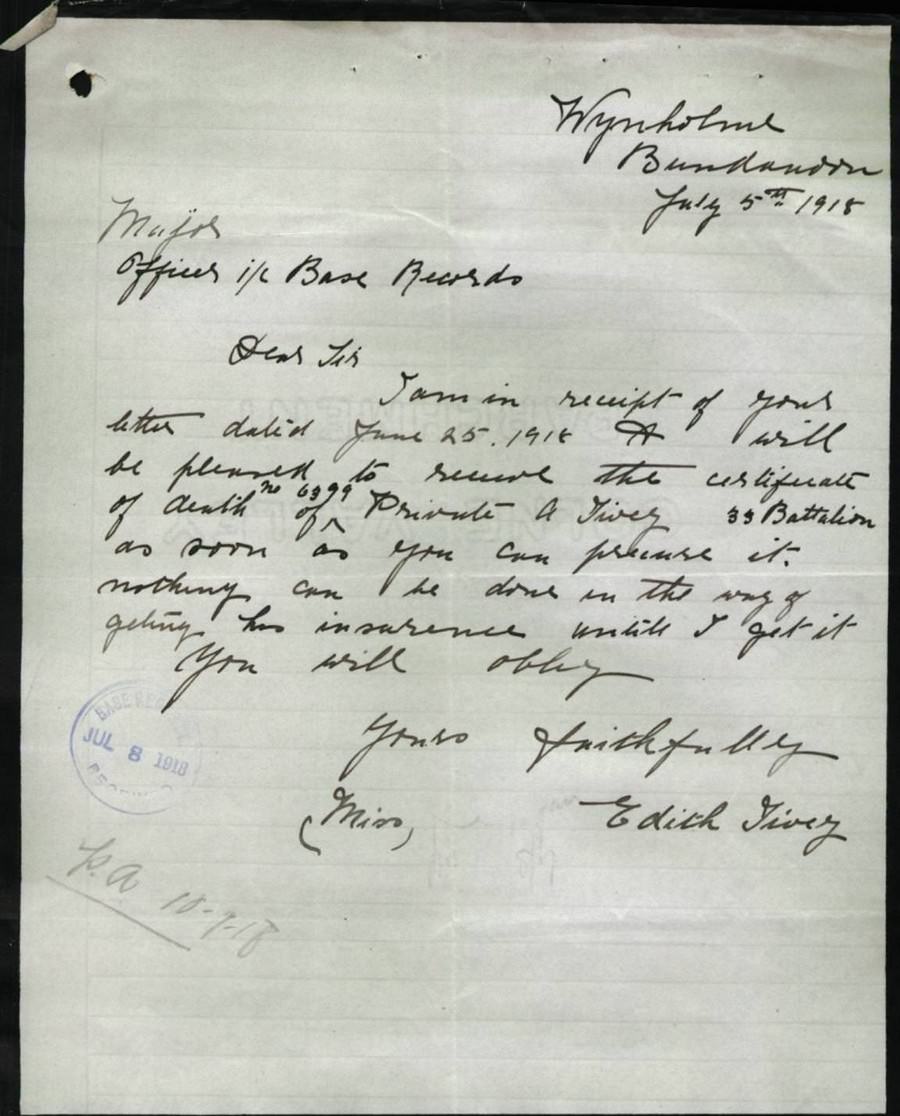

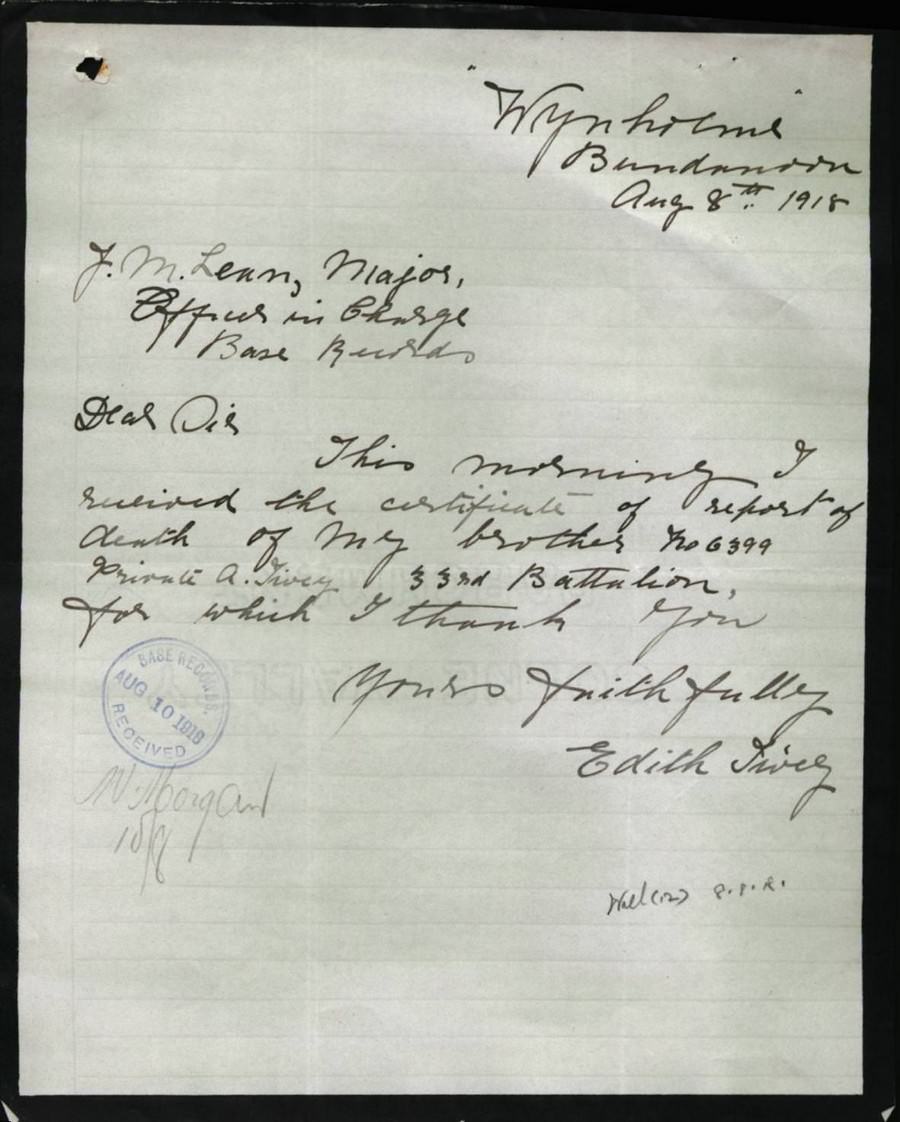
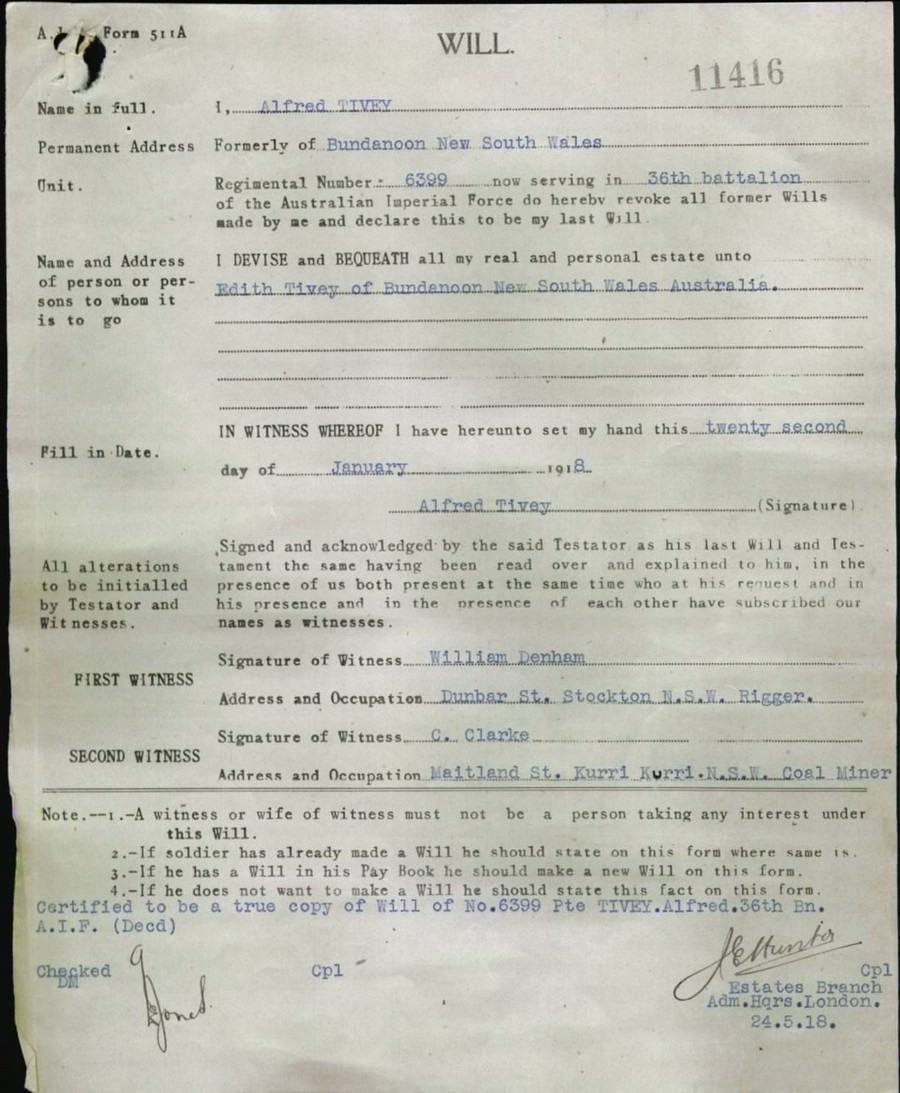

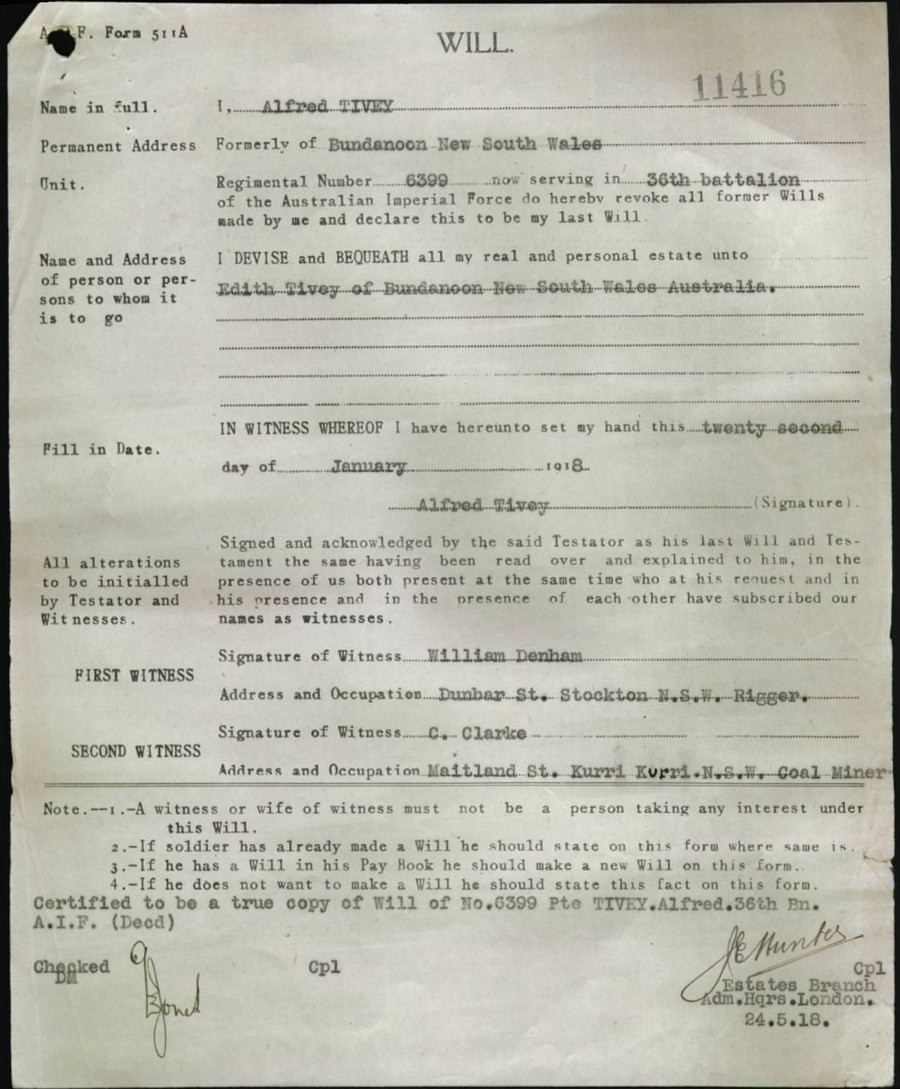

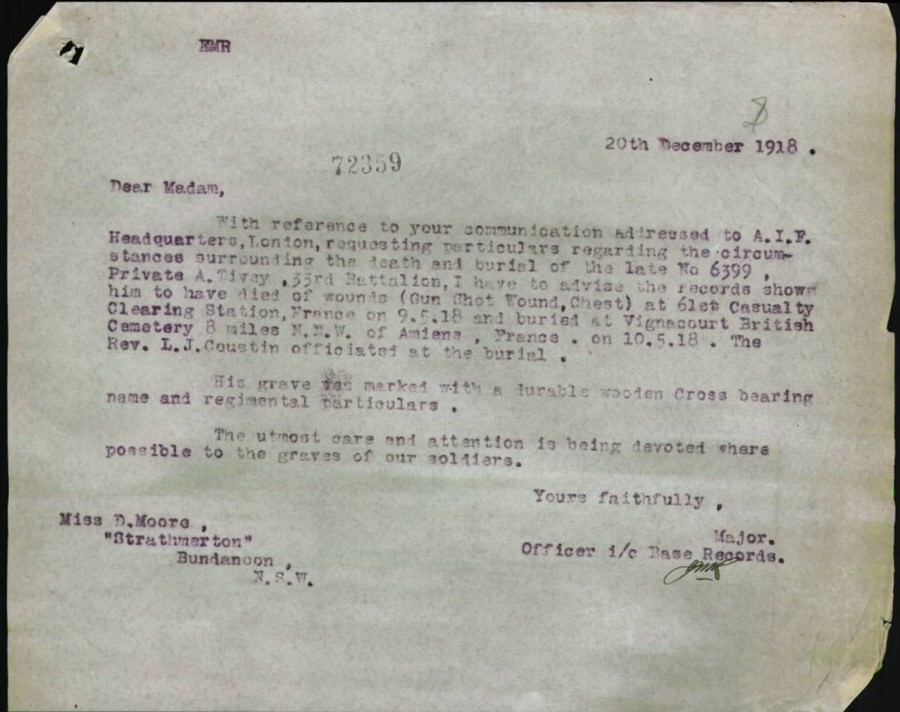
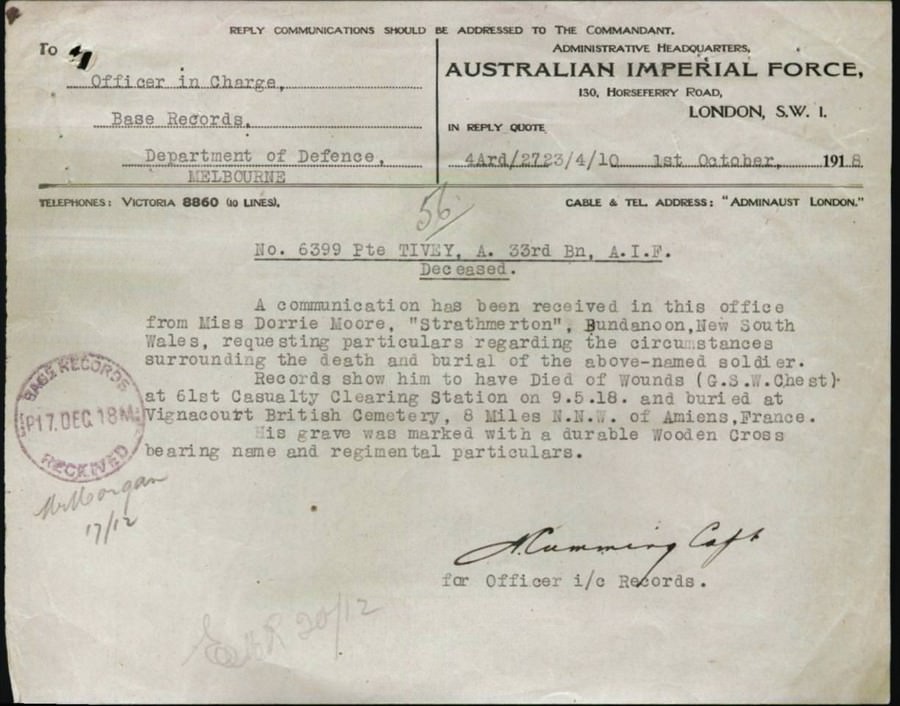


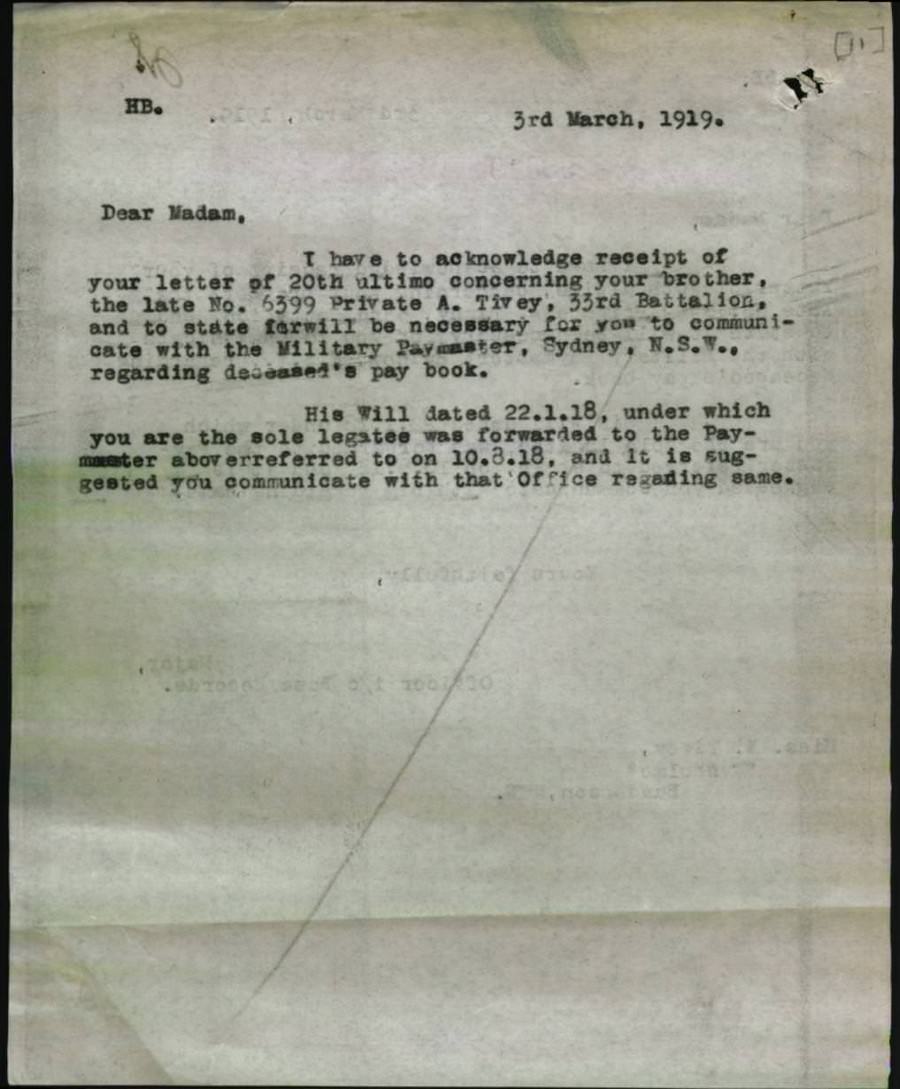
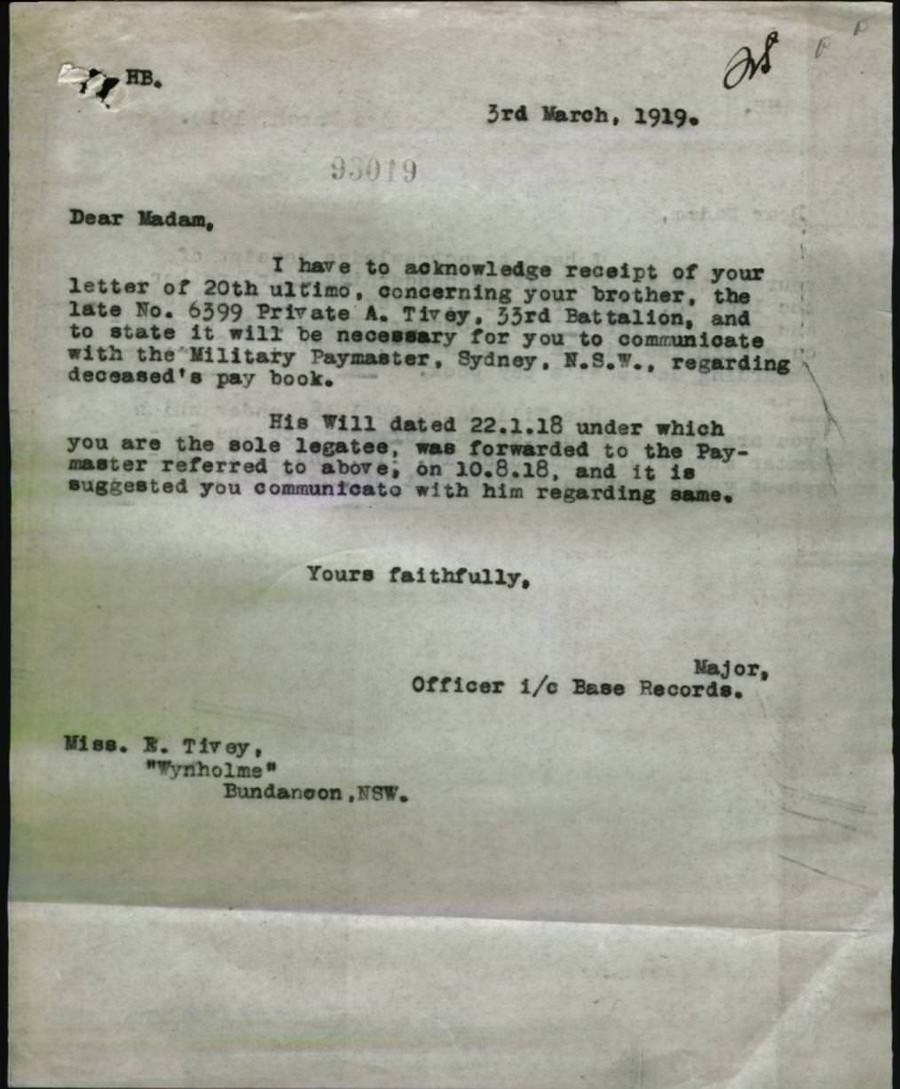

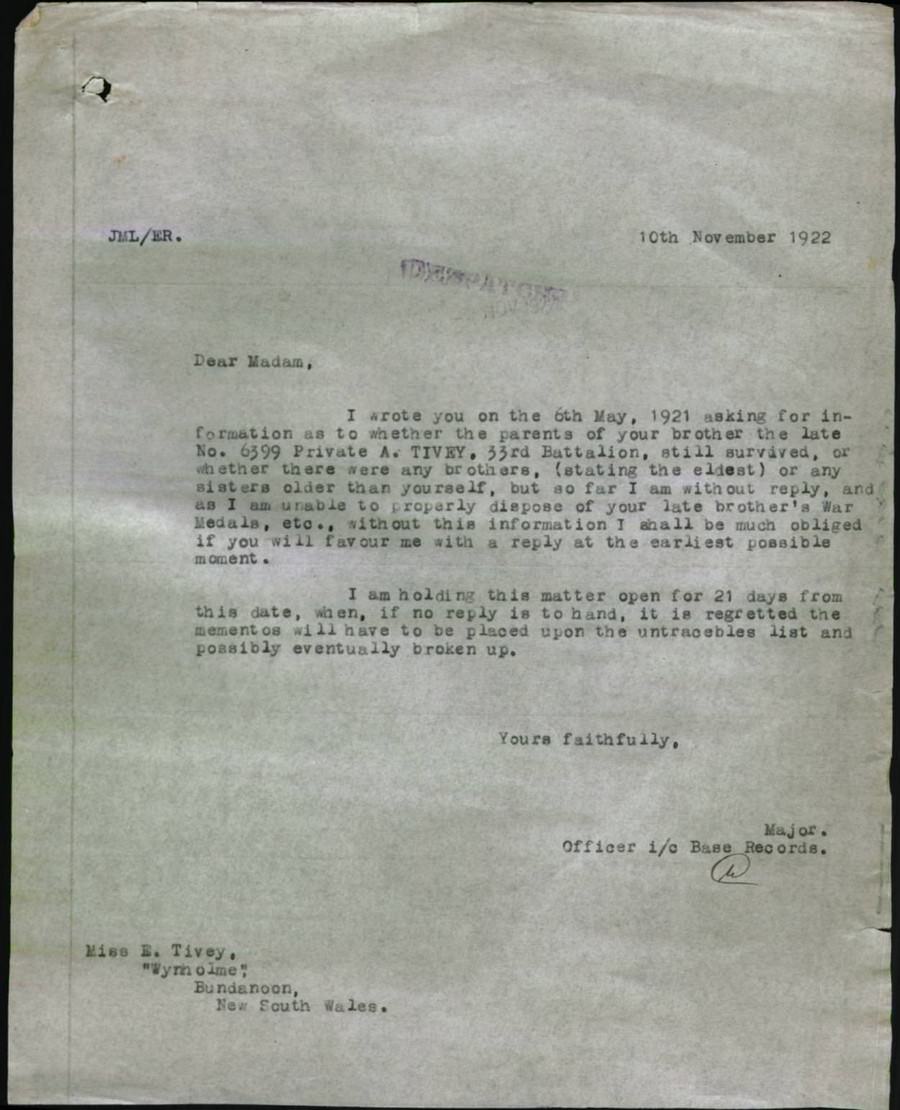
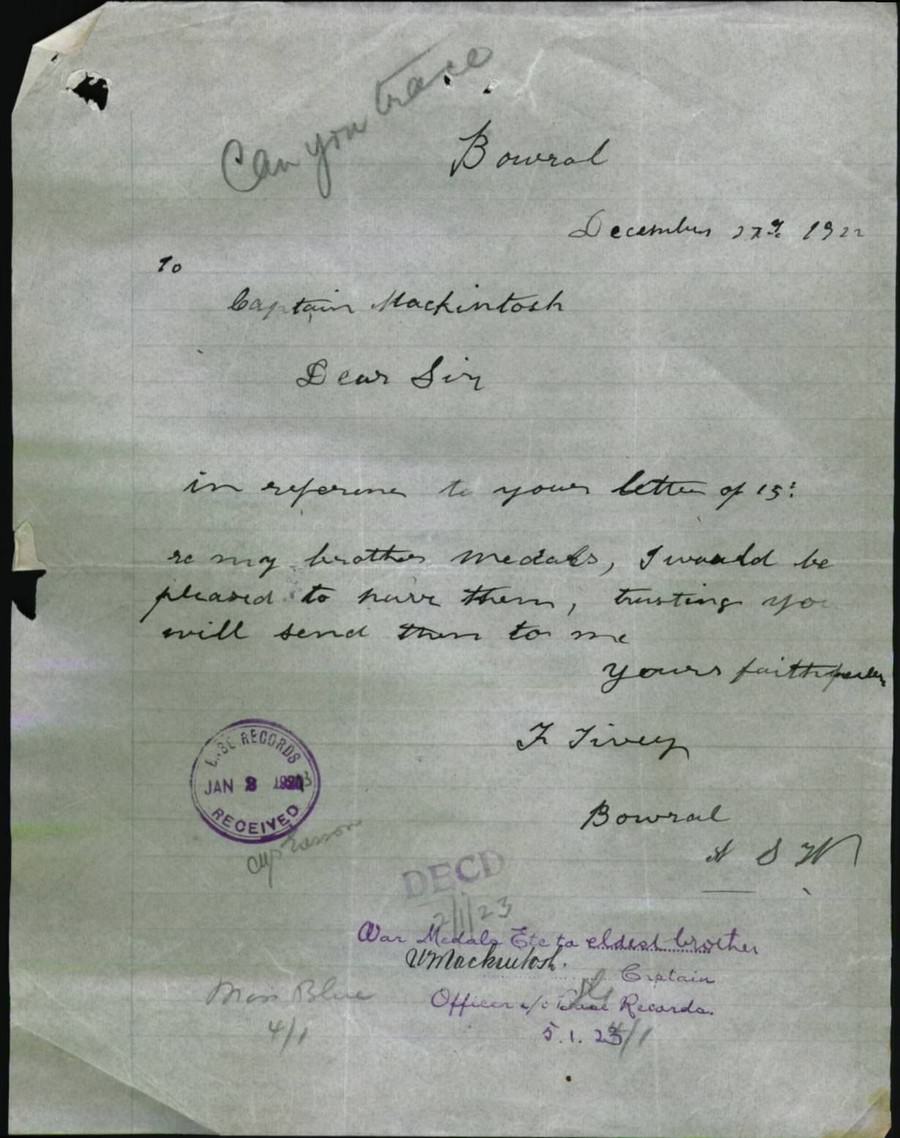
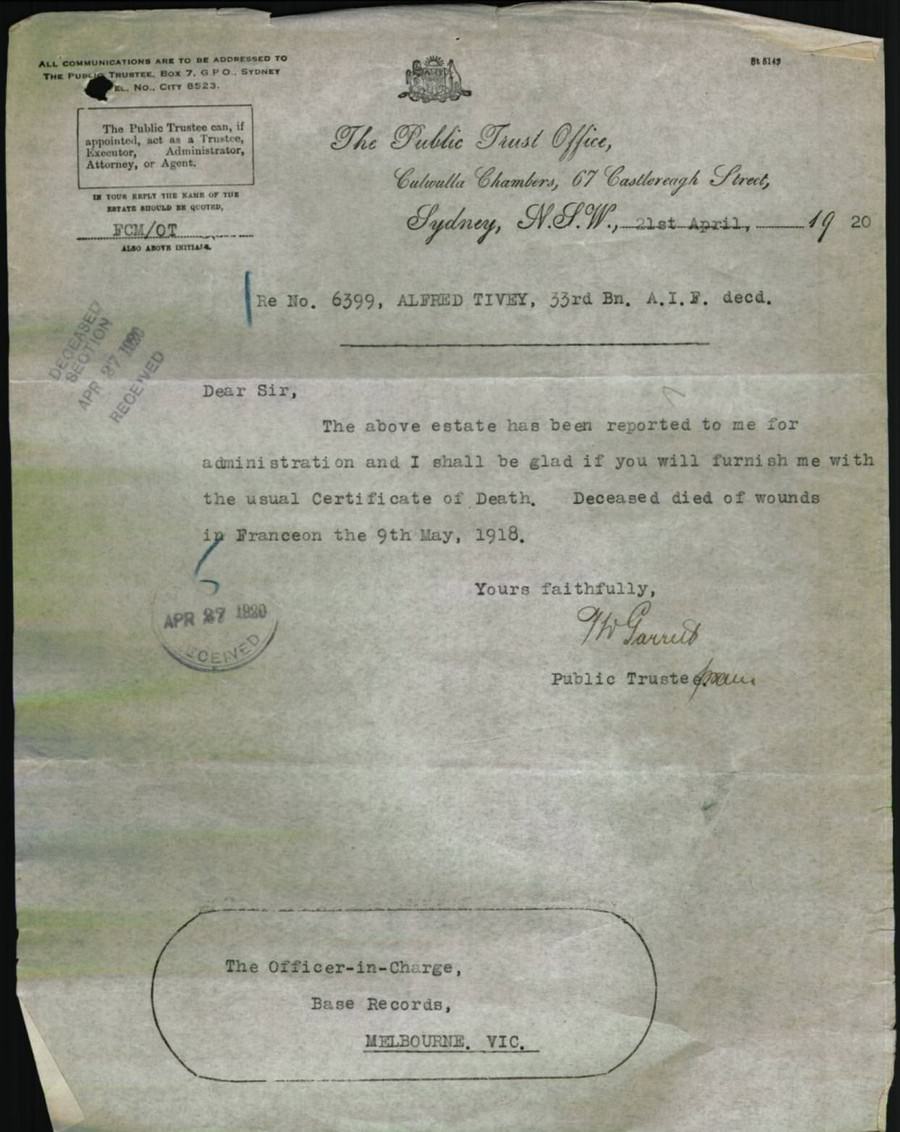
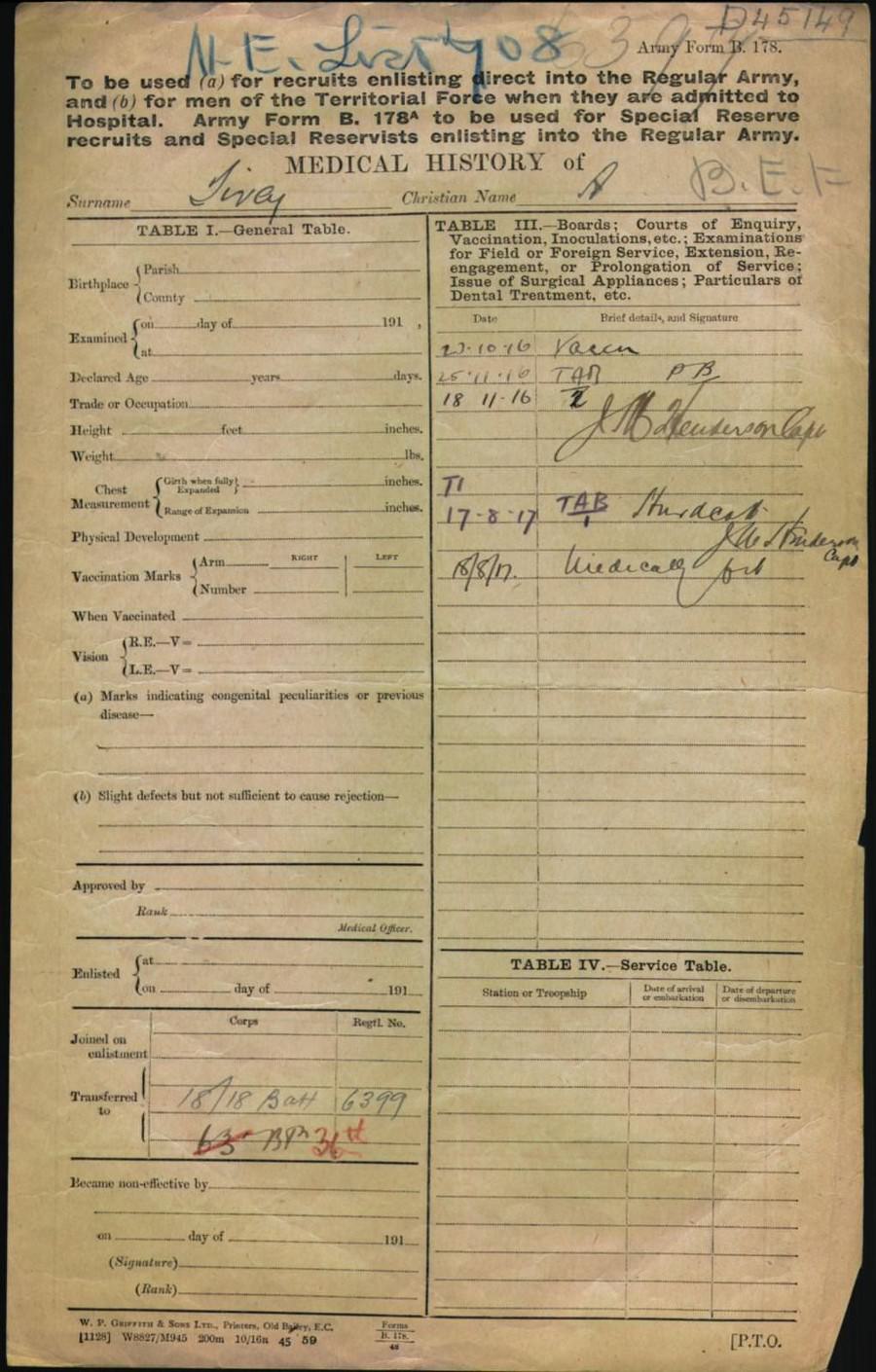

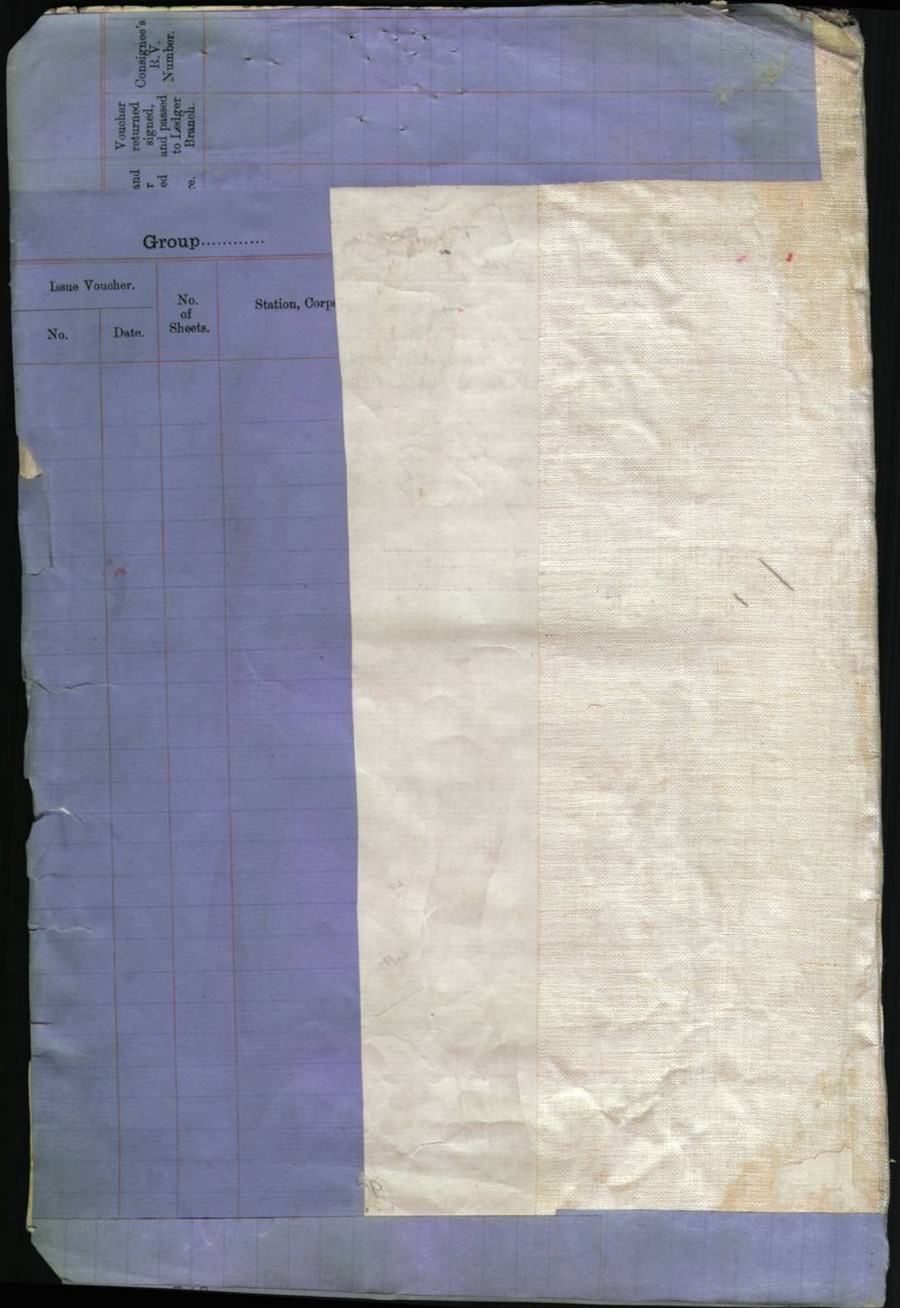
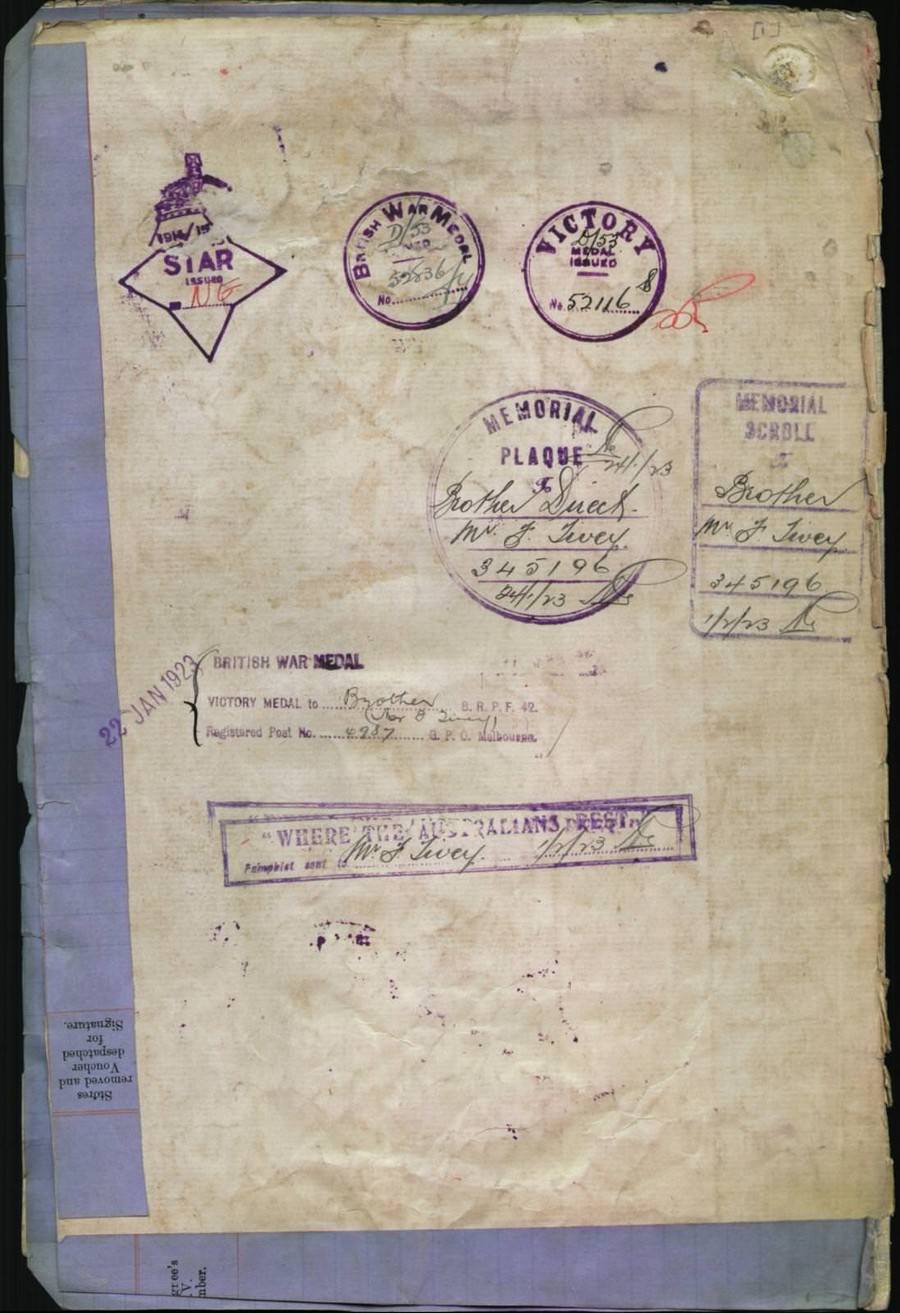 © Commonwealth of Australia (National Archives of Australia)
© Commonwealth of Australia (National Archives of Australia)
Under Construction; 17/11/2010-07/03/2022.
